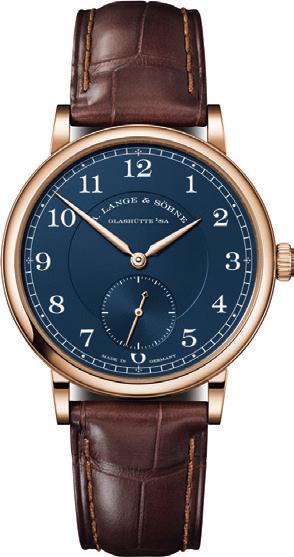

CONCOURS ELEGANCE OF

THE CHAMPIONS
SCHUMACHER AND F1 LEGENDS
VOLLSTÄNDIG OHNE MINDESTPREIS ANGEBOTEN

23. - 29./30. JULI 2025
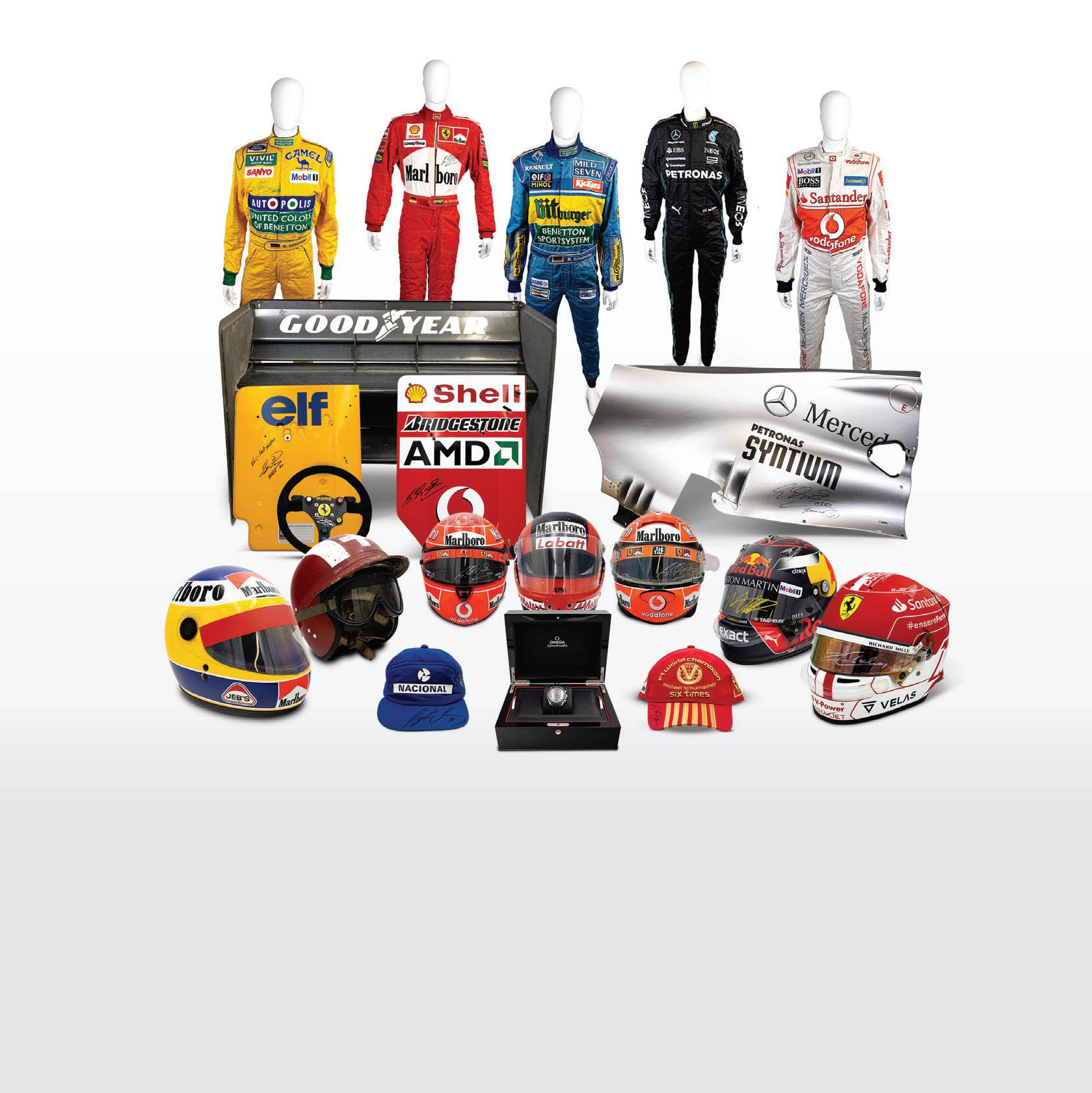







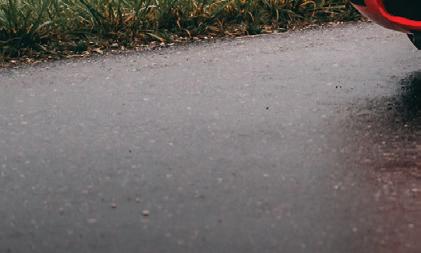




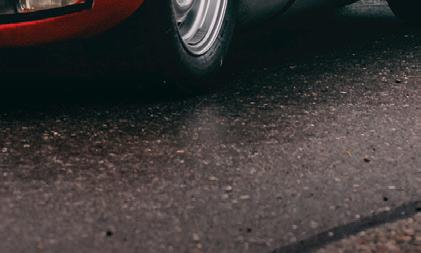









THE
INTELLIGENT ALTERNATIVE FOR FERRARIS OF YESTERDAY, TODAY AND TOMORROW
An Excellent Investment
THE INTELLIGENT ALTERNATIVE
FOR FERRARIS OF YESTERDAY, TODAY AND TOMORROW
Ferrari Financial Services has a range of tailored products designed to celebrate the heritage of all classic Ferraris.
An Excellent Investment
Ferrari Financial Services has a range of tailored products designed to celebrate the heritage of all classic Ferraris.
With the specialist skills required to care for and maintain these legendary models, Ferrari Financial Services is the ideal finance partner.
With the specialist skills required to care for and maintain these legendary models, Ferrari Financial Services is the ideal finance partner.
Whether you’re looking to make a new purchase or release equity, we offer finance programmes designed to offer you the flexibility to grow and enhance your collection of Ferraris.
Contact our team today to discuss your next Ferrari purchase.
Whether you’re looking to make a new purchase or release equity, we offer finance programmes designed to offer you the flexibility to grow and enhance your collection of Ferraris.
Field Manager North Germany
Field Manager South Germany
Steven McLaren
Field Manager North Germany
Field Manager South Germany
Nick Simmons
Kevin Briggs
Contact our team today to discuss your next Ferrari purchase.
+44(0)7739 035782 steven.mclaren@ferrari.com
Steven McLaren
Field Manager North Germany
Marco Kull 0173 74 86 829 Marco.kull@ferrari.com
Marco Kull 0173 74 86 829 marco.kull@ferrari.com
Christoph Erhart 0173 622 96 92 christoph.erhart@ferrari.com
+44(0)7500 074390 kevin.briggs@ferrari.com
+44 (0)7887 724992 nick.simmons@ferrari.com
+44(0)7739 035782 steven.mclaren@ferrari.com
Marco Kull 0173 74 86 829 Marco.kull@ferrari.com
Ferrari Financial Services GmbH
Christoph Erhart 0173 622 96 92 Christoph.erhart@ferrari.com
Kevin Briggs
Field Manager South Germany
Nick Simmons
+44(0)7500 074390
kevin.briggs@ferrari.com
Christoph Erhart 0173 622 96 92
Christoph.erhart@ferrari.com
+44 (0)7887 724992
Ferrari Financial Services GmbH bietet individuelle, auf Ihre Bedürfnisse zugeschnittene Produkte. Dazu zählen auch spezielle Lösungen für Classic Cars - sowohl beim Erwerb eines Fahrzeuges als auch zur Liquiditätsschaffung aus einer bereits bestehenden Fahrzeugsammlung. Kontaktieren Sie unser Team noch heute, um sich von einem unserer Ansprechpartner persönlich beraten zu lassen.
Ferrari Financial Services GmbH bietet individuelle, auf Ihre Bedürfnisse zugeschnittene Produkte. Dazu zählen auch spezielle Lösungen für Classic Cars – sowohl beim Erwerb eines Fahrzeuges als auch zur Liquiditätsschaffung aus einer bereits bestehenden Fahrzeugsammlung. Kontaktieren Sie unserTeam noch heute, um sich von einem unsererAnsprechpartner persönlich beraten zu lassen.
nick.simmons@ferrari.com
Ferrari Financial Services GmbH bietet individuelle, auf Ihre Bedürfnisse zugeschnittene Produkte. Dazu zählen auch spezielle Lösungen für Classic Cars - sowohl beim Erwerb eines Fahrzeuges als auch zur Liquiditätsschaffung aus einer bereits bestehenden Fahrzeugsammlung. Kontaktieren Sie unser Team noch heute, um sich von einem unserer Ansprechpartner persönlich beraten zu lassen.
275 Leigh Road, Slough Berkshire, SL1 4HF www.ferrarifinancialservices.com
Ferrari Financial Services GmbH
275 Leigh Road, Slough Berkshire, SL1 4HF www.ferrarifinancialservices.com


Welcome/Willkommen
DEAR LADIES AND GENTLEMEN, ON BEHALF OF
A. Lange & Söhne, I would like to welcome you to the Concours of Elegance Germany 2025. Following a successful premiere last year, it is a pleasure for us to once again be able to support this special event in our manufacture’s home country, which is known for its automotive passion. I am particularly delighted to be presenting the awards for the Best of Show and Emerging Collectors categories. With these awards, we honour the competition participants’ passionate commitment to preserving classic automobiles as a valuable cultural asset for future generations, while also highlighting our appreciation for outstanding engineering, exceptional craftsmanship and timeless elegance – qualities that also characterise the mechanical masterpieces from A. Lange & Söhne.
I invite you to discover the unique art of A. Lange & Söhne’s fine watchmaking here in the exceptional setting of Gut Kaltenbrunn. A carefully curated selection of timepieces welcomes you on a journey of discovery into the world of our manufacture, which is defined by the philosophy to “never stand still”.
This Concours impressively demonstrates that the world of automobiles has never stood still, either. I wish you an enjoyable time!
SEHR GEEHRTE DAMEN UND HERREN, IM NAMEN VON A. Lange & Söhne heiße ich Sie herzlich willkommen zum Concours of Elegance Germany 2025. Nach einer erfolgreichen Premiere im vergangenen Jahr ist es uns eine Freude, diese besondere Veranstaltung im Heimatland unserer Manufaktur, das für seine automobile Leidenschaft bekannt ist, erneut begleiten zu dürfen.
Ich freue mich ganz besonders, die Preise für die Kategorien „Best of Show“ und „Emerging Collectors” verleihen dürfen.
Mit diesen Auszeichnungen würdigen wir das leidenschaftliche Engagement der Wettbewerbsteilnehmenden, klassische Automobile als kostbares Kulturgut für kommende Generationen zu erhalten. Zugleich bringen wir unsere Wertschätzung für herausragende Ingenieurskunst, handwerkliche Exzellenz und zeitlose Eleganz zum Ausdruck – Eigenschaften, die auch die mechanischen Meisterwerke von A. Lange & Söhne kennzeichnen.
Ich lade Sie herzlich ein, die Besonderheiten der Uhrmacherkunst von A. Lange & Söhne hier im einzigartigen Ambiente auf dem Gut Kaltenbrunn kennenzulernen. Eine sorgfältig kuratierte Auswahl von Zeitmessern ermöglicht eine Entdeckungsreise in die Welt unserer Manufaktur, die dem Anspruch folgt „niemals stehen zu bleiben“.
Dass auch die Welt der Automobile niemals stehen geblieben ist, wird auf diesem Concours eindrucksvoll unter Beweis gestellt.
Ich wünsche Ihnen eine angenehme Zeit!
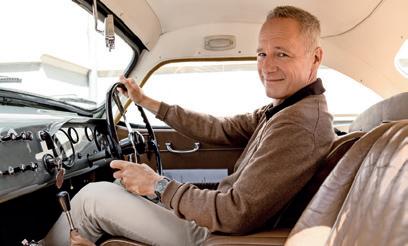
Wilhelm Schmid CEO, A. LANGE & SÖHNE
Welcome/Willkommen
DEAR GUESTS, WE ARE DELIGHTED TO WELCOME you to the second edition of the Concours of Elegance Germany on the shores of Lake Tegernsee.
Just like last year, we come together to celebrate the highlights of automotive culture, engineering excellence and design history. Gut Kaltenbrunn offers the perfect setting for this occasion – a place so picturesque that even the Alps seem to peek through the morning clouds in awe. And there is truly much to discover at this year’s Concours of Elegance Germany.
Our Selection Committee, made up of experts in their fields, has carefully curated a breathtaking line-up. The most beautiful, impressive and elegant automobiles from many decades are competing for class wins and the coveted Best of Show trophy. As in previous years, the winners will be chosen by the participants themselves. It fills us with joy and pride to celebrate and carry forward this wonderful tradition in the birthplace of the automobile.
My sincere thanks go to all participants and guests, to our partners, and especially to the team behind the Concours of Elegance Germany for its dedication. Without all of you, our beauty contest for automobiles would not be possible.
I look forward to a weekend filled with extraordinary automotive stories and memorable encounters.
LIEBE
GÄSTE, WIR
FREUEN UNS SEHR, SIE ZUR ZWEITEN
Ausgabe des Concours of Elegance Germany am Ufer des Tegernsees begrüßen zu dürfen. Wie schon im vergangenen Jahr kommen wir zusammen, um die Höhepunkte der Automobilkultur, technische Meisterleistungen und Designgeschichte zu feiern.
Gut Kaltenbrunn bietet hierfür die perfekte Kulisse – ein Ort, so malerisch, dass selbst die Alpen am Morgen ehrfürchtig durch die Wolken blicken. Und beim diesjährigen Concours of Elegance Germany gibt es wahrlich viel zu entdecken.
Unser Selection Committee, bestehend aus ausgewiesenen Experten, hat mit größter Sorgfalt ein atemberaubendes Teilnehmerfeld zusammengestellt. Die schönsten, eindrucksvollsten und elegantesten Automobile aus mehreren Jahrzehnten bewerben sich um Klassensiege und die begehrte Best of Show-Trophäe. Wie auch in den Vorjahren werden die Sieger von den Teilnehmern selbst gewählt. Es erfüllt uns mit großer Freude und Stolz, diese wunderbare Tradition im Mutterland des Automobils zu feiern und weiterzuführen.
Mein herzlicher Dank gilt allen Teilnehmern und Gästen, unseren Partnern – und ganz besonders dem Team hinter dem Concours of Elegance Germany für sein unermüdliches Engagement. Ohne Sie alle wäre unser „Schönheitswettbewerb für Automobile“ nicht möglich.
Ich freue mich auf ein Wochenende voller außergewöhnlicher Automobilgeschichten und unvergesslicher Begegnungen.

JP Rathgen HONORARY CONCOURS DIRECTOR

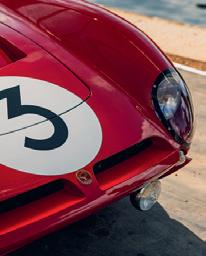

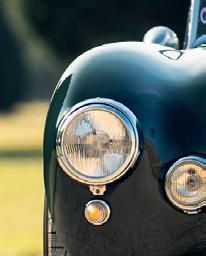
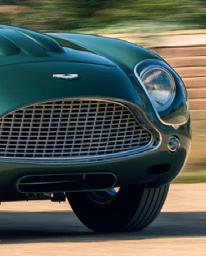
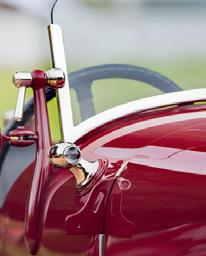
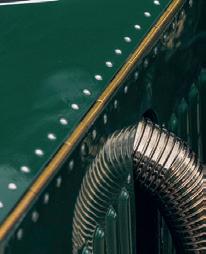



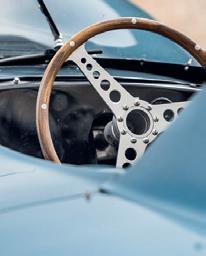

CONCOURS OF ELEGANCE
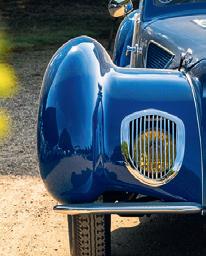
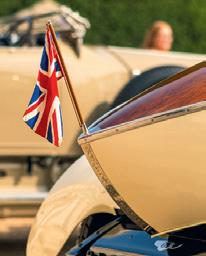

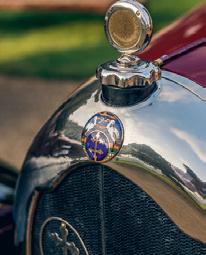


THE RAREST CARS IN THE WORLD
HAMPTON COURT PALACE | 5–7 SEPTEMBER 2025
PRESENTING PARTNER

The Concours of Elegance Germany is organised by

Thorough Events GmbH Ludwigstr. 73, 84524 Neuötting, Germany +44 7884043600
wwwconcoursofelegance germany.com
Programme published by:
Hothouse Media Ltd
Castle Cottage, 25 High Street, Titchmarsh, Northants NN14 3DF, UK www.hothousemedia.co.uk
Managing Director Geoff Love
Editorial Director David Lillywhite
Advertising Directors
Sue Farrow, Rob Schulp
Art Director Peter Allen
Managing Editor Sarah Bradley
Art Editor Debbie Nolan
Cover Illustrator Amir Mirzaei
Contributors Nathan Chadwick, CharlieB, Thomas Imhof
Printed by Silber Druck
GmbH & Co. KG, Germany
Thanks to...
Master of Ceremonies and Chairman of the Steering Committee Richard Charlesworth
Honorary Concours Director JP Rathgen
Tour Director Christian Geistdörfer
Curators Vanessa Marçais and Flavien Marçais
Thorough Events: CEO James Brooks-Ward, Sascha Aberle, Bianca Lienau, Sonja Hornig, Andrew Evans, Iain Campbell, Alice Young, Rebecca Achenbach, Gilli Cuthbert
Influence PR: Sam Petters, Aileen Lekschat, Jess Leimanis
Disco PR: Dominik Hoberg, Ines-Julia Schniewind, Jaqueline Durst, Christoph Kragenings
Photo and Video Production: Miriam Mayer
Photography, Fireflyt Video Production, Tim Scott at Fluid Images, Harry Henry
Great care has been taken throughout this programme to be accurate, but the publisher cannot accept any responsibility for any errors or omissions that might occur.
The editors and publishers of this programme give no warranties, guarantees or assurances, and make no representations regarding any goods or services advertised in this edition.
Copyright © Thorough Events and Hothouse Media 2025. All rights reserved.
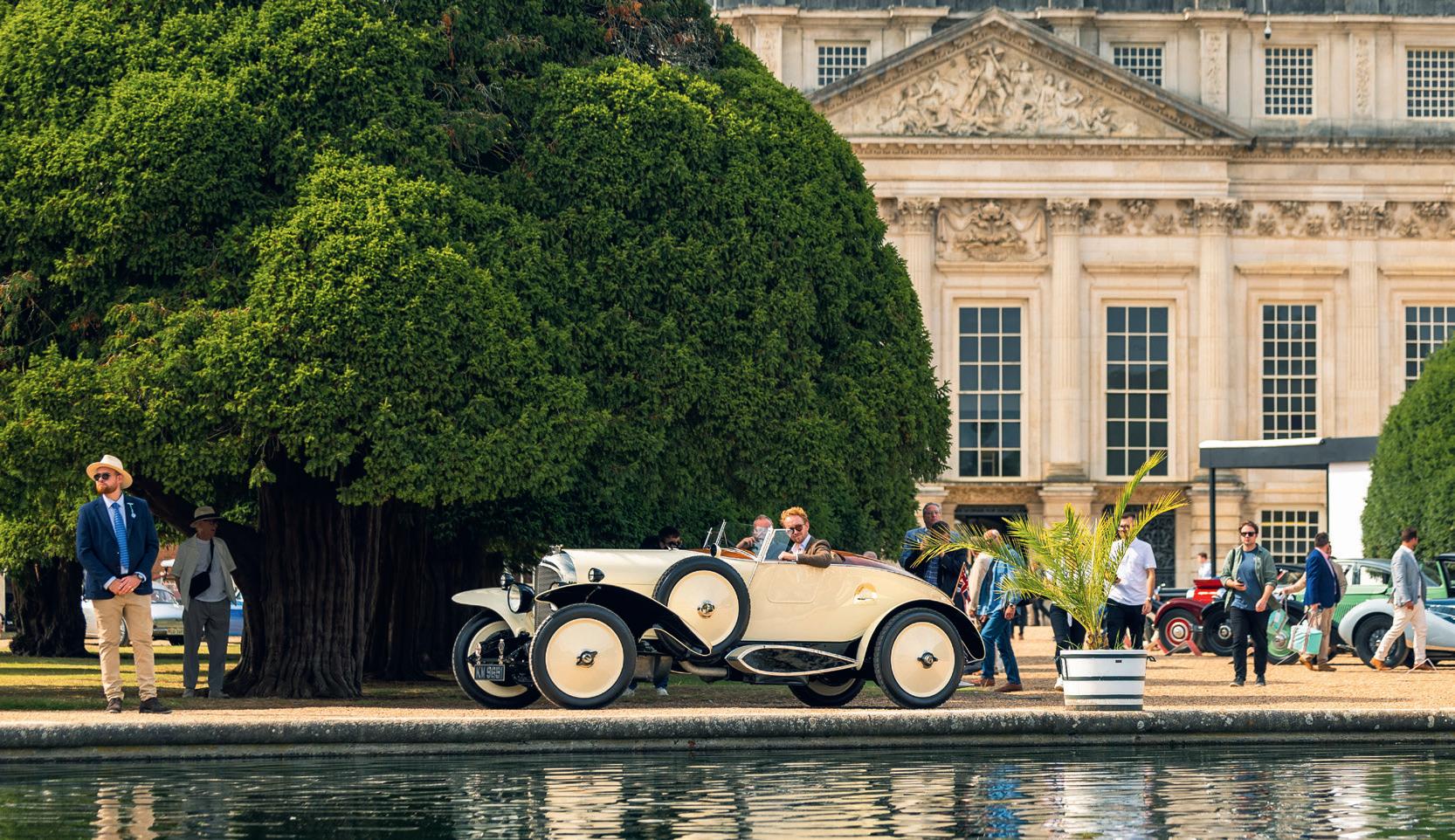
Meet Thorough Events
THOROUGH EVENTS
Ltd is the leading organiser of world-class concours events, known for curating experiences that combine automotive excellence with refined hospitality, design and culture. The company launched its first concours in 2012 within the walls of Windsor Castle, with the gracious support of the Royal Household.
Following Windsor, the event continued its royal tradition with editions held at St James’s Palace and
Palace of Holyroodhouse, before establishing its permanent home at Hampton Court Palace. The Concours of Elegance at Hampton Court Palace is now one of the most prestigious collector car events in the world.
Thorough Events also organises the London Concours, an awardwinning event hosted at the Honourable Artillery Company in the City that combines automotive excellence with design,
fashion and lifestyle.
Thorough Events has now expanded its portfolio with two international editions: the Concours of Elegance Germany and the new-for-2025 Royal Bahrain Concours, to be held on November 7-8. Both locations reflect the company’s global vision while maintaining its long-held DNA: celebrating the world’s most significant, leading car collectors and beautiful cars in exceptional settings.
The Concours of Elegance at Hampton Court Palace and the London Concours are established gatherings from Thorough Events.
Der Concours of Elegance im Hampton Court Palace und der London Concours gehören zu den etablierten Formaten von Thorough Events.

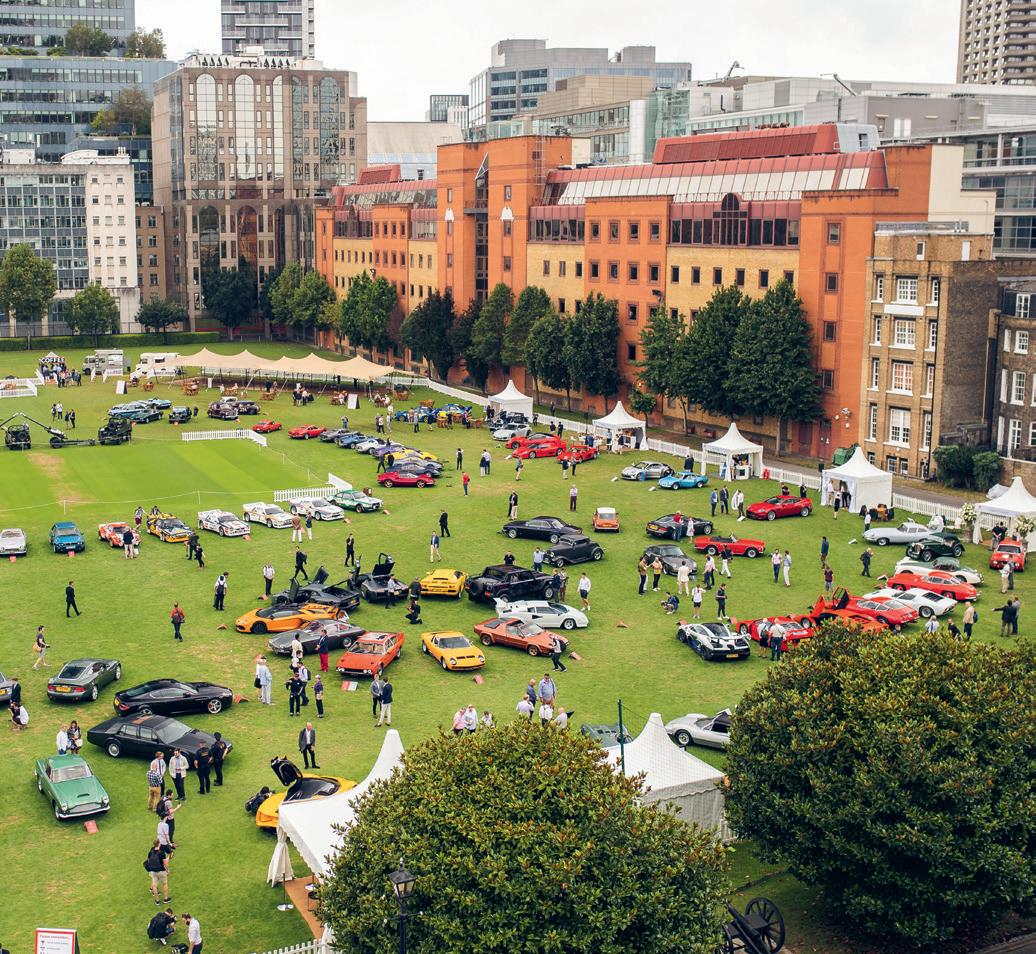

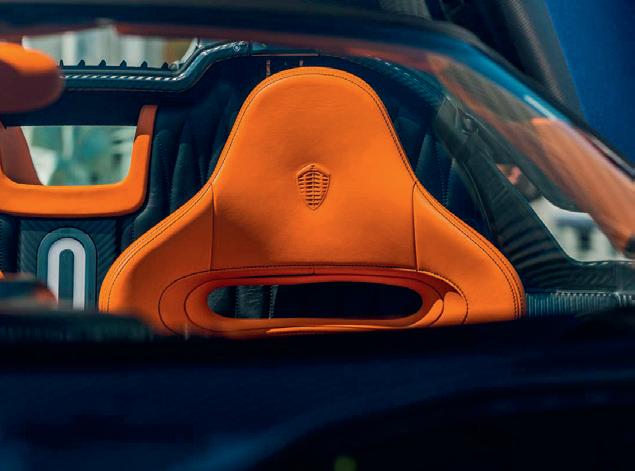
THOROUGH EVENTS
Ltd ist der führende Veranstalter von ConcoursEvents auf WeltklasseNiveau und bekannt für Erlebnisse, die automobilen Spitzenstandard mit erstklassiger Gastfreundschaft, Design und Kultur verbinden. Das Unternehmen lancierte seinen ersten Concours im Jahr 2012 innerhalb der Mauern von Windsor Castle – mit der großzügigen Unterstützung des britischen Königshauses.
Nach der Premiere in Windsor setzte das Event seine königliche Tradition mit Ausgaben im St James’s Palace und im Palace of Holyroodhouse fort, bevor es seinen festen Veranstaltungsort im Hampton Court Palace fand. Der Concours of Elegance im Hampton Court Palace zählt heute zu den renommiertesten ConcoursEvents weltweit. Zudem organisiert
Thorough Events den London Concours, eine preisgekrönte
Veranstaltung auf dem Gelände der Honourable Artillery Company im Herzen Londons, die automobile Exzellenz mit Design, Mode und Lifestyle verbindet. Mittlerweile hat Thorough Events sein Portfolio um zwei internationale Ausgaben erweitert: den Concours of Elegance Germany sowie den neu eingeführten Royal Bahrain Concours, der am 7. und 8. November 2025 stattfinden wird. Beide Austragungsorte spiegeln die
globale Vision des Unternehmens wider – bei gleichbleibender DNA: die bedeutendsten Fahrzeugsammler der Welt und außergewöhnlich schöne Fahrzeuge in herausragenden Kulissen zu feiern.


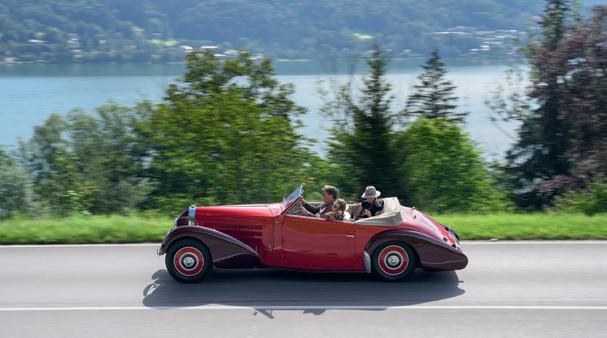

DIE ERSTE AUSGABE
des Concours of Elegance Germany, präsentiert von A. Lange & Söhne, markierte den Beginn einer neuen Ära für die Oldtimersammlerkultur auf dem europäischen Festland. Veranstaltet auf Gut Kaltenbrunn am malerischen Tegernsee, versammelte das Event 50 prachtvolle Fahrzeuge internationaler Sammler – kuratiert mit
Looking back at 2024’s event
THE INAUGURAL EDITION of the Concours of Elegance
Germany presented by A. Lange & Söhne marked a new era for collector car culture in continental Europe. Held at Gut Kaltenbrunn on picturesque Lake Tegernsee, it gathered 50 extraordinary cars from international collectors, curated with the same care and elegance as its British counterparts in London and at Hampton Court Palace. The setting offered an atmosphere of grandeur
and refinement. With exceptional hospitality and world-class entrants, the launch event set a new standard for concours in Germany. It is poised to become a landmark on the global concours calendar. A highlight was the presence of RM Sotheby’s, the world’s leading collector car auction house, which held a live auction. Meanwhile, guests admired presenting partner A. Lange & Söhne’s exquisite timepieces alongside the
The inaugural Concours of Elegance Germany in 2024 offered grandeur and refinement. Die erste Ausgabe des Concours of Elegance Germany im Jahr 2024 bot Eleganz und Raffinesse.
cars, while private clients enjoyed a watchmaking demonstration.
Alongside the concours, guests experienced a global luxury car show, with prestigious manufacturers showcasing new models. Complementing these were an elegant lifestyle offering from high-end exhibitors. Together, they created a vibrant, aspirational environment – seamlessly blending the worlds of heritage, design and automotive innovation.
derselben Sorgfalt und Eleganz wie seine britischen Pendants in London und am Hampton Court Palace. Die Kulisse bot eine Atmosphäre von Größe und Raffinesse. Der erste Concours of Elegance Germany im Jahr 2024 überzeugte durch außergewöhnliche Gastfreundschaft, hochkarätige Teilnehmer und ein Ambiente auf
Weltklasse-Niveau. Die Auftaktveranstaltung setzte neue Maßstäbe für Concours-Veranstaltungen in Deutschland und hat das Potenzial, sich als fester Termin im globalen ConcoursKalender zu etablieren.
Ein besonderes Highlight war die Live Auktion von RM Sotheby’s, dem weltweit führenden Auktionshaus für Sammlerfahrzeuge. Gäste bewunderten nicht nur die
außergewöhnlichen Fahrzeuge, sondern auch die feinen Zeitmesser von Präsentationspartner A. Lange & Söhne, während ausgewählte Kunden bei einer exklusiven Uhrmachervorführung Einblicke in die Handwerkskunst der Manufaktur erhielten. Parallel zum Concours erlebten Besucher eine internationale
Luxusautomobilausstellung, bei der renommierte Hersteller ihre neuesten Modelle präsentierten. Ergänzt wurde das Programm durch ein elegantes Lifestyle-Angebot ausgesuchter PremiumMarken. So entstand eine lebendige, inspirierende Atmosphäre – eine perfekte Verbindung aus Tradition, Design und automobiler Innovation.
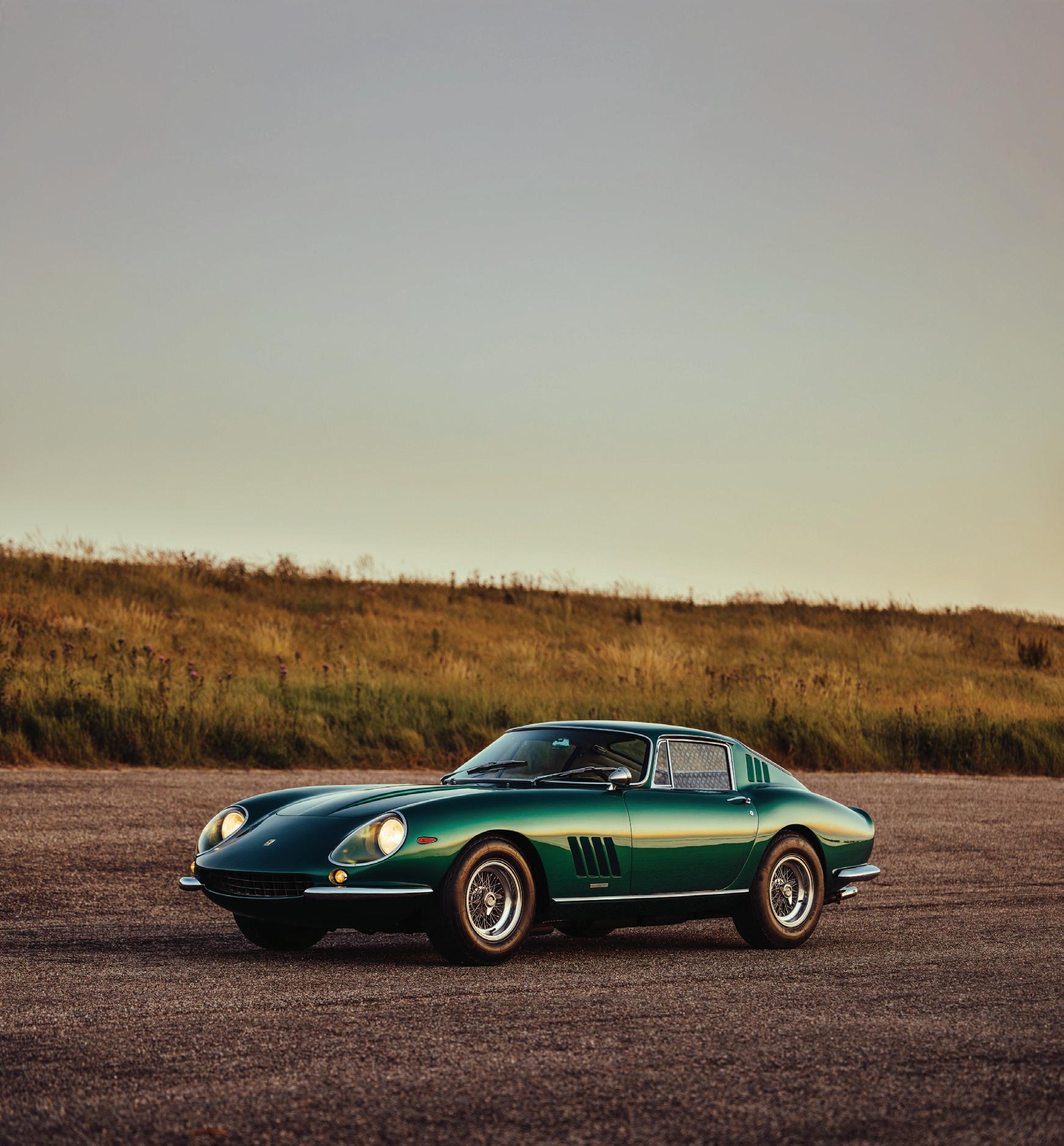





THE ZOUTE CONCOURS AUCTION
10 OCTOBER 2025 | APPROACH GOLF - KNOKKE-HEIST, BELGIUM
THE Z Ü RICH AUCTION
1 NOVEMBER 2025 | THE DOLDER GRAND - Z Ü RICH, SWITZERLAND

Gut Kaltenbrunn – stylish enjoyment with a view of Lake Tegernsee
Gut Kaltenbrunn is for connoisseurs who have a sense of quality, aesthetics and authenticity.
Gut Kaltenbrunn ist ein Ort für Kenner mit Gefühl für Qualität, Ästhetik und Authentizität.
HIGH ABOVE LAKE
Tegernsee, with an unobstructed view of the majestic Wallberg, lies Gut Kaltenbrunn – a place for connoisseurs who have a sense of quality, aesthetics and authenticity. The historic estate, which dates back to the 15th century, combines Bavarian heritage with modern culinary excellence at the very highest level.
In stylishly restored rooms, on the sun terrace or in the expansive garden, you will experience a cuisine that brings together regionality, sustainability and sophistication – with carefully selected ingredients from the surrounding area and creative accents.
Gut Kaltenbrunn is more than simply a restaurant, however: it is a retreat, a meeting place for special occasions and an ideal setting for stylish events – from weddings to exclusive corporate parties.
A place where you not only arrive, but also where you breathe easy – complete with personalised service, genuine hospitality and the most beautiful view of Lake Tegernsee.
HOCH ÜBER DEM
Tegernsee, mit freiem Blick auf den majestätischen Wallberg, liegt Gut Kaltenbrunn – ein Ort für Kenner mit Sinn für Qualität, Ästhetik und Authentizität. Das historische Gut aus dem 15. Jahrhundert vereint bayerisches
Kulturerbe mit moderner kulinarischer Exzellenz auf höchstem Niveau. In stilvoll restaurierten Räumen, auf der Sonnenterrasse oder im weitläufigen Garten erleben Sie eine Küche, die Regionalität, Nachhaltigkeit und Raffinesse vereint – mit
sorgfältig ausgewählten Zutaten aus der Umgebung und kreativen Akzenten. Doch Gut Kaltenbrunn ist weit mehr als nur ein Restaurant: Es ist Rückzugsort, Begegnungsstätte für besondere Momente und der perfekte Rahmen für
stilvolle Veranstaltungen – von Hochzeiten bis zu exklusiven Firmenevents. Ein Ort, an dem man nicht nur ankommt, sondern auch aufatmet – mit persönlichem Service, echter Gastfreundschaft und dem schönsten Blick auf den Tegernsee.
Käfer Gut Kaltenbrunn Kaltenbrunn 1 83703 Gmund am Tegernsee 0 80 22 18 70 700 restaurant@kaefer-gut-kaltenbrunn.de
G U T K A L T E N B R U N N . D E
Instagram: GUT_KALTENBRUNN
Facebook: /KAEFERGUTKALTENBRUNN

This spectacular and unique motorcar is presented for sale for the first time in decades:
This spectacular and unique motorcar is presented for sale for the first time in decades:
This spectacular and unique motorcar is presented for sale for the first time in decades:

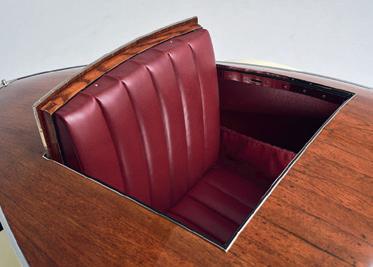
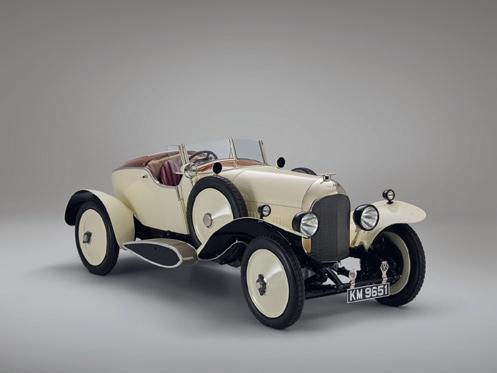
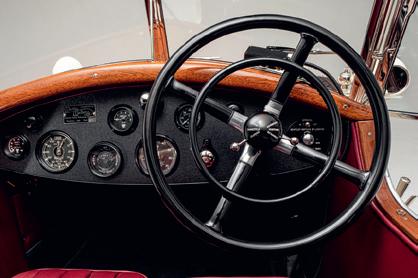

1927 Bentley 3 Litre Boat Tail Speed Model - KM 9651
1927 Bentley 3 Litre Boat Tail Speed Model - KM 9651
1927 Bentley 3 Litre Boat Tail Speed Model - KM 9651
Chassis no: T.N.1564
Chassis no: T.N.1564
Chassis no: T.N.1564
Engine no: TN1 563
Engine no: TN1 563
Engine no: TN1 563

A rare opportunity to own this exceptional Bentley with fabulous provenance, retaining the original and completely unique Boat Tail body coachbuilt by Martin Walter Ltd in 1927. Winner of the Historic Award for Restoration by The Royal Automobile Club. Visit the website for all details and a full gallery of images.
A rare opportunity to own this exceptional Bentley with fabulous provenance, retaining the original and completely unique Boat Tail body coachbuilt by Martin Walter Ltd in 1927. Winner of the Historic Award for Restoration by The Royal Automobile Club. Visit the website for all details and a full gallery of images.
A rare opportunity to own this exceptional Bentley with fabulous provenance, retaining the original and completely unique Boat Tail body coachbuilt by Martin Walter Ltd in 1927. Winner of the Historic Award for Restoration by The Royal Automobile Club. Visit the website for all details and a full gallery of images.
+44 (0)1825 740945
+44 (0)1825 740945
+44 (0)1825 740945

+44 (0)7971 056796 sales@julianparkerltd.uk
+44 (0)7971 056796 sales@julianparkerltd.uk
www.julianparkerltd.uk
www.julianparkerltd.uk
+44 (0)7971 056796 sales@julianparkerltd.uk
Photography by Gun Hill Studios
Photography by Gun Hill Studios
Photography by Gun Hill Studios
Photography by Gun Hill Studios
Althoff Seehotel
Überfahrt

LOCATED IN ROTTACHEgern, just a 45-minute drive from Munich, the Althoff Seehotel Überfahrt offers everything and more for a perfect getaway right on the lakeshore. Its 53 suites and 123 rooms, each with private terraces or balconies, provide stunning views of Lake Tegernsee or the foothills of the Alps. Enjoy the 3000m² 4 Elements Spa by Althoff for precious moments of relaxation and indulge in award-winning cuisine across the five restaurants. Delight in
Italian cuisine at Il Barcaiolo, savour the best of the Alpine region at Egerner Bucht, enjoy a relaxed hut atmosphere at Fährhütte14 or try traditional Bavarian dishes at the Bayernstube.
As a special highlight, experience regional flair with a global influence at the gourmet Restaurant Überfahrt, where Cornelia Fischer’s philosophy comes to life. Whether you’re looking for a wellness weekend, or simply a break from everyday life, there are many good reasons to indulge yourself.
IN ROTTACH-EGERN gelegen, nur 45 Autominuten von München entfernt, bietet das Althoff Seehotel Überfahrt hier alles und mehr für eine perfekte Zeit direkt am Seeufer. Die 53 Suiten und 123 Zimmer mit eigenen Terrassen und Balkonen bieten einen fantastischen Blick auf den Tegernsee oder die Voralpen. Erleben Sie das 3.000m² große 4 elements spa by Althoff für wertvolle Momente der Entspannung und vielfach ausgezeichnete Kulinarik in den fünf Restaurants. Genießen

Sie ausgezeichnete italienische Küche im Restaurant Il Barcaiolo, das Beste der Alpenregion in der Egerner Bucht, entspannte Hüttenatmosphäre in der Fährhütte14 und traditionelle Schmankerl in der Bayernstube. Als besonderes Highlight erwartet Sie im Gourmetrestaurant regionale Verbundenheit mit Blick in die Welt - so lässt sich die Philosophie von Spitzenköchin Cornelia Fischer auf den Punkt bringen. Das mehrfach ausgezeichnete Elegant Nature Resort bietet Ihnen das ganze Jahr über eine entspannte Zeit am Tegernsee. Ob romantische Tage zu zweit, WellnessWochenende oder einfach eine Auszeit vom Alltag – es gibt viele gute Gründe, sich verwöhnen zu lassen
The lakeside Althoff Seehotel Überfahrt offers everything for a perfect getaway.
Das Althoff Seehotel Überfahrt am Ufer des Tegernsees bietet alles für einen perfekten Rückzugsort.






















































































































The awards
Best of Show
The Best of Show Award, presented by A. Lange & Söhne, is at the heart of the Concours of Elegance Germany. The silver lion sculpture and certificate are proudly given to the winner by A. Lange & Söhne CEO Wilhelm Schmid. What sets this accolade apart is the unique judging process – the winner is chosen not by a traditional jury but by the collectors themselves.
Last year, Hans-Jörg Hübner’s 1939 Lancia Astura Pinin Farina Cabriolet won Best of Show: “It was an exceptional experience as our first time to the Bavarian Alps – Lake Tegernsee provided a stunning location and scenery.”
Decade Awards
The Decade Awards honour the standout car of each era from early motoring to the modern classics, celebrating design, authenticity and historical significance.
Chairman’s Award
Selected by Richard Charlesworth, MVO, a long-standing member of the Concours Steering Committee and former Director of Royal and VIP Relations at Bentley, this award is given to a vehicle that moves beyond aesthetic or technical perfection –often recognising charm, originality or a remarkable backstory. Last year, it was given to Klaus Dold’s 1938 Bugatti 57 Gangloff.
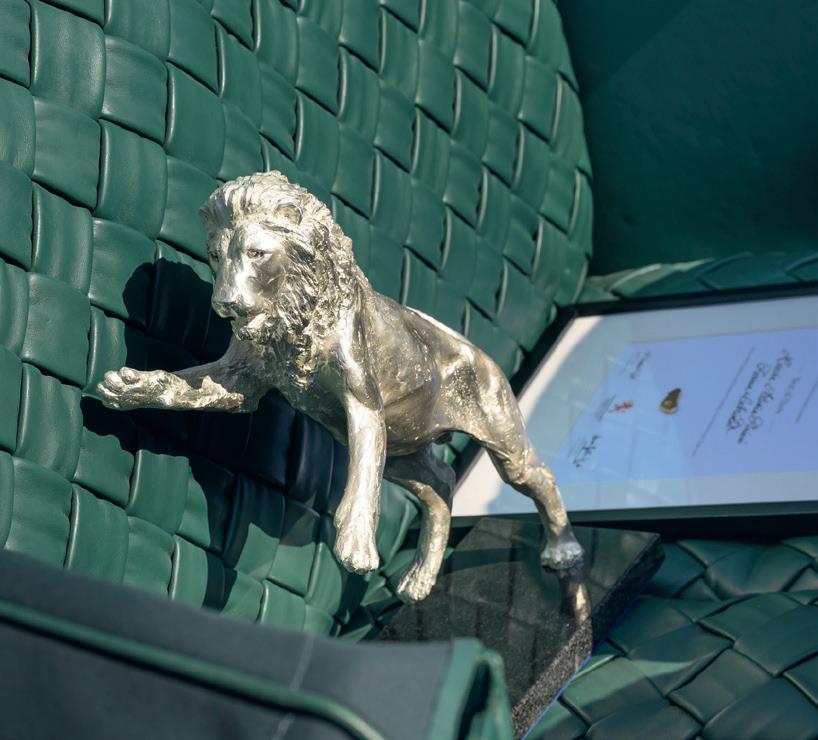

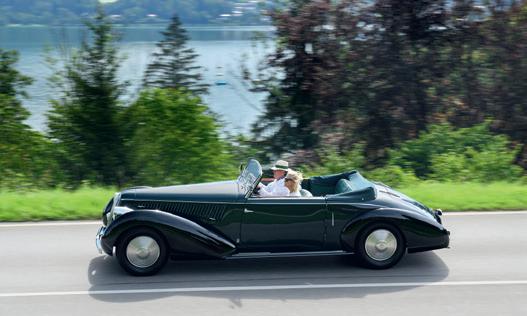
Last year’s stand-out winners, with the Best of Show Lancia Astura receiving a glorious silver lion sculpture.
Die Gewinner des letzten Jahres, angeführt vom Lancia Astura als Best of Show, welcher sich über die glanzvolle silberne Löwenskulptur freuen durfte.
Best of Show
Der Best of Show Award, präsentiert von A. Lange & Söhne, steht im Zentrum des Concours of Elegance Germany. Die silberne Löwenskulptur samt Urkunde wird feierlich vom CEO von A. Lange & Söhne, Wilhelm Schmid, an den Gewinner überreicht. Was diesen Preis besonders macht: Die Auszeichnung erfolgt nicht durch eine
klassische Jury – die Teilnehmer selbst wählen das Siegerfahrzeug. Im vergangenen Jahr gewann Hans-Jörg Hübner mit seinem 1939 Lancia Astura Pinin Farina Cabriolet den Best of Show Award: „Es war ein außergewöhnliches Erlebnis – unser erster Besuch in den Bayerischen Alpen. Der Tegernsee bot eine atemberaubende Kulisse.“
Decade Awards
Die Dekaden Awards würdigen das herausragende Fahrzeug jeder Epoche – von den Anfängen des Automobils bis zu modernen Klassikern. Bewertet werden Design, Originalität und historische Bedeutung.
Chairman’s Award
Der Chairman’s Award wird vergeben von Richard Charlesworth, MVO,
langjähriges Mitglied des Steering Committees und ehemaliger Direktor für Royal und VIP-Relations bei Bentley. Dieser Preis geht an ein Fahrzeug, das über rein technische oder ästhetische Perfektion hinaus begeistert – oft durch Charme, Originalität oder eine bemerkenswerte Geschichte. Letztes Jahr wurde der Preis an Klaus Dold für seinen 1938 Bugatti 57 Gangloff verliehen.

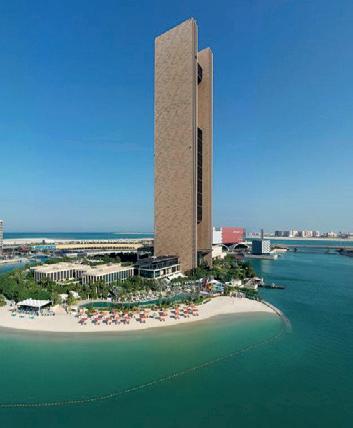
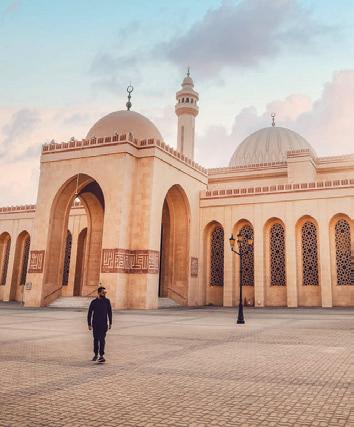


royalconcours.com
His Royal Highness Prince Salman bin Hamad Al Khalifa
The Crown Prince and Prime Minister

WUNDERCAR COLLECTION
A UNIQUE OPPORTUNITY TO SEE A ONE-OF-A-KIND GATHERING OF DESIGN, VISION AND EMOTION
A TRULY REMARKABLE experience awaits Concours of Elegance Germany guests this summer: the Wundercar Collection will be presented as a complete ensemble of four extraordinary cars – a one-of-a-kind gathering of design, vision and emotion. Created by Frankfurtbased lawyer and art patron Dr Christian Zschocke, the Wundercar Collection is not only a tribute to BMW’s iconic E3 series, but a deeper exploration into
the emotional and artistic power of automobiles. Each car was built under his direction to express a unique human emotion –art, elegance, racing, sport, and leisure – inviting visitors to connect with the less technical, more soulful dimensions of mobility. Each of the four vehicles embodies a distinct theme: The New Horizon stands for courage and individuality; The California evokes elegance and a West Coast state of mind; The Inka
celebrates spirited performance; and The Group 1 reflects BMW’s deep motor sport roots. All four are powered by the iconic M30 inline-six engine and have been featured at renowned art and automotive events around the world, from LA to Miami. This 2025 exhibition offers a unique opportunity to experience the collection in a new context – a compelling fusion of design, emotion and driving heritage.
Wundercar Collection is a deeper exploration into the emotional and artistic power of cars.
Die Wundercar Collection ist eine tiefgehende Auseinandersetzung mit der emotionalen und künstlerischen Kraft des Automobils.
auszudrücken – Kunst, Eleganz, Rennsport, Sportlichkeit und Lebensfreude – und lädt Besucher dazu ein, sich mit der weniger technischen, dafür umso seelenvolleren
Dimension der Mobilität zu verbinden.
EIN WAHRHAFT außergewöhnliches Erlebnis erwartet die Gäste des Concours of Elegance Germany in diesem Sommer: Die Wundercar Collection wird als vollständiges Ensemble aus vier einzigartigen Fahrzeugen präsentiert – eine unvergleichliche Zusammenkunft von Design, Vision und Emotion. Erschaffen vom Frankfurter Rechtsanwalt und Kunstmäzen Dr. Christian Zschocke, ist die Wundercar Collection nicht nur eine Hommage an die ikonische BMW E3-Serie, sondern eine tiefere Auseinandersetzung mit der emotionalen und künstlerischen Kraft des Automobils. Jedes Fahrzeug wurde unter seiner Leitung entworfen, um ein menschliches Gefühl
Jedes der vier Fahrzeuge verkörpert ein eigenes Thema: The New Horizon steht für Mut und Individualität, The California für Eleganz und ein westliches Lebensgefühl, The Inka feiert temperamentvolle Fahrfreude, und The Group 1 verweist auf BMWs tiefe Wurzeln im Motorsport. Alle vier Modelle werden vom legendären M30Reihensechszylinder angetrieben und waren bereits bei namhaften Kunst- und Automobilveranstaltungen rund um den Globus zu sehen – von Los Angeles bis Miami. Die Ausstellung 2025 bietet nun die besondere Gelegenheit, diese Sammlung in einem neuen Kontext zu erleben – als faszinierende Fusion aus Design, Emotion und fahrerischem Erbe.
CHAPRON CLASS
AUTOMOTIVE WORKS
THIS YEAR, CONCOURS of Elegance Germany is celebrating the work of legendary coachbuilder Henri Chapron with a special class that highlights the artistic legacy of his creations along with their lasting impact on automotive design. Henri Chapron was known for transforming Citroën and other luxury marques into bespoke masterpieces of craftsmanship and design, and we’ve brought together a breathtaking collection of some of the most refined and elegant post-war French automobiles.
Each car in the Chapron Class tells a unique story of custom design and automotive artistry, brought to life by collectors who have a deep appreciation for French innovation and style. The Chapron Class Award will be presented to the standout vehicle that best exemplifies Henri Chapron’s philosophy of elegance, individuality and timeless beauty.
The entrants include a 1931 Delage D8 Roadster, a 1939 Talbot-Lago T23 Baby Cabriolet Prototype, a 1970 Citroën DS21 IE Cabriolet, a 1972 Citroën SM Mylord and a 1955 Autobleu 4CV.


An Autobleu 4CV, Talbot-Lago T23 and Citroën SM Mylord are among the cars in the Chapron Class.
Ein Autobleu 4CV, Talbot-Lago T23 und Citroën SM Mylord zählen zu den Highlights der Chapron-Klasse.

IN DIESEM JAHR FEIERT der Concours of Elegance Germany das Werk des legendären Karosseriebauers Henri Chapron mit einer Sonderklasse, die das künstlerische Erbe seiner Kreationen sowie deren nachhaltigen Einfluss auf das Automobildesign würdigt.
Henri Chapron war dafür bekannt, Citroën-Modelle und andere Luxusmarken in maßgeschneiderte Meisterwerke der Handwerkskunst und des Designs zu verwandeln. Für diese Klasse haben wir eine atemberaubende Auswahl einiger der elegantesten und raffiniertesten französischen Nachkriegsfahrzeuge zusammengestellt. Jedes Fahrzeug der Chapron Klasse erzählt eine eigene Geschichte von Individualität und gestalterischer Vision – zum Leben erweckt von Sammlern, die französische Innovation und Stil in besonderer Weise schätzen.
Der Chapron KlassenAward wird an das Fahrzeug vergeben, das Chaprons Philosophie von Eleganz, Individualität und zeitloser Schönheit am eindrucksvollsten verkörpert. Zu den Teilnehmern gehören ein 1931 Delage D8 Roadster, ein 1939 Talbot-Lago T23 Baby Cabriolet Prototyp, ein 1970 Citroën DS21 IE Cabriolet, ein 1972 Citroën SM Mylord sowie ein 1955 Autobleu 4CV.
LADIES’ CONCOURS
A CELEBRATION THAT HONOURS BOLD, REFINED AND VISIONARY WOMEN PAST AND PRESENT WHO SHAPE THE WORLD OF CARS
WOMEN HAVE ALWAYS played a key role in collector cars, but the spotlight often only falls on men. Concours of Elegance Germany tells the stories of these women, be they passionate drivers, insightful collectors or daring pioneers.
Saturday July 26 hosts this year’s Ladies’ Concours. A selection of rare vehicles, each proudly owned by women, will take their place among the concours line-up. Each reflects not only automotive excellence, but the individuality, taste and spirit of its female collector.
The concept is inspired by a true pioneer of the automobile: Bertha Benz. Known as the first woman to drive an automobile, she undertook an historic 60mile journey across rugged roads in 1888 – without

permission, a map or assistance. When the car stalled, she reignited it using her garter. Her trip was not only the first long-distance drive – it was a declaration of independence, innovation and belief in the future.
The Ladies’ Concours is a celebration of that same spirit: bold, refined and visionary. It honours women past and present who shape the world of cars not from the passenger seat, but from the driver’s position—with style, intelligence and unwavering passion.

Ladies’ Concours Parade: [Saturday July 26, 11:30am].
Presentation of Ladies’ Concours Awards: [Saturday July 26, 16:15pm].
Ladies’ Concours Parade: [Samstag 26. Juli, 11:30 Uhr].
Preisverleihung Ladies’ Concours: [Samstag 26. Juli, 16:15 Uhr].
FRAUEN HABEN SCHON immer eine zentrale Rolle in der Welt der Sammlerfahrzeuge gespielt – doch allzu oft liegt das Rampenlicht ausschließlich auf den Männern. Der Concours of Elegance Germany erzählt die Geschichten dieser Frauen – ob leidenschaftliche Fahrerinnen, kenntnisreiche Sammlerinnen oder mutige Pionierinnen.
Am Samstag, den 26. Juli, findet der diesjährige Ladies’ Concours statt. Eine Auswahl seltener Fahrzeuge, die allesamt im Besitz von Frauen sind, wird Teil der offiziellen Concours-Ausstellung sein. Jedes Fahrzeug steht nicht nur für automobile Exzellenz, sondern spiegelt auch die Individualität, den Geschmack und den Geist seiner Besitzerin wider. Das Konzept ist inspiriert von
einer wahren Pionierin des Automobils: Bertha Benz. Als erste Frau, die ein Automobil fuhr, unternahm sie 1888 eine historische 100-KilometerReise über unwegsame Straßen – ohne Genehmigung, Karte oder Hilfe. Als das Fahrzeug streikte, brachte sie es mit ihrem Strumpfband wieder zum Laufen. Ihre Fahrt war nicht nur die erste Langstreckenfahrt – sie war ein Symbol für Unabhängigkeit, Innovationskraft und Vertrauen in die Zukunft.
Der Ladies’ Concours feiert genau diesen Geist: mutig, elegant und visionär. Er ehrt Frauen – gestern wie heute –, die die Welt des Automobils nicht vom Beifahrersitz aus prägen, sondern am Steuer. Mit Stil, Intelligenz und unerschütterlicher Leidenschaft.


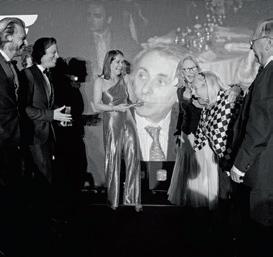

Nominate your company now for the historic automotive industry’s most prestigious awards EXPLORE ALL OF THE CATEGORIES AND SUBMIT YOUR NOMINATIONS TODAY Friday November 14 2025

www.historicmotoringawards.co.uk


EMERGING COLLECTORS CONCOURS
AN INCLUSIVE EVENT FOR ANYONE AGED 35 OR UNDER THAT SHINES A LIGHT ON YOUNG CLASSIC CAR COLLECTORS

PRESENTED BY
The Emerging Collectors Concours recognises those who embody the irrepressible spirit of enthusiast motoring.
Der Emerging Collectors Concours würdigt jene, die den unbändigen Geist leidenschaftlicher Automobilkultur verkörpern.
THE FUTURE OF THE classic car world is a fascinating blend of tastes, marques and attitudes due to a new generation of enthusiasts. The Emerging Collectors Concours – sponsored by A. Lange & Söhne – celebrates this.
Designed for those who’ll become the star collectors of the future, this inclusive event is for anyone aged 35 or under. It shines a light on the future of our
community and diverse motoring passions. This is a generation that will face possibly the greatest challenges to the hobby –and so needs our support. Owners themselves will pick the winner – a car that will offer a glimpse of what makes younger enthusiasts tick, and the models they covet. The wider concours judges will also select their three favourites, taking into consideration the owner’s
story and relationship with the car, and how they use it. Ultimately, this will recognise younger custodians who embody the irrepressible spirit of enthusiast motoring – those who are torch-bearers for the next generation.

DIE ZUKUNFT DER Oldtimerwelt ist ein faszinierendes Zusammenspiel aus Stil, Markenvielfalt und neuen Perspektiven – getragen von einer Generation junger Automobilenthusiasten. Der Emerging Collectors Concours – gesponsert von A. Lange & Söhne – feiert genau diesen frischen Geist. Ins Leben gerufen für leidenschaftliche Fahrzeugsammler unter 35 Jahren, richtet sich dieses besondere Format an jene, die morgen zu den prägenden Persönlichkeiten der Oldtimersammlerszene gehören werden. Ziel ist es, die Zukunft der automobilen Kultur sichtbar zu machen – vielfältig, engagiert und mit einer neuen Haltung.
Diese Generation steht vor besonderen Herausforderungen, wenn es darum geht, das Erbe klassischer Automobile zu bewahren und weiterzuführen – und sie verdient unsere Unterstützung und Sichtbarkeit. Das Besondere: Die Teilnehmer selbst küren das Siegerfahrzeug – jenes, das ihre Leidenschaft am stärksten widerspiegelt. Auch die Jury des Emerging Collectors Concours of Elegance wählt drei Favoriten aus – unter Berücksichtigung der Geschichte des Fahrzeugs, der Beziehung des Besitzers dazu und der Art seiner Nutzung. So ehren wir jene jungen Fahrzeugsammler, die mit Hingabe, Stilgefühl und Begeisterung den automobilen Geist in die Zukunft tragen – als wahre Botschafter einer neuen Ära des Classic Car Collecting.
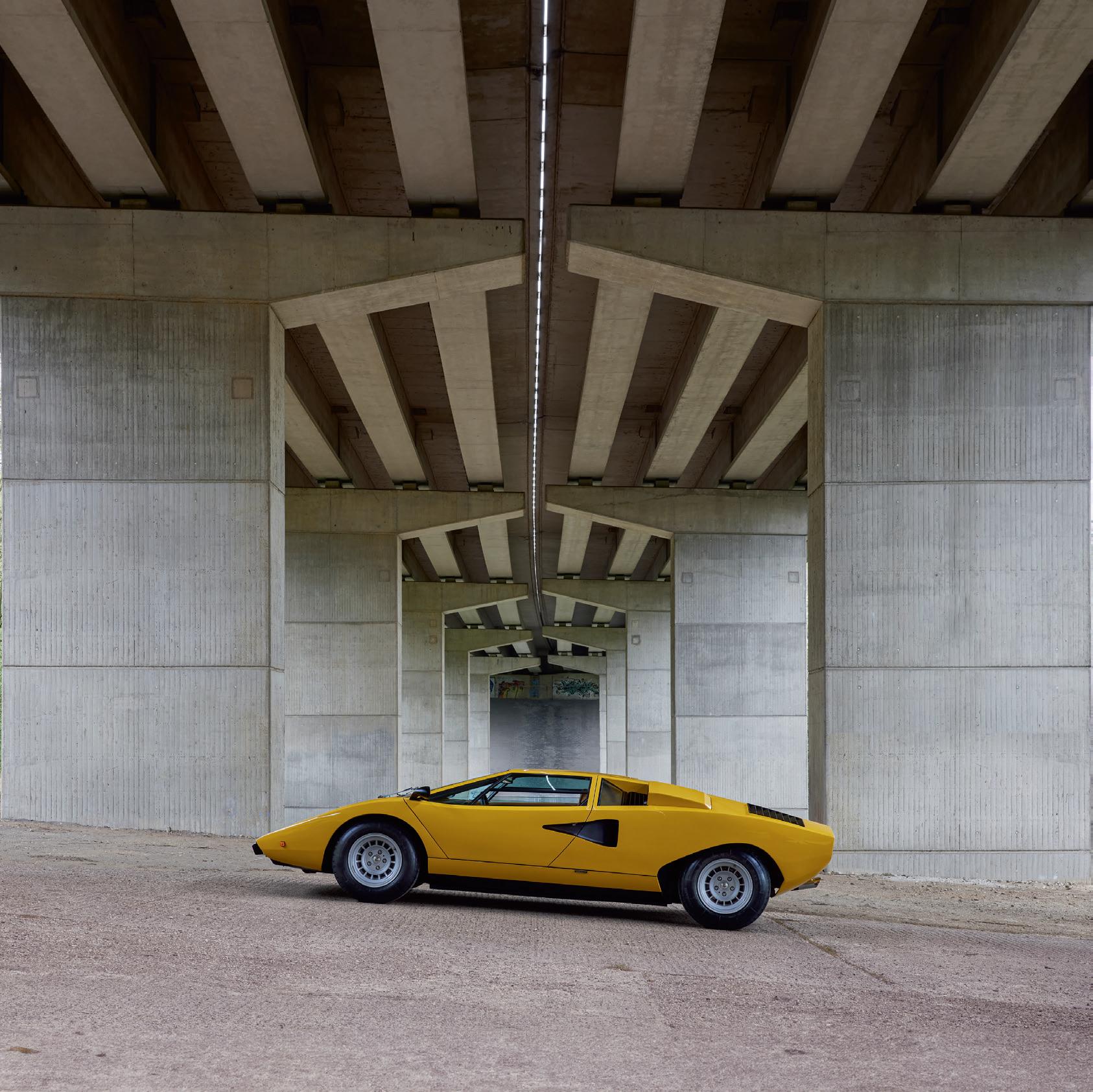
Sign up today to experience the in-depth writing, stunning imagery and award winning design on the cars, people and stories that really matter
JUNIOR CONCOURS WHERE PASSION TAKES ITS FIRST LAP
A CELEBRATION OF THE VERY BEGINNINGS OF AUTOMOTIVE JOY
EVERY COLLECTOR
starts somewhere. For many it’s not behind the wheel of a classic icon, but seated in a scaled-down replica, eyes wide with wonder, heart racing with possibility.
The Junior Concours – sponsored by Sotheby’s International Realty | Tegernsee – is a celebration of those very beginnings: a select group of young drivers will take to the stage in exquisite, handbuilt miniature cars, each a tribute to the great marques of motoring history.
From Bugatti Baby IIs to Ferrari Dinos, and Austin-
Healey pedal cars to gasfuelled Jaguars, these finely crafted vehicles are more than toys. They’re the spark of a lifelong connection between child and machine, tradition and future. Each participant brings their own style, story and spirit. It is a concours in miniature: judged not just on engineering or elegance, but on imagination, zeal and the joy of shared passion across generations. It reminds us that automotive enthusiasm is awakened via experience –curiosity passed from hand to hand, wheel to wheel, generation to generation.
PRESENTED BY

JEDER FAHRZEUGSAMMLER fängt einmal an. Für viele beginnt die Leidenschaft nicht hinter dem Steuer einer Ikone, sondern in einem maßstabsgetreuen Nachbau – mit staunenden Augen und einem Herzen voller Möglichkeiten.
Each participant brings their own style, story and spirit to the Junior Concours.
Jeder Teilnehmer bezaubert mit seinem eigenen Style, seiner Geschichte und seinem Spirit im Junior Concours.
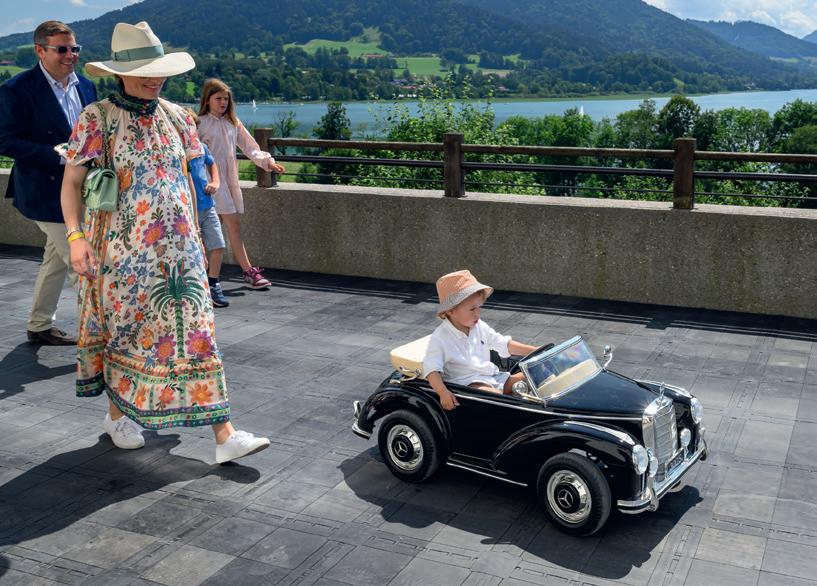

Der Junior Concours – gesponsert von Sotheby’s International Realty | Tegernsee – feiert genau diesen Anfang: Eine ausgewählte Gruppe junger Fahrer tritt in handgefertigten Miniaturfahrzeugen auf – von Bugatti Baby IIs über Ferrari Dinos bis zu benzinbetriebenen Jaguars. Diese kleinen Meisterwerke sind mehr als Spielzeuge – sie entfachen eine lebenslange Verbindung zwischen Kind und Maschine, Vergangenheit und Zukunft. Bewertet wird nicht nur Technik oder Eleganz, sondern auch Fantasie, Begeisterung und generationsübergreifende Leidenschaft.
Automobilfaszination beginnt mit dem ersten Funken – von Rad zu Rad, von Herz zu Herz.








RM SOTHEBY’S – HONOURING F1 LEGENDS
AUCTION HOUSE RETURNS TO TEGERNSEE TO MARK ITS CHAMPIONS – SCHUMACHER AND F1 LEGENDS SALE
FOLLOWING THE success of its inaugural sale in 2024, RM Sotheby’s will return to Tegernsee on July 25-26 – this time with a stellar offering of racing memorabilia from some of the biggest names in motor sport. The Champions –Schumacher and F1 Legends sale will feature 300-plus unique pieces of sporting memorabilia including dozens of gloves, boots, helmets and racing suits from the likes of Michael Schumacher, Ayrton Senna and Lewis Hamilton. Highlights include a signed Schumacher Scuderia Ferrari F1 OMP
racing suit worn to victory at the 1997 Monaco Grand Prix and 2002 Scuderia Ferrari Schuberth helmet from Michael’s fifth Championship-winning year, with countless other artefacts from one of F1’s most enthralling eras to suit every taste and budget.
As a taster, more than 35 pieces of memorabilia ranging from race-worn helmets to wrist watches will be on display in Gut Kaltenbrunn throughout the Concours, with the auction to be held entirely online. Bidding opens at 10:00am on July 24 and closes at 6:00pm on July 30.
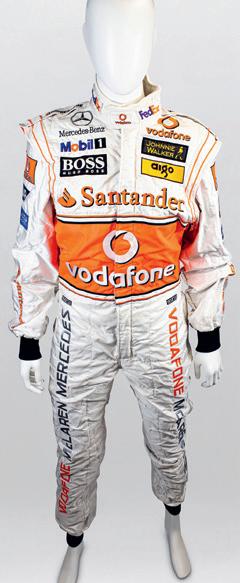

NACH DEM ERFOLG DER Premierenauktion im Jahr 2024 kehrt RM Sotheby’s am 25. und 26. Juli nach Tegernsee zurück – diesmal mit einem spektakulären Angebot an RennsportMemorabilia von einigen der größten Namen des Motorsports. Die Auktion “The Champions – Schumacher and F1 Legends” umfasst über 300 einzigartige Sammlerstücke, darunter zahlreiche Handschuhe, Stiefel, Helme und Rennanzüge von Ikonen wie Michael Schumacher, Ayrton Senna und Lewis Hamilton. Zu den Highlights zählen unter anderem ein signierter OMP-Rennanzug von Schumacher, getragen beim Grand-Prix-Sieg in Monaco 1997, sowie ein


Hamilton’s signed suit and Schumacher’s signed helmet are available in Champions – Schumacher and F1 Legends sale.
Schuberth-Helm von 2002 aus seinem fünften Weltmeisterjahr mit Ferrari. Darüber hinaus bietet die Auktion zahllose faszinierende Objekte aus einer der packendsten Epochen der Formel 1 – für jedes Interesse und Budget. Als Vorgeschmack werden während des Concours mehr als 35 ausgewählte Stücke – von renngetragenen Helmen bis zu Armbanduhren – im Gut Kaltenbrunn ausgestellt. Die Auktion selbst findet ausschließlich online statt. Gebotsbeginn: 24. Juli, 10:00 Uhr
Auktionsende: 30. Juli, 18:00 Uhr
Hamiltons signierter Rennanzug und Schumachers signierter Helm sind in der Auktion „Champions – Schumacher and F1 Legends“ gelistet.

Hand engraving of a balance cock
Handgravur eines Unruhklobens
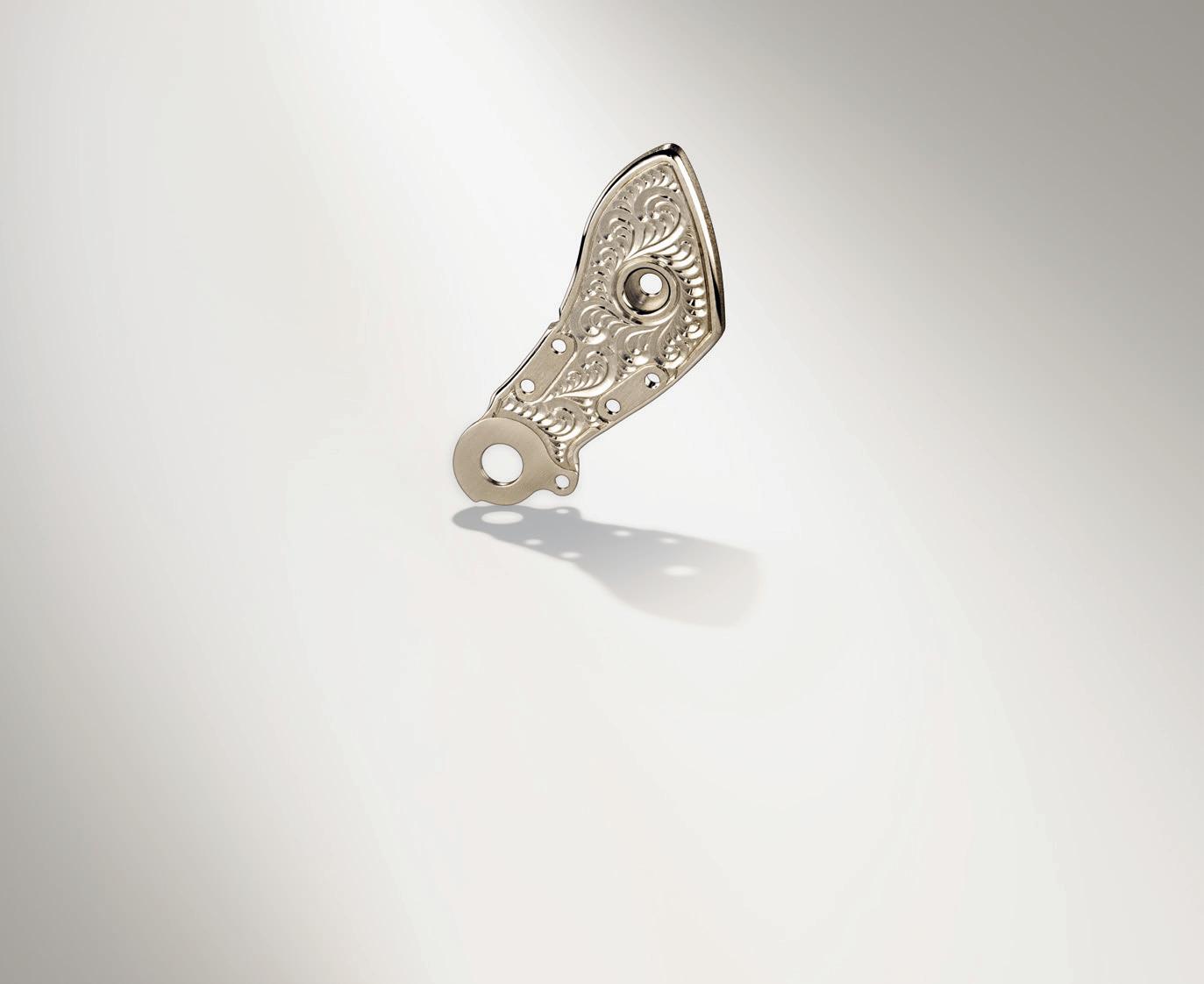
A. LANGE & SÖHNE
Craftsmanship to the highest precision
The balance cock is a special highlight in A. Lange & Söhne movements. In a free-hand process, this small part is decorated by a master engraver with a traditional floral motif, making it one-of-a-kind. The hand-engraved balance cock also symbolises the commitment to the highest quality and precision values that connect A. Lange & Söhne with the Concours of Elegance Germany. That is why the certificates awarded to the winners of the ‘Best of Show’ and ‘Emerging Collectors’ categories feature a hand-engraved balance cock made of the Langetypical material German silver in recognition of their exceptional commitment to tradition and mechanical masterpieces.

The balance cock bears the oscillation system of the watch
Der Unruhkloben trägt das Schwingsystem der Uhr
Der Unruhkloben zählt zu den markantesten Uhrwerkskomponenten von A. Lange & Söhne. Das kleine Bauteil wird von einem Meistergraveur in freiem Schnitt mit einem traditionellen floralen Muster dekoriert, das jeden Zeitmesser zum Unikat werden lässt. Zugleich symbolisiert der handgravierte Unruhkloben den Anspruch an höchste Qualität und Präzision Werte, die A. Lange & Söhne mit dem Concours of Elegance Germany verbinden. Daher sind die Zertifikate, die den Gewinnern der Kategorien „Best of Show“ und „Emerging Collectors“ verliehen werden, mit einem handgravierten Unruhkloben aus dem für Lange typischen Material Neusilber versehen als Auszeichnung ihres herausragenden Engagements für Tradition und mechanische Meisterwerke.



A CONCOURS OF ELEGANCE AND STYLE
CELEBRATING HERITAGE, PRECISION AND ENDURING BEAUTY IN IMPECCABLE FASHION
THE CONCOURS OF Elegance Germany is not only a celebration of extraordinary vehicles – it is a celebration of elegance itself. Set against the breathtaking backdrop of Lake Tegernsee, the event has become a magnet for connoisseurs of refinement, bringing together not just the planet’s rarest cars, but also a world of impeccable style. At the 2024 edition, guests embraced the spirit of the occasion with remarkable flair – from period-correct dresses and tailored race suits to refined interpretations of
gentlemanly style. This sartorial atmosphere continues in 2025, as the Ladies’ Concours is now accompanied by an exclusive fashion show hosted by Sportalm and The Modelinstitute – two of this year’s official fashion and lifestyle partners. New for 2025 is the ‘Bond Straße’ – a luxury shopping concept store area inspired by the British-Bavarian connection. Nestled within the event grounds adjacent to the courtyard of concours cars, this elegant boulevard is dedicated to fine exhibitors across
fashion, shoemaking, perfume, porcelain and pianos, offering guests a curated lifestyle experience to match the cars on display.
At the heart of this celebration of craftsmanship stands event presenting partner A. Lange & Söhne. With its exquisite timepieces on display, this heralded watchmaker represents the same values shared by the Concours: heritage, precision and enduring beauty.
Elegance is more than a dress code. It’s a mindset – one that defines every moment at the Concours of Elegance Germany.

Elegance is more than a dress code – it’s a mindset that defines every moment at the Concours.
Eleganz ist mehr als ein Dresscode. Sie ist eine Haltung – und sie prägt jeden Moment beim Concours of Elegance Germany.
DER CONCOURS OF Elegance Germany ist nicht nur eine Hommage an außergewöhnliche Automobile – er ist eine Feier der Eleganz selbst. Vor der atemberaubenden Kulisse des Tegernsees ist das Event zu einem Anziehungspunkt für Kenner von Stil und Raffinesse geworden. Hier treffen nicht nur die seltensten Fahrzeuge der Welt aufeinander, sondern auch eine Welt voll makellosen Geschmacks.
Bei der Ausgabe 2024 lebten die Gäste den Geist der Veranstaltung mit beeindruckender Stilsicherheit – von originalgetreuen Kleidern und maßgeschneiderten Rennoveralls bis hin zu modernen Interpretationen klassischgentlemanhafter Eleganz. Diese stilvolle Atmosphäre wird 2025 fortgeführt: Der Ladies’ Concours wird in diesem Jahr von einer exklusiven Modenschau begleitet, veranstaltet
von Sportalm und The Modelinstitute – zwei offiziellen Mode- und Lifestyle-Partnern der diesjährigen Ausgabe. Neu in 2025 ist die „Bond Straße“ – ein Luxury-Shopping-Konzept, inspiriert von der britischbayerischen Verbindung. Eingebettet in das Veranstaltungsgelände und angrenzend an den Innenhof der Concours-Fahrzeuge, bietet diese elegante Flaniermeile eine kuratierte Auswahl erlesener Aussteller aus den Bereichen Mode, Schuhhandwerk, Parfums, Porzellan, und Pianos– ein Lifestyle-Erlebnis, das den ausgestellten Automobilen in nichts nachsteht.
Im Herzen dieses Festes der Eleganz steht der Presenting Partner A. Lange & Söhne. Mit seinen exquisiten Zeitmessern, die während des Events ausgestellt werden, verkörpert dieser renommierte Uhrenhersteller dieselben Werte wie der Concours: Tradition, Präzision und zeitlose Schönheit.
CLASSIC DRIVER AT CONCOURS OF ELEGANCE
MEET THE MATCHMAKER OF THE COLLECTOR CAR WORLD AT LAKE TEGERNSEE
SINCE 1998, CLASSIC
Driver has been presenting the world’s most beautiful cars to an enthusiastic online audience. It supports the Concours of Elegance Germany as an official media partner, with the brand’s long-standing CEO, J Philip Rathgen, assuming the role of Honorary Concours Director.
Classic Driver offers collectors, dealers, auction houses and enthusiasts the most prestigious marketplace for classic
Classic Driver’s J Philip Rathgen plays the role of Honorary Concours Director.
Classic Driver’s J Philip Rathgen übernimmt die Rolle des Honorary Concours Director.
and contemporary cars from around the globe. But that’s merely the beginning: it is also an online magazine publishing compelling stories about the most exciting cars and their owners, as well as an influential Instagram channel that takes its followers behind the scenes at exclusive motoring events.
In addition, Classic Driver operates a curated online store celebrating car culture and catering to a community of enthusiasts
with essential books and magazines, accessories, artworks, collectables and timepieces. Classic Driver also advises and supports automotive and luxury brands through its creative agency, CD Works. Concours attendees would be well advised to keep a close eye on Classic Driver’s magazine and social media channels throughout the weekend – and afterwards to visit its marketplace in search of their next dream car.


SEIT 1998 PRÄSENTIERT
Classic Driver die schönsten Automobile der Welt einem begeisterten OnlinePublikum. Als offizieller Medienpartner unterstützt
Classic Driver den Concours of Elegance Germany – mit dem langjährigen CEO der Marke, J. Philip Rathgen, der gleichzeitig die Rolle des Honorary Concours Director übernimmt.
Classic Driver bietet Sammlern, Händlern, Auktionshäusern und Enthusiasten den renommiertesten Marktplatz für klassische und moderne Fahrzeuge weltweit. Doch das ist erst der Anfang: Als digitales Magazin veröffentlicht Classic Driver inspirierende Geschichten über faszinierende Fahrzeuge, deren Besitzer sowie die besonderen Momente dahinter.
Auch auf Instagram nimmt Classic Driver seine Community mit hinter die Kulissen der exklusivsten Automobilveranstaltungen – authentisch, stilvoll und
nahbar. Ergänzt wird das Angebot durch einen kuratierten Online-Shop, der sich ganz der Autokultur widmet: Bücher, Magazine, Accessoires, Sammlerstücke, Kunstwerke und Uhren für Menschen mit Leidenschaft. Darüber hinaus unterstützt Classic Driver mit seiner Kreativagentur Automobil- und Luxusmarken in der Markenkommunikation und visuellen Identität. Allen Besuchern des Concours sei empfohlen: Behalten Sie die Website und Social-Media-Kanäle von Classic Driver am Veranstaltungswochenende genau im Auge – und entdecken Sie danach vielleicht schon Ihr nächstes Traumfahrzeug.


BUNTE MAGAZINE AT THE CONCOURS
SEMINAL MAGAZINE REFLECTS THE POSITIVE JOIE DE VIVRE AND ELEGANCE OF THE CONCOURS
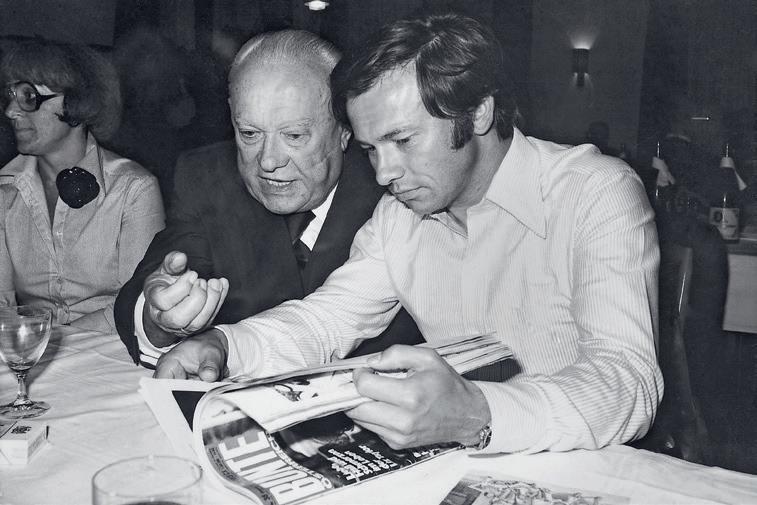
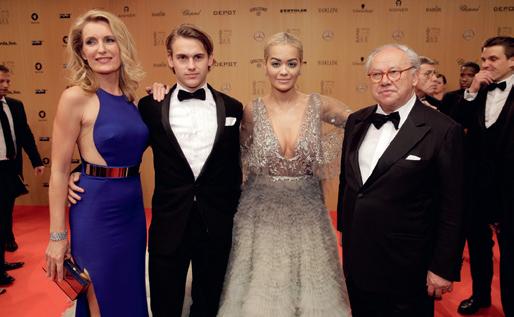
SEVENTY-SEVEN YEARS ago, Senator Franz Burda founded the magazine BUNTE, known in its early days as Das Ufer. He could not have known at the time that his publication would soon become one of the most renowned in Europe. To this day, BUNTE is the leading medium when it comes to celebrities, careers and society news, with the reader always remaining the focus.
In 1976, Dr Hubert Burda took over the editorship of the publication from his father. He developed it into a modern ‘people’ magazine and a “seismograph of society”, as he puts it. His wish has always been to be open to new things and the changes in our world, and to have a positive attitude to life – and these are the values that the editorial team uses to create the magazine every week. Every issue of BUNTE offers readers an exclusive look through the keyhole at the stars, as well as at the most beautiful moments of the most glamorous events in international society. This positive joie de vivre and elegance are exactly what the Concours stands for, which is why BUNTE 2025 is the official media partner of the event at Lake Tegernsee.
VOR SIEBENUNDSIEBZIG
Jahren gründete Senator Franz Burda das Magazin BUNTE, das in seinen Anfängen unter dem Namen Das Ufer bekannt war. Damals konnte er nicht ahnen, dass seine Publikation schon bald zu einer der renommiertesten Europas werden würde. Bis heute ist BUNTE das führende Medium, wenn es um Prominente, Karrieren und Gesellschaft geht – dabei steht der Leser stets im Mittelpunkt. Im Jahr 1976 übernahm Dr. Hubert Burda die Chefredaktion von seinem Vater. Er entwickelte das Magazin zu einer modernen
People-Zeitschrift weiter – einem „Seismographen der Gesellschaft“, wie er es selbst nennt. Sein Wunsch war es stets, offen für Neues und den Wandel in unserer Welt zu sein und dabei eine positive Lebenshaltung zu vermitteln – Werte, mit denen die Redaktion bis heute Woche für Woche das Magazin gestaltet. Jede Ausgabe von BUNTE bietet ihren Lesern einen exklusiven Blick durchs Schlüsselloch – auf Stars ebenso wie auf die schönsten Momente der glamourösesten Ereignisse der internationalen Gesellschaft. Diese positive
Franz and Hubert Burda shaped BUNTE into a magazine celebrating influential personalities and elegant living.
Franz und Hubert Burda prägten BUNTE als Magazin, das einflussreiche Persönlichkeiten und Lebenskunst zelebriert.
Lebensfreude und Eleganz sind es auch, für die der Concours of Elegance Germany steht – und deshalb ist BUNTE 2025 offizieller Medienpartner der Veranstaltung am Tegernsee.









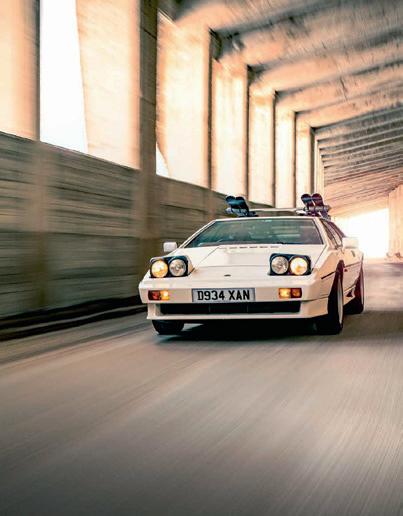















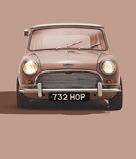





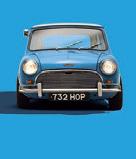




















Sponsors and partners
Presenting Partner
A. LANGE & SÖHNE
In 1845, Dresden watchmaker Ferdinand Adolph Lange laid the cornerstone for Saxon precision watchmaking in Glashütte. After an involuntary hiatus of over 40 years, his great-grandson Walter Lange seized the opportunity and made a courageous fresh start in 1990. Based on a unique heritage and the commitment to the highest-possible standards, A. Lange & Söhne crafts exclusive timepieces, endowed with movements developed in-house that are elaborately finished by hand and assembled twice. www.alange-soehne.com
Präsentationspartner
A. LANGE & SÖHNE
Im Jahr 1845 legte der Dresdner Uhrmacher Ferdinand Adolph Lange in Glashütte den Grundstein für die sächsische Feinuhrmacherei. Nach einer Zwangspause von über 40 Jahren ergriff sein Urenkel Walter Lange die Gelegenheit und wagte 1990 einen mutigen Neuanfang. Auf der Grundlage eines einzigartigen Erbes und der Verpflichtung zu höchsten Standards fertigt A. Lange & Söhne exklusive Zeitmesser mit hauseigenen Uhrwerken, die in aufwendiger Handarbeit finissiert und zweifach montiert werden. www.alange-soehne.com

Official Partners
ALTHOFF SEEHOTEL ÜBERFAHRT
Official Hotel Partner
Welcome to Althoff Seehotel Überfahrt, the Elegant Nature Resort at Lake Tegernsee – just 45 minutes from Munich. Enjoy award-winning cuisine, the 4 elements spa and pure relaxation. www.althoffcollection.com

GUT KALTENBRUNN
Venue
Gut Kaltenbrunn on Lake Tegernsee combines the Bavarian way of life, tradition, culture and enjoyment. Since its reopening in 2015 by Michael Käfer, it has stood for enchanting hospitality and regional products. www.feinkost-kaefer.de/ pages/gutkaltenbrunn

KÄFER
Official Hospitality Partner
Founded in 1930, Feinkost Käfer evolved from a small Munich shop into a global brand, leading in premium catering. Today, it thrives through catering, gastronomy, retail and licensing. www.feinkost-kaefer.de
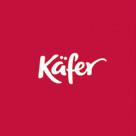
Manufacturer Partners
ABT SPORTSLINE
Official Partner
ABT Sportsline is the world’s largest tuner of Audi, Lamborghini, Cupra and more. Offering powerful engine tuning, premium body parts and bespoke interiors, it creates exclusive special models as unique overall concepts. www.abt-sportsline.de
LAURENT-PERRIER
Official Champagne Partner
Family owned by the de Nonancourt family in Tours-sur-Marne since 1812, Champagne Laurent-Perrier is the largest independent Champagne house, renowned for its freshness, elegance and refinement. www.laurent-perrier.com

RM SOTHEBY’S
Official Auction Partner
RM Sotheby’s has led the global collector car auction industry for the past 45 years, becoming the pre-eminent market maker of high-quality collector cars. www.rmsothebys.com

BRABUS
Official Partner
Brabus is a globally renowned luxury mobility brand and high-end vehicle manufacturer, specialising in automotive individualisation, bespoke design and exclusive lifestyle products since 1977. www.brabus.com


DÖRR GROUP
Official Partner
Supersports specialist the Dörr Group is Europe’s most diverse high-performance sports car dealer. Since being founded in Frankfurt in 2011, it’s expanded to Stuttgart, Munich, Hockenheim, Berlin and Düsseldorf. Motor sport is also deeply rooted in its DNA. Bugatti, Pagani, Pininfarina, Dallara, McLaren, Lamborghini, Aston Martin, Singer, Czinger, BAC, Rimac, Morgan, KTM and Triumph. www.doerrgroup.com

EMIL FREY SPORTIVO | OFFICIAL FERRARI DEALER
Official Partner
Ferrari München
Where passion meets precision: As Munich’s official Ferrari dealership, we offer tailor-made experiences, expert consultation and service excellence – all true to the spirit of the Prancing Horse. munich.ferraridealers.com

KOENIGSEGG
Official Partner
Koenigsegg is a Swedish hypercar manufacturer known for pushing the boundaries of innovation, performance and design, creating groundbreaking vehicles that redefine speed, technology and automotive excellence worldwide. koenigsegg-munich.com

LAMBORGHINI MUNICH
Official Partner
Lamborghini Munich is every car enthusiast’s dream – a place where design, passion and elegance come together to create unforgettable experiences. munich.lamborghini
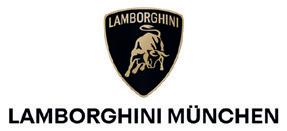
PAL-V
Official Air Mobility Partner
Discover PAL-V: the global leader in sustainable FlyDrive mobility solutions. Combining driving and flying in one vehicle, the Liberty offers unmatched freedom, efficiency and effectiveness. www.pal-v.com
POLESTAR
Official Partner
Polestar is a Swedish performance electric car brand that combines Scandinavian design with innovative technology. With a strong focus on sustainability, Polestar is redefining the future of mobility – powerful, electric and uncompromising. www.polestar.com


PORSCHE ZENTRUM INNTAL
Official Partner
The Porsche Zentrum Inntal in the heart of the Alps is the place to go for new and used Porsche cars. In addition, we offer services ranging from servicing your Porsche to restorations and racetrack use of modern and historic customer vehicles. www.porsche-inntal.de

RIMAC AUTOMOBILI
Official Partner
Rimac is a pioneering Croatian hypercar manufacturer and technology innovator, redefining performance and electrification through cutting-edge engineering, breathtaking design and record-breaking all-electric vehicles such as the Rimac Nevera. www.rimac-automobili.com

RUF AUTOMOBILE
Official Partner
RUF celebrates more than 85 years of performance and dedication at the Concours of Elegance Germany, emphasising a timeless vision of automotive excellence and authenticity shaped by heritage and craftsmanship. www.ruf-automobile.de

SCHALTKULISSE
Dealer Patron and Tour Engineering Partner
Schaltkulisse is a leading international specialist in sourcing and selling some of the world’s most sought-after automobiles. In addition to sales, we offer full ownership support, including a state-ofthe-art workshop, storage, consulting and financing. www.schaltkulisse.com

Partners
SEMCO
Official Partner
SEMCO Cars is a leading German specialist in high-end sports and luxury automobiles, offering exclusive sales, sourcing and service for the world’s most prestigious automotive brands and collectors. www.semcocars.com
AIRX
Official Private Aviation Partner
AirX is one of Europe’s leading private aviation operators, offering bespoke charter solutions worldwide. With refined service, exceptional attention to detail and absolute discretion, AirX delivers a flying experience tailored to the needs of discerning travellers. www.airx.aero
AMALGAM COLLECTION
Official Partner
Amalgam Collection crafts the world’s finest large-scale model cars, creating museum-quality replicas with unmatched precision, authenticity and artistry for discerning collectors, car owners and leading automotive manufacturers. www.amalgamcollection.com



Luxury
EM ROGERS
Official Transport Partner
EM Rogers, founded in 1945, is a family-owned UK transport company specialising in vehicle logistics. With over 55 enclosed transporters, it offers secure UK, European and global delivery, including air freight. Services include storage for 600-plus vehicles and in-house customs support, ensuring efficient, professional and cost-effective vehicle transportation. www.emrogers.com

LENGLING
Official Partner
Lengling is a Munich-based perfume house blending artistic duality and emotion. Each fragrance is crafted over years using rare natural ingredients, crowned with the hand-polished Isar pebble cap. www.lengling.com

OCC
Official Partner
OCC, a pioneer in classic car insurance for more than 40 years, offers tailor-made insurance solutions for collector vehicles, fair premiums and an online rate calculator. It is an insurance expert for automotive masterpieces. occ.eu
SOTHEBY’S INTERNATIONAL REALTY | TEGERNSEE
Official Prime Real Estate Partner and Junior Concours Sponsor
Nestled in one of Germany’s most beautiful regions, we support you in finding exceptional properties around Lake Tegernsee and beyond. Our approach combines regional expertise with an international standard – guided by sensitivity, foresight and a clear focus on your personal vision of home. www.muenchen-sothebysrealty.com


MEISSEN
Official Partner
As Europe’s first porcelain manufactory, Meissen has been producing iconic porcelain for 315 years, combining innovation, passion and timeless elegance in art, tableware, jewellery and unforgettable visitor experiences. To this day, the manufactory in Meissen is the only production site for the worldwide distribution of these masterpieces. www.meissen.com
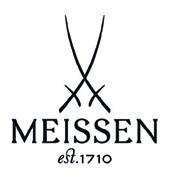
SPORTALM
Official Partner
Sportalm combines fashion, traditional costumes and ski collections – all made in Europe. Each piece captures the spirit of Kitzbühel with innovative fabrics, timeless craftsmanship and a touch of Alpine glamour. www.sportalm.at

STEINWAY & SONS
Official Partner
Since 1853 the name Steinway & Sons has stood for the finest pianos. Passion and dedication, perfection and quality, reliability and the incomparable sound are among the qualities people around the world associate with these high-quality instruments. The unique self-playing Spirio transports pianists and listeners into entirely new sound worlds and allows them to immerse themselves in musical spheres that can only be found with Steinway. www.steinway.com

THE MODELINSTITUTE
Official Partner
The Modelinstitute, founded by industry expert Juliane Braun, shapes aspiring models for international careers – delivering elegance, confidence and excellence to high-end fashion shows and exclusive events.
www.themodelinstitute.de

CLASSIC DRIVER
Media Partner
Founded in 1998, Classic Driver is the reference collector car marketplace and magazine for buyers, sellers and enthusiasts worldwide. Discover and buy the cars of your dreams. www.classicdriver.com
MAGNETO
Media Partner
Magneto is the award-winning quarterly magazine that has taken the collector car world by storm with its in-depth features and stunning design. It is all about the greatest cars, and the people and stories that surround those cars – whether it’s Bugatti in the 1930s or McLaren in the 21st century. Single copies and subscriptions are available to buy online. Don’t miss out. www.magnetomagazine.com
Media Partners
BUNTE
Media Partner
As Germany’s leading people magazine diving deep into the world of celebrities, BUNTE gives exclusive insights into the world of stars. We bring you exclusive interviews, exciting reports and the latest news from the lives of stars, nobility and important personalities. www.bunte.de

OCTANE GERMANY
Media Partner
Octane, the premium magazine for classic and sports cars, has been established in Germanspeaking countries for more than ten years, with a focus on the international classic car scene. We are fuelling the dreams of our readers with exceptionally researched and high-quality photographed stories about all aspects of mobility and the associated lifestyle.
www.octane-magazin.de



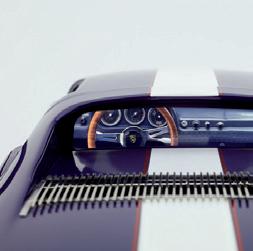




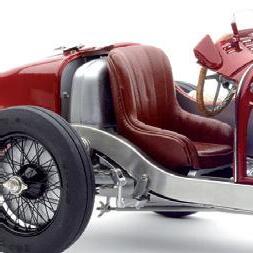









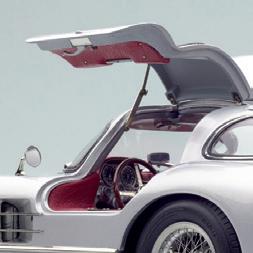

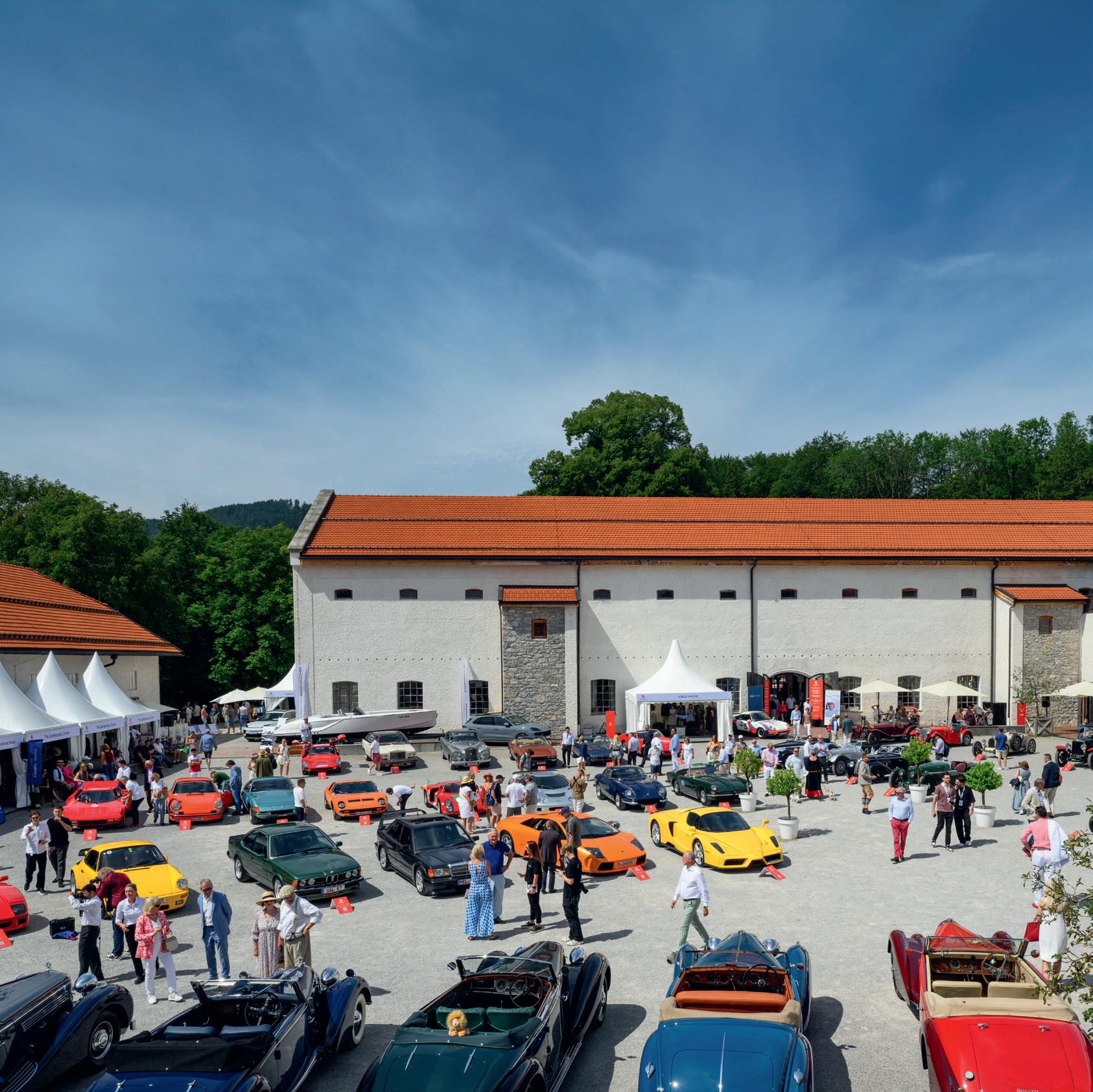
CONCOURS CAR ENTRIES 2025
CLASSIC AND COLLECTOR CARS FROM THROUGHOUT THE AGES, PRESENTED AGAINST AN HISTORIC BACKDROP
1928 Bentley 6.5 Litre Barker Boat-Tail
Private
Collection
THIS 6.5 LITRE BENTLEY WAS ORIGINALLY BUILT
with a Barker two-seater roadster body made of polished aluminium. It was created for the Maharaja of Bhavnagar, and the completed car was delivered to Standard Motors of India on September 22, 1928. In 1934, the Maharaja sent the car (chassis FA2513) back to Barker in England. There, the old body was replaced with an open four-door version.
The original body was purchased by Coopers of Putney and mounted on a 1928 4.5 Litre Bentley chassis, number RN3050. In the 1980s, chassis RN3050 was purchased by Stanley Mann, who fitted it with a replica Le Mans-style body. The original boat-tail body was acquired by Ed Hubbard and, after being restored, this was mounted onto the chassis of a Standard Six Bentley, number LB2348. Later on, it was removed.
Chassis number FA2513 returned to England in the 1950s. In 1966, Tony Townshend acquired the damaged tourer and kept it for ten years. Lance O’Neal bought the car in around 1975, and then in 1976 he shipped it to Australia, where in 1978 he traded it with Ral Rainsford for a new Ferrari GTS.
At the turn of the millennium, Peter Hageman finally reunited the chassis with the original boat-tail body, and he presented the freshly restored car at Pebble Beach in 2001.
DIESER BENTLEY ENTSTAND URSPRÜNGLICH ALS zweisitziger Roadster mit polierter Aluminium-Karosserie von Barker. Der für den Maharadscha von Bhavnagar konfigurierte 6 ½ Litre wurde am 22. September 1928 an Standard Motors of India geliefert. 1934 sandte der Maharadscha den Bentley (Chassis FA 2513) zurück nach England, wo ihn Barker zu einem viersitzigen Tourer umbaute. Die originale Karosserie wurde von Coopers of Putney erworben und auf das Chassis eines 4 ½ Litre Bentley aus dem Jahr 1928 (Chassis RN3050) montiert. In den 1980er-Jahren erwarb Stanley Mann Chassis RN3050, der es mit einer Replica-Karosserie im Le-Mans-Stil einkleidete. Die nun erneut ausgetauschte Karosse mit „Bootsheck“ wurde von Ed Hubbard gekauft und, nach einer Restaurierung, auf den Unterbau eines Standard Six Bentley, Chassisnummer LB2348, gesetzt. Später wurde sie dann wieder entfernt. Chassis FA2513 kehrte in den 1950er-Jahren nach Großbritannien zurück. 1966 kaufte Tony Townshend den beschädigten Tourer und behielt ihn zehn Jahre lang. Nächster Besitzer war um das Jahr 1975 herum Lance O’Neal, der den Wagen 1976 nach Australien verschiffte, wo er ihn 1978 bei Ral Rainsford gegen einen neuen Ferrari GTS eintauschte. Zur Jahrtausendwende vereinte Peter Hageman endlich das Fahrgestell wieder mit seinem originalen zweisitzigen „Boat-tail“-Body, und präsentierte das frisch restaurierte Modell 2001 in Pebble Beach.
‘The chassis was finally reunited with the body, and the restored car was presented at Pebble Beach in 2001’
„Das Fahrgestell wurde endlich mit der Karosserie wiedervereint und das restaurierte Modell 2001 in Pebble Beach präsentiert“
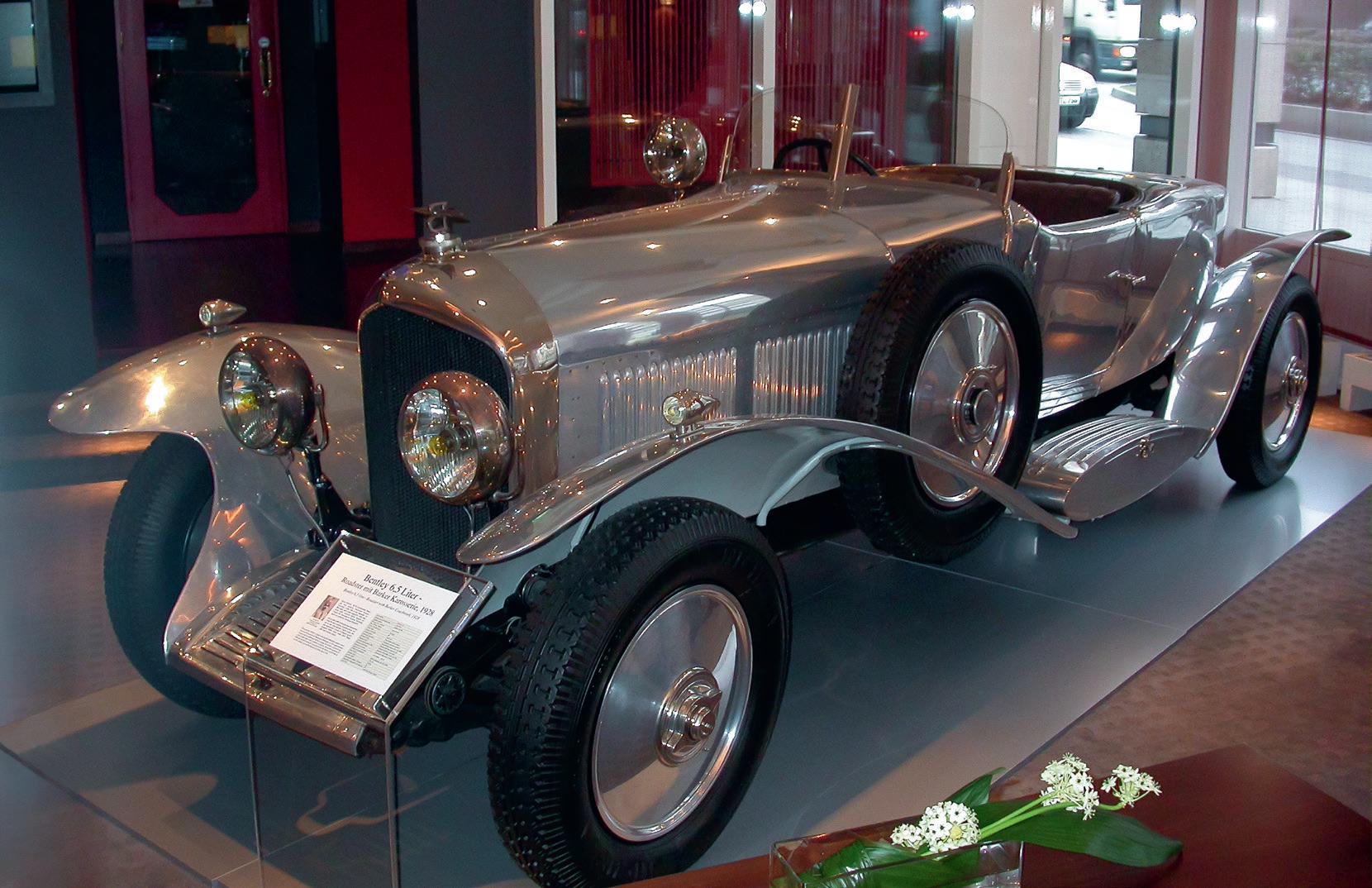
The Bentley’s original aluminium two-seater roadster body was built by Barker.
Die originale zweitsitzige RoadsterKarosserie aus Aluminium entstand bei Barker.
1929 Mercedes-Benz 710
SS Roadster by Corsica
Private Collection
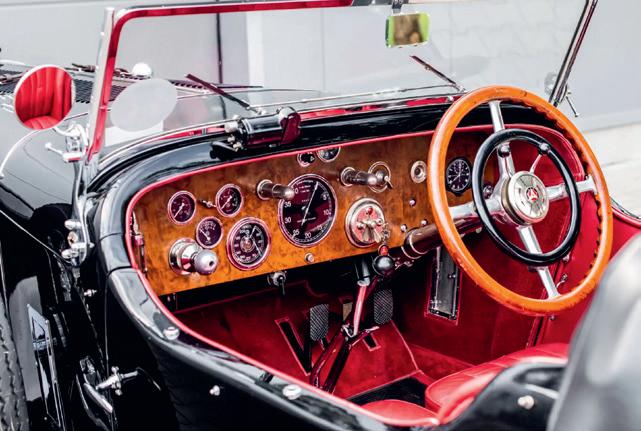
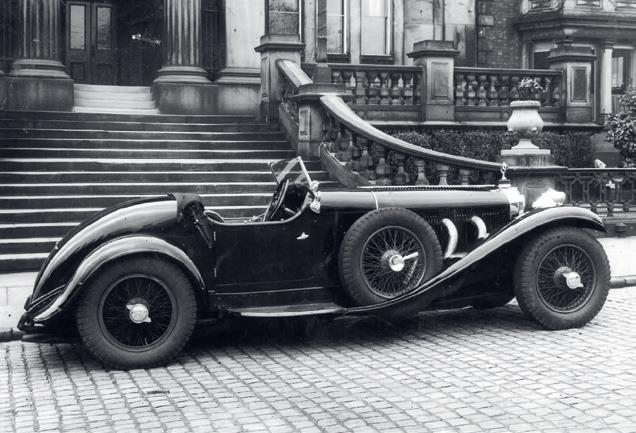
THE S-TYPE WAS MERCEDES-BENZ’S MOST sophisticated pre-war car, and in Works SSK specification the 7.1-litre six-cylinder engine could produce up to 250bhp (300bhp in the SSKL version) thanks to a supercharger. In total, just 111 SS cars were built.
This 710 Super Sport, chassis number 36036, was ordered by Mayfair dealer Gordon Watney via British Mercedes-Benz Ltd. Believed to be intended for former Bentley Boy Thomas ‘Scrap’ Thistlethwayte, it suffered damage to the rear in an accident, likely prompting the fitting of a new roadster body by Corsica Coachworks. In 1934 Clifford Taylor, a dealer on Berkeley Square in London and occasional film producer, acquired the car and displayed it at Brooklands in the Ealing Studios film DeathDrivesThrough. He then sold it to Military Cross recipient Colonel Samuel Sandars of Lincolnshire. Car dealer Ewart Bradshaw acquired the Mercedes-Benz in 1938, keeping it until his passing in 1959. It’d later join the stable of famous Mercedes-Benz collector ML ‘Bud’ Cohn in Los Angeles in 1963. The car would then pass through several US collectors, including Skip Barber, before being purchased by Swedish collector Kent Olsson in 1990. It was restored in time for the 1997 Pebble Beach Concours d’Elegance, and then sold to The Aumann Collection a year later, after which it won the public vote at the 1999 Concorso d’Eleganza Villa d’Este. It changed hands again last year in RM Sotheby’s Munich sale.
DER TYP S WAR DER FORTSCHRITTLICHSTE VORKRIEGSSportwagen von Mercedes-Benz und leistete in der Werks-SSKSpezifikation dank eines per Kompressor aufgeladenen 7,1-LiterSechszylinders bis zu 250 PS (bis zu 300 PS im SSKL). Insgesamt wurden nur 111 Exemplare des SS gebaut. Dieser 710 Super Sport, Chassisnummer 36036, wurde vom Händler Gordon Watney aus dem Londoner Stadtteil Mayfair geordert. Vermutlich für den ehemaligen Bentley-Boy Thomas Thistlethwayte bestimmt, erlitt der Wagen bei einem Unfall einen Heckschaden, was wahrscheinlich dazu führte, dass Corsica Coachworks ihm eine neue RoadsterKarosserie verpasste. 1934 erwarb Clifford Taylor, ein Händler am Berkeley Square in London und gelegentlicher Filmproduzent, den Wagen und setzte ihn bei den von den Ealing Studios in Brooklands gedrehten Rennszenen für den Film „Death Drives Through“ ein. Im Anschluss verkaufte ihn Taylor an Colonel Samuel Sandars, ein Military-Cross-Träger aus Lincolnshire. 1938 erwarb der Autohändler Ewart Bradshaw den MercedesBenz und behielt ihn bis zu seinem Tod im Jahr 1959. 1963 hielt der Kompressor-Mercedes Einzug in den Stall des berühmten

‘Clifford Taylor acquired the car and displayed it at Brooklands in the Ealing Studios film
Death Drives Through’
„Clifford Taylor setzte den Wagen bei den in Brooklands gedrehten Szenen zum Film‚ Death Drives Through‘ ein“
Mercedes-Benz-Sammlers ML „Bud“ Cohn aus Los Angeles. Danach ging der Wagen durch die Hände weiterer US-Sammler, darunter Skip Barber, ehe ihn 1990 der schwedische Sammler Kent Olsson erstand. Rechtzeitig zum Pebble Beach Concours von 1997 restauriert, wurde er dann nur ein Jahr später an die Aumann Collection verkauft und gewann 1999 beim Concorso d’Eleganza Villa d’Este den Publikumspreis. Im vergangenen Jahr wechselte er bei der Münchener Auktion von RM Sotheby’s zum bislang letzten Mal den Besitzer.
One of just 111 built, the SS was first ordered by dealer Gordon Watney in Mayfair, London.
Als einer von nur 111 gebauten Modellen wurde dieser SS von Gordon Watney aus Mayfair, London, geordert.
1931 Delage D8 Sports Tourer Roadster by Henri Chapron
Hans-Jörg Hübner
Chassis no. 34785 was created as a one-off by famous coachbuilder Henri Chapron.
Die Karosserie von Chassis #34785 entstand als Unikat beim renommierten Karosseriebauer Henri Chapron.
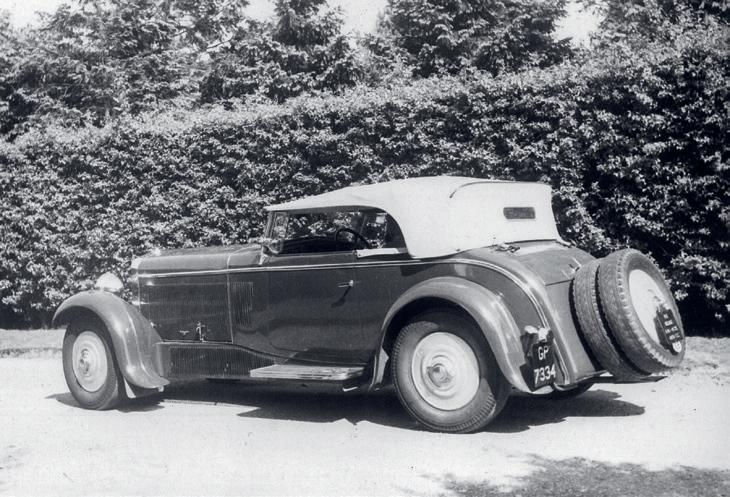
FOR 10 YEARS PRIOR TO WORLD WAR TWO, THE stunning Delage D8 was among the finest cars in the world of luxury automobiles, with its inline-eight motor developing 105bhp in initial 4.1-litre form. Over time its engine power would increase, but financial problems led to Delage’s takeover by its competitor Delahaye.
The D8 Sports model, which was introduced in 1930, used a shorter and lower chassis to improve handling via a reduced centre of gravity and firmer springing. The engine also produced 120bhp thanks to higher compression, a lighter flywheel and enhanced breathing. To make sure the car stopped appropriately, novel four-wheel hydraulic drum brakes were fitted. The D8 Sports model’s mixture of reliability and speed ensured it was a popular choice for gentleman racers in events such as the Tour de France Automobile and the Monte Carlo Rally.
This particular Delage, chassis no. 34785, was created as a one-off by the renowned coachbuilder Henri Chapron. It was subsequently owned by famous enthusiast George Milligen for nearly 40 years. The current keeper acquired the car in 2015, and a complete restoration was subsequently carried out by René Große Restaurierungen. Mr Hübner won Best of Show at the Concours of Elegance Germany 2024 with his 1939 Lancia Astura Pinin Farina Cabriolet.
ZEHN JAHRE VOR AUSBRUCH DES ZWEITEN WELTKRIEGS gehörte der 1929 eingeführte Delage D8 zu den edelsten Angeboten im weltweiten Luxuswagen-Segment. Auch wegen seines Reihenachtzylinders, der aus 4,1 Litern Hubraum anfangs 105 PS schöpfte. Die Leistung stieg in der Folge weiter, doch finanzielle Probleme führten schließlich zur Übernahme von Delage durch den Wettbewerber Delahaye.
Der 1930 eingeführte D8 Sports baute auf einem verkürzten und tiefergelegten Chassis auf, um über einen tieferen Schwerpunkt und straffere Federn das Handling zu verbessern. Parallel dazu erstarkte der Motor dank höherer Verdichtung, eines leichteren Schwungrads und eines optimierten Ansaugtrakts auf 120 PS. Um eine sichere Verzögerung

‘The D8 Sports model’s mixture of reliability and speed ensured it was a popular choice for gentleman racers’
„Die Kombination aus Zuverlässigkeit und hoher Geschwindigkeit machte den D8 Sports zur beliebten Wahl von Herrenfahrern“
zu garantieren, kamen rundum hydraulische Trommelbremsen zum Einsatz. Die Kombination aus Zuverlässigkeit und hoher Geschwindigkeit machte den D8 Sports zur beliebten Wahl von Herrenfahrern, die mit ihm Events wie die Tour de France Automobile oder die Rallye Monte Carlo bestritten.
Die Karosserie dieses speziellen Delage, Chassis # 34785, entstand 1931 als Unikat beim renommierten Karosseriebauer Henri Chapron. Er blieb zunächst für fast 40 Jahre im Besitz des berühmten Enthusiasten und Sammlers George Milligen; der aktuelle Besitzer erwarb den Wagen im Jahr 2015 und ließ ihn im Anschluss bei Réne Große Restaurierungen vollumfänglich restaurieren. Herr Hübner gewann mit seinem Lancia Astura Pinin Farina Cabriolet Baujahr 1939 den Preis „Best of Show“ beim Concours of Elegance Germany 2024.
1932 Austro-Daimler
Bergmeister
Private Collection
The Bergmeister’s first owner was Maria Matray, an actress from Berlin.
Erste Besitzerin des Bergmeisters war Maria Matray, eine Schauspielerin aus Berlin.

THE AUSTRO-DAIMLER MOTORENWERKE WERE founded in 1889 as a subsidiary of Daimler-MotorenGesellschaft from Cannstatt near Stuttgart. In the company’s early years, Gottlieb Daimler’s son Paul took over the management. Ferdinand Porsche served as technical director from 1906 to 1923, and he was responsible for the manufacturer’s major successes.
The Austro-Daimler Bergmeister is one of the most coveted Austrian vehicles; Austro-Daimler produced rolling chassis, while various coachbuilders created the bodies. This particular example was built by Heinrich Buhne in Berlin. Buhne specialised in taxis and low-cost bodies, but on occasion it made convertibles such as this one. The model was equipped with both a soft-top and a hard-top. Founded in 1919, Buhne‘s production effort would survive World War Two, which saw it produce bodies for fire-brigade vehicles and equipment trailers. The company was dissolved in 2005. This car was presented in Berlin in 1933, and its first owner was Maria Matray, an actress from Berlin. Matray was of Jewish descent, and she emigrated to America in 1934. The Austro-Daimler Bergmeister eventually ended up in Poland, and it was restored in the 1980s and driven until around 2000. A collector purchased it and kept it until 2014. The current owner then undertook an extensive restoration.
DIE AUSTRO-DAIMLER MOTORENWERKE WURDEN 1899 als Tochter der Daimler-Motoren-Gesellschaft aus Cannstatt gegründet. In den Anfangsjahren übernahm Gottlieb Daimlers Sohn Paul die Geschäftsführung; von 1906 bis 1923 fungierte Ferdinand Porsche als technischer Direktor und zeichnete für einige der größten Erfolge des Herstellers verantwortlich. Der Austro-Daimler Bergmeister gehört zu den begehrtesten Fahrzeugen österreichischer Provenienz. Austro-Daimler baute „rolling chassis“, auf die dann diverse Karosseriebauer ihre Aufbauten setzten. Dieses spezielle Exemplar erhielt seine Karosserie bei Heinrich Buhne in Berlin. Buhne hatte sich auf Taxis und preisgünstige Aufbauten auf Fahrgestellen spezialisiert, entwarf aber bei Gelegenheit auch Cabrios wie dieses, das sowohl

‘The Bergmeister is one of the most coveted Austrian vehicles; this example was built by Heinrich Buhne’
„Der Bergmeister gehört zu den begehrtesten Fahrzeugen österreichischer Provenienz; dieses Exemplar entstand bei Heinrich Buhne“
mit einem Soft- wie einem Hardtop ausgestattet war. Nach dem Zweiten Weltkrieg machte der 1919 gegründete Stellmacherbetrieb Bruhne mit Spezialaufbauten für Feuerwehr-Fahrzeuge und -Geräteanhänger weiter und wurde 2005 aufgelöst.
Dieser Austro-Daimler wurde 1933 in Berlin gezeigt; seine erste Besitzerin war die bekannte Berliner Schauspielerin Maria Matray. Da jüdischer Abstammung, emigrierte sie 1934 mit ihrem Mann nach Amerika. Der Austro-Daimler Bergmeister tauchte später in Polen auf, wurde in den 1980er-Jahren erstmals restauriert und etwa bis ins Jahr 2000 bewegt. Dann kaufte ihn ein Sammler und behielt ihn bis 2014. Bis der aktuelle Besitzer eine umfangreiche Restaurierung in Angriff nahm.
HUBER KARL
1936 Horch 853
Claus Merk
IN THE 1930S, HORCH MADE A NAME FOR ITSELF BY bringing Mercedes-Benz-style luxury at a price attainable to a wider range of people – a group made up of Germany’s rich and famous. The 853 model was particularly popular, thanks its winning combination of potent overhead-cam, ten main-bearing, straight-eight engine, short wheelbase and technology derived from the Auto Union race cars backed by Horch alongside DKW, Audi and Wanderer – most notably the then-exotic de Dion rear axle. The 853 was further developed for the 853 A model, which took power to 120bhp. It’s believed that only 50 examples of the Horch 853 remain.
This particular car was painted in grey camouflage colours during World War Two, and it bore the licence plate WH 425523. It was used by a general during the conflict, but it was abandoned in Prague during the retreat and then returned to Munich, where it was used by a local doctor.
In 1989 the car passed into the hands of a Hans L Zausinger, who had been responsible for the stadium lighting at the 1972 Olympic Games in Munich. More recently, between 2005-07 the Horch was restored by specialist Werner Zinke near Zwickau.
IN DEN 1930ER-JAHREN MACHTE SICH HORCH EINEN namen durch im Mercedes-Benz-Stil gestylte Modelle, die aufgrund erschwinglicher Preise innerhalb der Gruppe der Reichen und Schönen Deutschlands einer breiteren Schicht offenstanden. Seit 1932 war Horch zusammen mit DKW, Audi und Wanderer Mitglied der Auto Union, und das Modell 853 erwies sich dank seiner Kombination aus zehnfach gelagertem OHC-Reihenachtzylinder, kurzem Radstand und von den Auto-Union-Rennwagen abgeleiteten Technologien – allen voran die damals exotische de-Dion-Hinterachse – als besonders populär. Der 853 wurde weiter zum 853 A entwickelt, mit auf 120 PS gesteigerter Leistung. Man nimmt an, dass heute nur noch 50 Exemplare des Horch 853 existieren.
Dieses besondere Modell war während des Zweiten Weltkriegs in grauen Tarnfarben lackiert und trug das Kennzeichen WH 425523. Es wurde während des Konflikts von einem General benutzt, aber während des Rückzugs der deutschen Truppen in Prag zurückgelassen. Später nach München zurückgebracht, erwarb ihn ein dortiger Arzt. 1989 kam der Horch in den Besitz von Hans L. Zausinger, der bei den Olympischen Spielen von 1972 in München für die Stadionbeleuchtung verantwortlich zeichnete. In jüngerer Vergangenheit, zwischen 2005 und 2007, wurde der 853 vom Spezialisten Werner Zinke nahe Zwickau restauriert.
‘This car was used by a general during World War Two, but it was abandoned in Prague during the retreat’
„Dieser
Wagen wurde während des Zweiten Weltkriegs von einem General benutzt, aber während des Rückzugs in Prag zurückgelassen“

Between 2005 and 2007 the Horch 853 was restored by specialist Werner Zinke.
Zwischen 2005 und 2007 wurde der Horch 853 beim Spezialisten Werner Zinke restauriert.
1938 Bugatti Type 57C Stelvio by Gangloff
Prof Dr-Ing Andreas Biagosch
Now carefully restored, this car’s unbroken history is documented through period photos.
Die ununterbrochene Historie des nun sorgfältig restaurierten Wagens wird durch zeitgenössische Fotos dokumentiert.
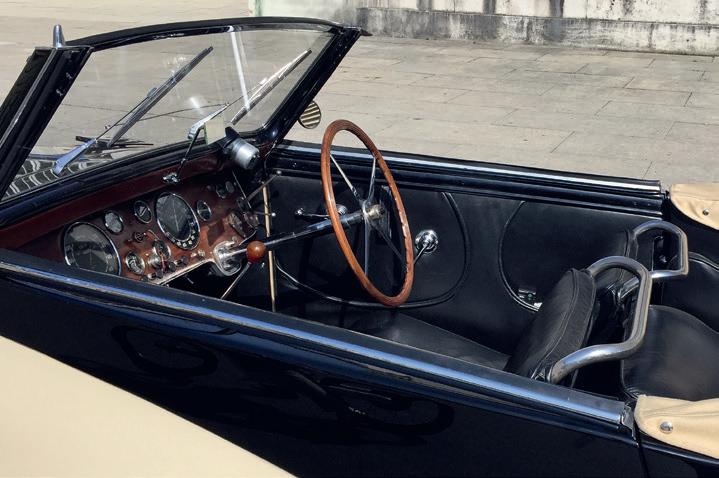
EVEN THOUGH BUGATTI HAD NOTCHED UP AN unmatched number of racing victories worldwide, it still had to design and sell elegant, high-quality vehicles in order to finance its motor sport successes. The Type 57 Stelvio fourseater convertible was introduced at October 1936’s Paris Motor Show. Its race-proven 3.3-litre inline-eight, developed from the Type 49 but updated with timing gears rather than timing chains, delivered 160bhp with a supercharger, making the Type 57 one of the fastest cars of its time.
The model shown here, chassis number 57467, was registered in February 1938 and delivered to a Bugatti collector by the name of Dr Kocher, ending up as one of the highlights of his 14-strong Bugatti fleet. It is the first Type 57 Stelvio sold with a supercharger, bearing engine number C2 (C1 remained at the factory as a development and test vehicle).
This car’s unbroken history is documented through period photographs, always showing its distinctive bumpers. Postwar modifications, such as a garden hose for the fuel overflow and a gutter as a heat shield, have long since been corrected. After careful restoration, the Bugatti is occasionally presented at concours events by the current owner –including at Concorso d’Eleganza Villa d’Este in 2022.
AUCH WENN BUGATTI WELTWEIT UNZÄHLIGE
Siege auf der Rennstrecke errungen hatte, musste man zur Finanzierung des Motorsport-Programms weiterhin extrem elegante und hochwertige Straßenfahrzeuge entwickeln und verkaufen. Das viersitzige Cabrio T57 Stelvio wurde im Oktober 1936 auf dem Pariser Salon präsentiert. Sein rennerprobter 3,3-Liter-Reihenachtzylinder übernahm nur den Hubraum des T49-Motors, leistete jedoch dank eines Antriebs seiner beiden Nockenwellen über Stirnräder (statt Steuerketten) und Kompressor-Unterstützung 160 PS. Damit war der T57 eines der schnellsten Automobile seiner Zeit.
Das hier gezeigte Exemplar (Chassis 57467) wurde im Februar 1938 zugelassen und zog als ein Highlight in die 14 Modelle starke Bugatti-Sammlung eines Dr. Kocher ein. Es handelt sich um den ersten T57 Stelvio mit Kompressor
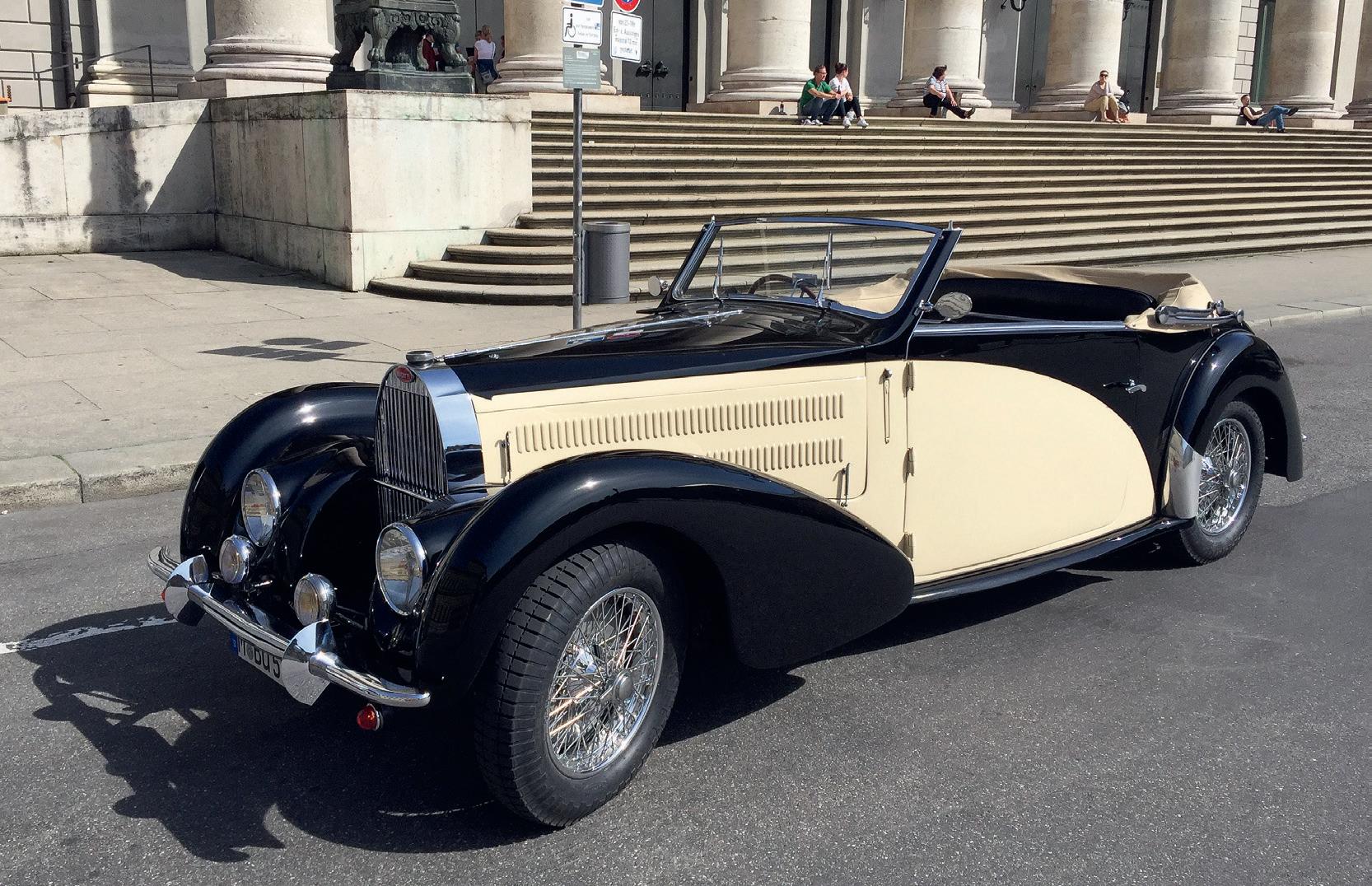
‘Its supercharged 3.3-litre inline-eight delivered 160bhp, making it one of the fastest cars of its time’
„Sein per Kompressor aufgeladener 3,3-LiterReihenachtzylinder leistete 160 PS und machte ihn zu einem der schnellsten Autos seiner Zeit“
und der Motornummer C2 (C1 verblieb im Werk, als Test- und Entwicklungsmodell). Die ununterbrochene Historie des Wagens ist durch zeitgenössische Fotos dokumentiert, immer darauf zu sehen: die auffälligen Stoßstangen. Nachkriegs-Modifikationen wie ein Gartenschlauch für den Kraftstoffüberlauf und eine Dachrinne als Hitzeschild wurden längst behoben. Nach einer sorgfältigen Restaurierung wird der Bugatti von seinem aktuellen Besitzer gelegentlich bei Concours-Events gezeigt – darunter 2022 beim Concorso d’Eleganza Villa d’Este.
1938 Bentley 4 ¼ Litre MR Overdrive Barouche de Ville by James Young
Axel Schröter

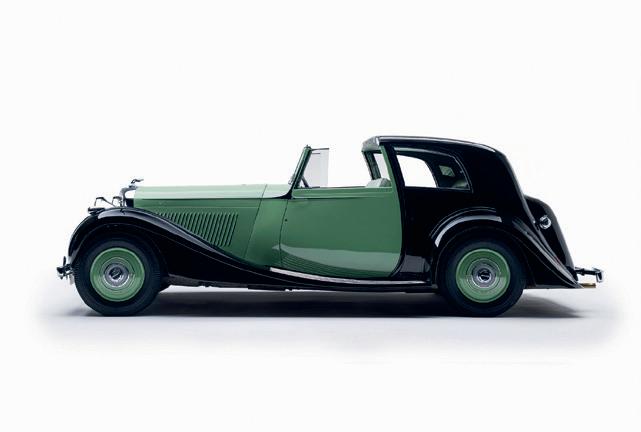
THIS UNIQUE BENTLEY WAS BUILT FOR THE JAMES Young stand at the 1938 Earls Court Motor Show. Chassis B38MR was illustrated in the ‘show numbers’ of The Autocar and The Motor, as well as in Jack Barclay’s advertising. The design is entirely unique, and it was attributed to AF McNeil – arguably the most influential British coachwork designer of the interwar years. He had joined James Young from Gurney Nutting in 1937 when it became part of the Jack Barclay group. B38MR was bought off the show stand by the Marquess of Dufferin and Ava, who retained the Bentley until shortly after the outbreak of World War Two. The car then passed into the hands of Sir Richard Costain of London – a civil engineer whose company was busily engaged in building airfields and factories throughout the country.
Costain apparently used the Bentley throughout the war, and then sold it to Sir Geoffrey Winterbotham in 1946. After a stint in the US, the car returned to the UK in the 1980s in the stewardship of Charles Howard. It then came into the possession of P Cockeram, who spent more than £100,000 keeping it in good order. Since 2019 it has been in the hands of the current owner, who has restored the Bentley including a full interior rebuild that was completed in 2023.
DIESER BENTLEY WURDE FÜR DEN STAND DES Karosseriebauers James Young auf der Earls Court Motor Show von 1938 in Auftrag gegeben. Chassis #B38MR tauchte in Wort und Bild sowohl in den „Messeausgaben“ der Fachzeitschriften The Autocar und The Motor als auch in Anzeigen von Jack Barclay, Englands größtem Rolls-Royceund Bentley-Händler, auf.
Das Design ist absolut einzigartig und wird AF McNeil zugeschrieben – fraglos einer der einflussreichsten britischen Karosseriedesigner der Zwischenkriegszeit. Er hatte sich 1937, vom Coachbuilder Gurney Nutting kommend, James Young angeschlossen, als dieser wiederum Teil der Jack Barclay Group wurde. Der Marquess of Dufferin and Ava erwarb #B38MR noch auf der Messe und behielt ihn bis kurz nach Ausbruch des Zweiten Weltkriegs. Danach gelangte der Bentley in den Besitz von Sir Richard Costain aus London – ein Bauingenieur, dessen Unternehmen im ganzen Land mit dem Bau von Flugplätzen und Munitionsfabriken beschäftigt war.
Costain nutzte das Fahrzeug offenbar während der gesamten Kriegszeit, ehe er es 1946 an Sir Geoffrey Winterbotham verkaufte. Nach einem Intermezzo in den USA kehrte der Wagen in den 1980er-Jahren ins Vereinigte Königreich und dort in die
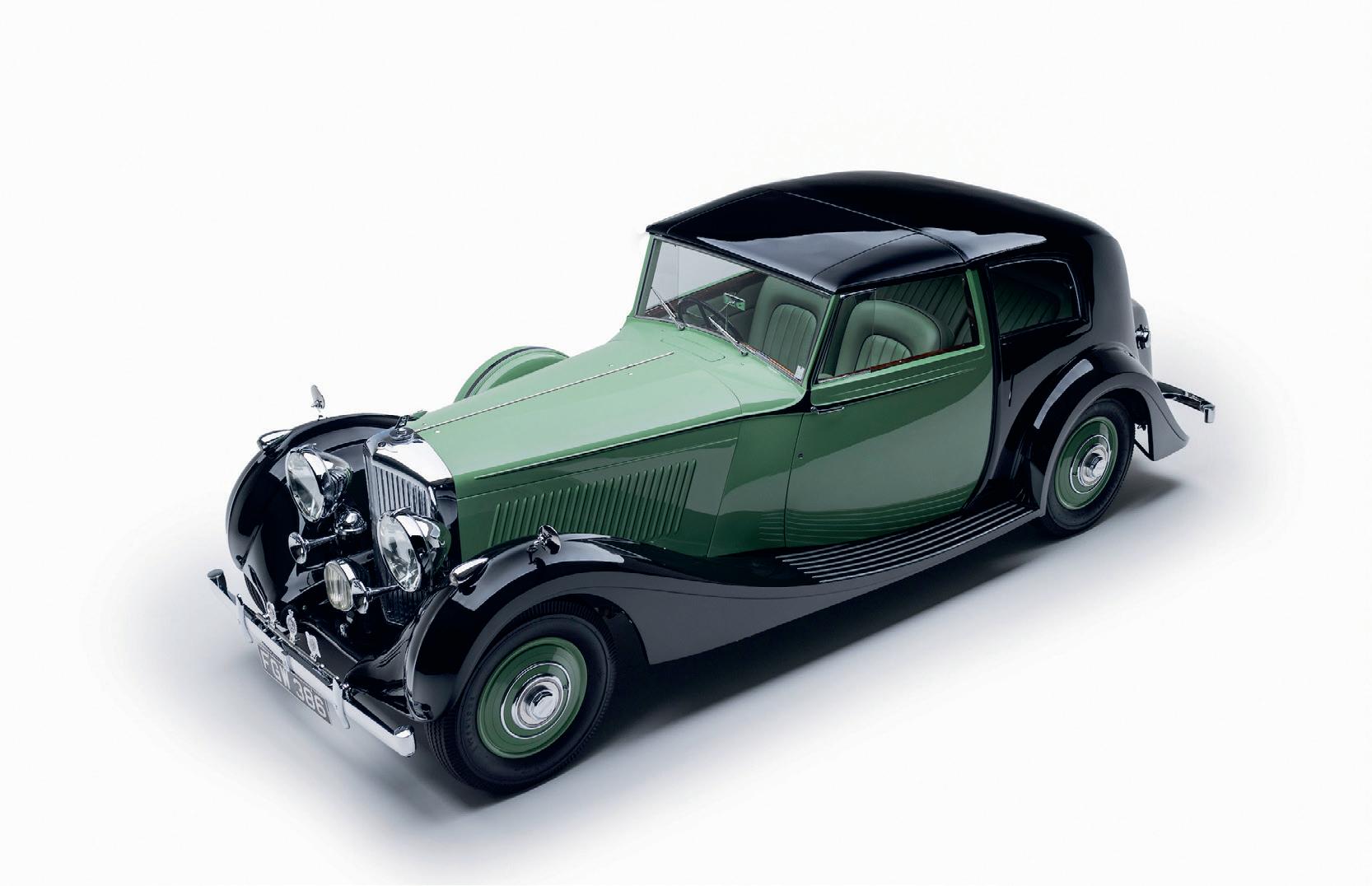
‘Design was attributed to AF McNeil – arguably Britain’s most influential coachwork designer of the interwar years’
„Das Styling wurde AF McNeil zugeschrieben –fraglos einer der einflussreichsten britischen Karosseriedesigner der Zwischenkriegszeit“
Obhut von Charles Howard zurück. Als nächstes kam der Bentley in die Garage von P Cockeram, der über £100.000 investierte, um ihn in einem guten Zustand zu halten. Seit 2019 ist der in einer wunderschönen Zweifarblackierung (schwarz/grün) glänzende
4 ¼ Litre bei seinem aktuellen Besitzer, der ihn einschließlich einer kompletten Auffrischung des Interieurs einer erst 2023 abgeschlossenen Restaurierung unterzog.
Der Bentley feierte sein Debüt auf dem Stand von James Young für die Earls Court Motor Show des Jahres 1938.
The Bentley appeared on the James Young stand at the 1938 Earls Court Motor Show.
1930 Alfa Romeo 6C 1750 Gran Sport by Zagato
Prof Dr-Ing Andreas Biagosch
The owner says that this Alfa Romeo 6C, chassis 8531033, is a fantastic car to drive.
Laut seinem Besitzer ist dieser Alfa Romeo 8C, Chassis 8531033, ein phantastisch zu fahrendes Auto.

WHEN THE FAMOUS RACING DRIVER RUDOLF
Caracciola conducted his first test drives with the Alfa Romeo 6C in the Italian Alps, he is said to have remarked: “It dances through the corners.” This was an unsurprising observation – he had come from the heavy supercharged Mercedes cars to the Alfa racing team, as led by none other than Enzo Ferrari. Here, he drove a race machine also equipped with a supercharger but weighing just over 700kg – roughly half the weight of the Mercedes models. With their attractive and lightweight Zagato bodies, the 6C and, later, the 8C Alfas proved to be highly successful race cars.
It is possible that the example seen here participated in the 1931 Mille Miglia with Luigi Scarfiotti – father of Ludovico, the highly successful Ferrari and Porsche Works driver in the 1960s – at the wheel. It has certainly taken part in Mille Miglias since the revival of the legendary event back in 1977. In 2013, this Alfa won its class at the Sachsen Classic. This Series IV variant wears chassis number 8513033 and engine number 6C 8531033. It was overhauled in the early 2000s by Alfa Romeo expert Jim Stokes in England. The owner says that it is a fantastic car to drive – once you get used to the original pedal layout: the accelerator is in the middle and the brake lever is on the right.
ALS DER BERÜHMTE DEUTSCHE RENNFAHRER RUDOLF
Caracciola seine ersten Testfahrten auf einem Alfa Romeo 6C in den italienischen Alpen absolvierte, soll er gesagt haben: „Er tanzt durch die Kurven.“ Keine überraschende Beobachtung – war er doch von einem schwergewichtigen Kompressor-Mercedes in das von keinem Geringeren als Enzo Ferrari geleitete Alfa-Team gewechselt. Hier fuhr er zwar auch einen Rennwagen mit Kompressor, der jedoch nur 700 Kilo wog – nur rund halb so viel wie sein früherer Mercedes. Mit ihren attraktiven und leichtgewichtigen Zagato-Karosserien erwiesen sich die 6C und späteren 8C Alfa als höchst erfolgreiche Rennwagen. Es ist möglich, dass dieses hier abgebildete Exemplar 1931 mit Luigi Scarfiotti, Vater des in den 60er-Jahren sehr erfolgreichen Ferrari- und Porsche Werkspiloten Ludovico Scarfiotti, an der

‘It is possible that the Alfa participated in the 1931 Mille Miglia with Luigi Scarfiotti behind the wheel’
„Es ist möglich, dass dieser Alfa Romeo mit Luigi Scarfiotti am Steuer 1931 an der Mille Miglia teilgenommen hat“
Mille Miglia teilgenommen hat. Sehr sicher aber an jeder Ausgabe der seit 1977 als Gleichmäßigkeitsfahrt wieder neu aufgelegten Mille Miglia. 2013 gewann dieser Alfa seine Klasse bei der Sachsen Classic.
Diese Serie IV-Variante trägt die Chassisnummer 8513033 und die Motornummer 6C 8531003. Anfang der 2000er-Jahre wurde der Grand Sport vom Alfa-Romeo-Experten Jim Stokes in England komplett überholt. Laut seinem Besitzer ist es ein fantastisch zu fahrendes Auto. Sobald man sich an die ungewohnte Stellung der Pedale gewöhnt hat: Gas in der Mitte und die Bremse rechts davon.
1939 Talbot-Lago T23 Baby Cabriolet Prototype by Chapron
Ralph & Marion Stadler
This Henri Chapronbodied model it is a prototype on an unusual chassis.
Dieses Modell mit einer Karosserie von Henri Chapron war ein Prototyp auf einem speziellen Chassis.

ANY TALBOT-LAGO T23 IS SPECIAL, BUT THIS ONE even more so – not only does it have a Henri Chapron body, but it is a prototype on an unusual chassis. It was built just before France and Britain declared war on Germany on September 3, 1939, and thus its first owner couldn’t take delivery. It is believed to have remained the property of Talbot and was hidden during the war years in a safe space.
After the war the T23 was retailed by dealer and racing driver Charles Huc, and acquired by a Charles Castex, a Bordeaux shopkeeper, who kept it for two years before selling it to a furniture dealer by the name of Charles Bayle. In 1954, it was acquired by Richard Cross, who later sold it to Robert Cornish, an American soldier who was stationed at the US base in nearby Mérignac, in 1955.
Harold P Christensen, stationed at the same base, acquired the car less than a year later and imported it to the US. In 1963 it was sold to Donald L Rutherford, who was stationed at the Warren Air Force base in Cheyenne, Wyoming. He kept it all the way up to 1990, when he sold it to a James O’Tallman, who changed the colour from brilliant black to matt black. In around 2009 the T23 was returned to France as a wreck, and it was soon restored to its original specifications.
JEDER TALBOT-LAGO T23 IST SPEZIELL – UND DIESER ganz besonders. Nicht nur erhielt er eine Karosserie von Henri Chapron, sondern als Prototyp auch ein ungewöhnliches Chassis. Er wurde kurz vor der französischen Kriegserklärung an Deutschland (3. September 1939) fertiggestellt. Mit der Konsequenz, dass der Wagen im Besitz von Talbot blieb, nicht ausgeliefert und dann während des gesamten Krieges sicher versteckt wurde.
Nach Kriegsende erwarb ihn der Händler und Rennfahrer Charles Huc. Von dort ging der Talbot an Charles Castex, einen Geschäftsinhaber aus Bordeaux, der ihn zwei Jahre behielt und dann an einen Möbelhändler namens Charles Bayle verkaufte. 1954 gelangte das Auto in den Besitz von Richard Cross, der es 1955 an Robert Cornish verkaufte, ein auf der nahegelegenen US-Militärbasis Mérignac stationierter US-Soldat.

‘In around 2009 the T23 was returned to France as a wreck, and it was soon restored to its original specifications’
„Um das Jahr 2009 kehrte der T23 als Wrack nach Frankreich zurück, wo er schon bald nach den originalen Spezifikationen restauriert wurde“
Nur ein Jahr später erwarb der auf derselben Basis stationierte Harold P. Christensen den T23 und importierte ihn in die USA. 1963 sah den nächsten Besitzerwechsel, diesmal an Donald L Rutherford, stationiert auf der Warren Air Force Base in Cheyenne, Wyoming. Er behielt den Wagen bis 1990 und verkaufte ihn dann an James O’Tallman, der das Cabrio von glänzend Schwarz auf matt Schwarz umlackieren ließ. Um das Jahr 2009 kehrte der T23 als Wrack nach Frankreich zurück, wo er schon bald zurück zu altem Glanz und nach den originalen Spezifikationen restauriert wurde.
1939 Alfa Romeo 6C 2500 Sport
Oskar Baumann
The Alfa’s original body was lost in the 1950s; a Touring body was later fitted from a sister car.
Die Original-Karosserie des Alfas ging in den 50er-Jahren verloren; sie wurde später ersetzt durch die TouringKarosse eines Schwestermodells.
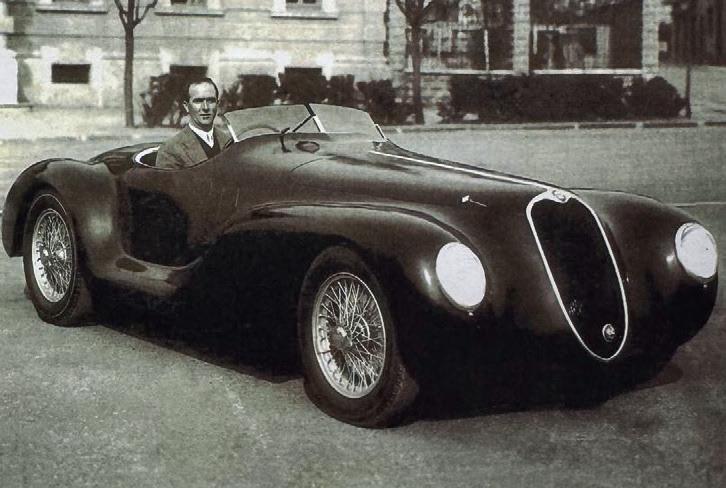
THE 6C 2500 WAS THE LAST OF THE CLASSIC pre-war Alfa Romeos, and it bridged the gap between pre- and post-World War Two automotive design. The 2.5-litre straight-six engine was an evolution of Vittorio Jano’s earlier 6C designs, and in Sport form it produced from 105bhp to 125bhp depending on the version and the carburettors used. Based on the body and the state of engine tune, this was enough for between 145km/h and 155km/h.
The Sport used a shorter wheelbase than the Turismo model, measuring 3000mm compared to the latter’s 3250mm. The 6C would form the canvas for automotive art courtesy of coachbuilders such as Touring, Pinin Farina, Ghia, Zagato and Boneschi. Although not primarily a racing chassis – that was more the preserve of the even shorter Super Sport model – the Sport was used in the Mille Miglia, Targa Florio and many privateer hill climbs and endurance events.
This particular car’s original body had been lost by the late 1950s. In the 1990s, the chassis was rebuilt and a Touring body sourced from another 6C, a Tipo 256 Corsa Spyder; this was located in South America, having been removed and saved when the Tipo 256 had been rebodied in the early post-war period. The new panelwork was carefully restored before being fitted in 1999. The car made its debut on the 2000 Mille Miglia retrospective.
DER 6C 2500 WAR DER LETZTE DER KLASSISCHEN Vorkriegs-Alfa Romeo und leitete den Übergang vom Automobildesign der Vor- zur Nachkriegszeit ein. Sein 2,5Liter-Reihensechszylinder war eine Evolution früherer 6C-Entwürfe von Vittorio Jano und leistete in der „Sport“Ausführung je nach der Version und Vergaser-Anlage zwischen 105 und 125 PS. Was sich in Abhängigkeit vom Karosserietyp und der Tuning-Stufe in Höchstgeschwindigkeiten zwischen 145 und 155 km/h niederschlug.
Das Sport-Modell basiert auf einem kürzeren Radstand als die Turismo-Version – 3000 gegenüber 3250 Millimeter. Der 6C bot die Leinwand für Karosseriebauer wie Touring, Pinin Farina, Ghia, Zagato und Boneschi. Obwohl streng

‘The Alfa Romeo 6C 2500 bridged the gap between pre- and post-World War Two automotive design’
„Der Alfa Romeo 6C 2500 leitete den Übergang vom Automobildesign der Vor- zur Nachkriegszeit ein“
genommen ohne ein Rennwagen-Chassis – das war eher das Reservat des noch kürzeren Super-Sport-Modells – kam der Sport bei der Targa Florio, der Mille Miglia und vielen lokalen Bergrennen und Langstreckenprüfungen zum Einsatz. Die Original-Karosserie dieses speziellen Exemplars ging Ende der 1950er-Jahre verloren. Im Zuge eines Neuaufbaus des Chassis in den 90er-Jahren wurde das Auto mit der Touring-Karosserie eines anderen 6C, eines Tipo 256 Corsa Spyder, eingekleidet. Diese befand sich in Südamerika, wo sie demontiert, aber aufbewahrt worden war, nachdem der Tipo 256 in der unmittelbaren Nachkriegs-Zeit eine neue Hülle erhalten hatte. Vor der Montage im Jahr 1999 wurde sie sorgfältig restauriert – und in diesem Gewand feierte das Auto bei der Mille Miglia des Jahres 2000 sein Debüt.
1939 Bugatti Type 57 Stelvio
Klaus Dold
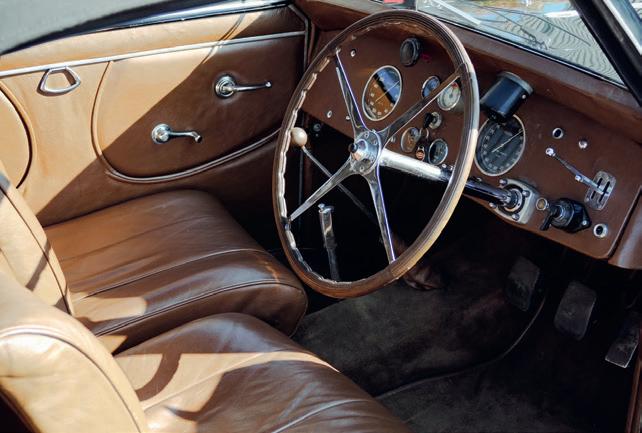

THIS BUGATTI TYPE 57 IS ONE OF EIGHT SURVIVING naturally aspirated four-seater dropheads – and until this year it’d had only two owners since it was built.
The story began in October 1938, when chassis 57719 was assembled. It was ordered by Bugatti’s Geneva agent, Jean Sechaud, in November that year, and sent to Gangloff for a four-seater body. Finished just before Christmas Eve, it was delivered to Sechaud on January 9, 1939 and subsequently sold to Henri Louis Charles Niess, a Lausanne-based lawyer and consulting advocate for the Automobile Club Suisse in Vaud. The Bugatti was his sole car until 1947, and he only sold it after it suffered propshaft trouble, and because he wanted a Bentley MkVI instead. It was a decision he’d regret.
The Bugatti went to Hans Wassmer in the Argovie canton. He changed the exterior colour from black to two-tone black and blue, and the seats from red leather to brown. Come 1960 – and with 235,000km on the clock – the car was overhauled for the second time, and later used by Wassmer’s son, Franz, on several rallies until his passing in 2024. In 2025, the Bugatti was acquired by Klaus Dold.
DIESER BUGATTI TYP 57 IST EINES VON ACHT
Überlebenden viersitzigen Cabriolets mit AchtzylinderSaugmotor – und hatte bis zu diesem Jahr erst zwei Besitzer. Die Geschichte des Autos begann im Oktober 1938 mit dem Bau des „rolling chassis“ in Molsheim. Besteller war Bugattis Genfer Agent Jean Sechaud, der das „nackte“ Chassis mit dem Auftrag für eine viersitzige Karosserie an die auf Sonderkarosserien für Luxusmodelle spezialisierte Carosserie Gangloff aus Colmar lieferte. Kurz vor Heiligabend fertiggestellt, ging der T57 Stelvio am 9. Januar 1939 zurück an Sechaud, der ihn dann an Henri Louis Charles Niess verkaufte, einen in

‘Niess sold the Bugatti Type 57 because he wanted a Bentley MkVI instead. It was a decision he’d regret’
„Niess verkaufte den Bugatti Typ 57, weil er stattdessen einen Bentley MkVI wollte. Eine Entscheidung, die er bereuen sollte“
Lausanne tätigen Rechtsanwalt und Rechtsberater des Automobile Club Suisse im Wallis. Der Bugatti war bis 1947 sein einziges Auto, dann verkaufte er ihn wegen Problemen mit der Kardanwelle und weil er stattdessen einen Bentley MkVI wollte. Eine Entscheidung, die er bereuen sollte. Der Bugatti fand danach ein neues Zuhause bei Hans Wassmer aus dem Kanton Aargau. Er ließ die Karosserie von Schwarz auf eine Zweifarb-Optik in Schwarz/Blau umlackieren und die Sitze mit braunem statt rotem Leder beziehen. 1960 – mit 235.000 Kilometern auf der Uhr – wurde der T57 „Drophead“ ein zweites Mal komplett durchgecheckt und später von Wassmers Sohn Franz bis zu dessen Ableben im Jahr 2024 bei diversen Rallyes eingesetzt. 2025 erwarb Klaus Dold den Bugatti.
One of eight surviving four-seater dropheads, until this year this car had only two owners.
Eines von acht noch existenten viersitzigen Cabrios mit Saugmotor. Bis zu diesem Jahr hatte es erst zwei Besitzer.
1938 Horch 855
Wilhelm Leuze


THE HORCH 855 WAS LAUNCHED IN BERLIN IN 1935, at the International Automobile and Motorcycle Exhibition at the Capitol movie theatre, which had been turned into a showroom for the event. The series designation 855 refers to eight cylinders, with 5.0-litre capacity, while the final digit ‘5’ refers to the Special roadster. It is believed today that five production cars and two prototypes were built, powered by the 120bhp straight-eight engine.
This car was one of the prototypes. It was discovered in Russia and came back to Germany via the Kohlberg Museum in Lithuania. The restoration was executed by Werner Zinke, in close association with Audi Tradition.
The world’s leading Horch and Auto Union historian, the late Prof Dr Kirchberg, confirmed the authenticity of this prototype through meticulous detail work involving scientific analyses and material testing.
The frame of the vehicle presented has a wheelbase of 3350mm, which no other large Horch features – another indication that this is indeed a prototype for the 855. The design of the frame shows efforts to save weight. It does not have a cross-brace structure as with the 853, but rather crossmembers with three beams. Featuring independent front suspension, a de Dion rear axle and hydraulic dampers all round, the 855 was a technical marvel. Upon launch it was the most expensive and exclusive Horch available, at 22,000RM.
DER HORCH 855 WURDE 1935 IN BERLIN AUF DER Internationalen Automobil- und Motorradaustellung im Kino „Capitol“ vorgestellt, das für diesen Anlass in einen Ausstellungsraum verwandelt worden war. Die Modellbezeichnung 855 steht für 8 Zylinder mit 5 Litern Hubraum; die finale Ziffer „5“ für einen Spezial Roadster. Man geht heute davon aus, dass fünf Serienmodelle und zwei Prototypen entstanden, angetrieben von einem Reihenachtzylinder mit 120 PS.
Dieses Auto war einer der Prototypen, wurde in Russland entdeckt und gelangte über das litauische Kohlberg-Museum zurück nach Deutschland. In enger Kooperation mit Audi Tradition wurde es von Werner Zinke restauriert. Der weltweit führende und inzwischen verstorbene Horch- und Auto-UnionSpezialist Professor Doktor Kirchberg bestätigte durch akribische Detailarbeit in Form wissenschaftlicher Analysen und Materialproben die Echtheit dieses Prototyps.
Der Rahmen des vorgestellten Fahrzeugs basiert auf einem Radstand von 3350 Millimetern – eine Besonderheit, die so bei

‘The late Prof Dr Kirchberg confirmed the authenticity of this prototype through meticulous detail work’
„Der verstorbene Prof. Dr. Kirchberg bestätigte durch akribische Detailarbeit die Echtheit dieses Prototyps“
keinem anderen Horch zu finden und ein weiterer Indikator für den Prototypen-Status dieses 855 ist. Die Konstruktion des Leiterrahmens zeugt von Maßnahmen zur Gewichtsreduzierung; daher besitzt er keine Kreuztraversen wie der 853, sondern Quertraversen mit drei Trägern. Mit einer vorderen Einzelradaufhängung, einer de-Dion-Hinterachse und hydraulischen Stoßdämpfern rundum war der 855 ein technisches Wunderwerk. Bei seiner Markteinführung war er mit einem Preis von 22.000 RM der teuerste und exklusivste Horch im Programm.
The most exclusive Horch available upon launch, the 855 was a technical marvel.
Der 855 war bei seiner Vorstellung der exklusivste Horch und ein technisches Wunderwerk.
1946 Delahaye 135M 3-Position DHC by Pennock
Roland Duce
The 135M was an impressive contender, doing especially well on the Monte Carlo Rally.
Der 135M war ein eindrucksvoller Starter und speziell bei der Rallye Monte Carlo erfolgreich.
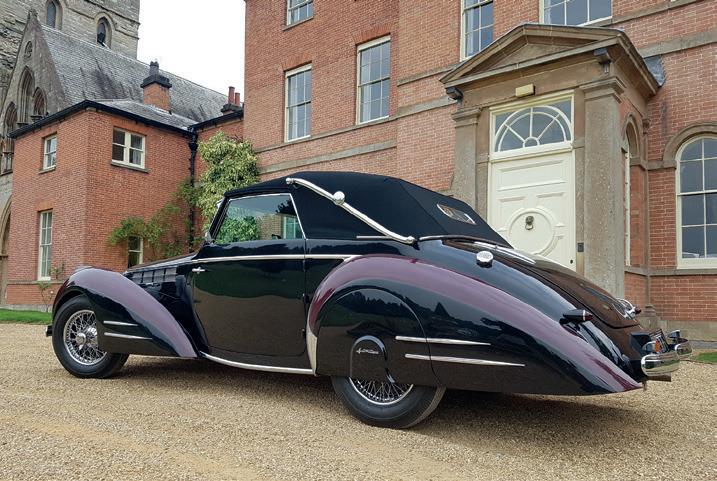
DELAHAYE’S 135 SERIES WAS THE CANVAS FOR SOME of the motoring world’s most stylish creations, but in 135M form it was also a formidable motor sport contender. The ‘M’ in the name stood for ‘Modifiée’, and over its long life its smooth straight-six was available with several displacements as well as with various carburettor counts. Depending on whether it had one, two or three carbs, the engine could produce anywhere from approximately 90bhp to 130bhp.
The chassis was no less impressive; its ladder frame was strong yet light. The 135M’s independent front suspension was advanced for the time, considering that most of its rivals had a solid front axle. The rear set-up used a live axle with semi-elliptical leaf springs, which was more common for the era – but this simplicity, allied with the straight-six’s reliability, meant that the 135M was a potent competitor. As a result, the closely related 135CS won the 1938 Le Mans 24 Hours, and 135M models also notched up impressive results on the Monte Carlo Rally throughout the 1930s.
This particular car features bodywork by Pennock, which paid Henri Chapron a design fee. The car has been in the UK all its life and is well known within Delahaye circles.
DELAHAYES 135 SERIE WAR DIE VORLAGE FÜR EINIGE DER stilvollsten Kreationen der Automobilwelt. Doch in Gestalt des 135 M war sie auch ein formidabler Motorsport-Teilnehmer Der Buchstabe „M“ stand für „Modifiée“, und während der langen Laufzeit des Modells war sein seidiger Reihensechszylinder mit unterschiedlichen Hubräumen und Vergaser-Batterien erhältlich. Je nachdem, ob mit einem, zwei oder drei Vergasern bestückt, leistete das Triebwerk zwischen 90 und 130 PS.
Das Chassis mit seinem zugleich stabilen wie leichten Leiterrahmen war kaum weniger eindrucksvoll. Auch die vordere Einzelradaufhängung war für die Zeit fortschrittlich, wenn man bedenkt, dass die meisten Rivalen noch eine Starrachse hatten. Eine solche kam dafür hinten zum Einsatz, zusammen mit halbelliptischen Blattfedern, was zu dieser Zeit aber üblich war. Doch diese Einfachheit, gepaart mit der Zuverlässigkeit des Reihensechszylinders, machte den 135M

‘Featuring bodywork by Pennock, this car has been in the UK all its life and is well known within Delahaye circles’
„Mit einer Karosserie von Pennock verbrachte dieser Wagen sein ganzes Leben im UK und ist in Delahaye-Kreisen bestens bekannt“
zu einem starken Konkurrenten auf den Pisten. Infolgedessen gewann der eng verwandte 135CS die 24 Stunden von Le Mans von 1938, und 135M-Typen erzielten in den 1930er-Jahren beeindruckende Resultate bei der Rallye Monte Carlo. Dieses besondere Exemplar verfügt über eine Karosserie des holländischen Karosseriebauers Pennock, der Henri Chapron dafür ein Designhonorar zahlte. Dieser 135M befand sich sein ganzes Autoleben lang in Großbritannien und ist in Delahaye-Kreisen bestens bekannt.
1948 Bentley MkVI Mysore Drophead Coupé by Park Ward
Nishant Dossa

THE MKVI WAS BENTLEY’S FIRST NEW CAR following the cessation of World War Two, and the first Bentley you could buy with factory coachwork. It needed to be a success – and fortunately it was, despite the poor steel forced upon the firm by the then government. It didn’t take long for the solid fundamentals to be used as a canvas for more extrovert bodies, and the car before you is one such example. This example was commissioned by Captain ST Binstead on behalf of the Maharaja of Mysore. As one of the richest people in the world during the days of British Raj, over the years the Maharaja’s palace garages were home to more than 20 Rolls-Royce and Bentley motor cars. All of these were custom-built bespoke models. He was particularly fond of the MkVI, and so ordered a total of seven such vehicles. This particular Park Ward Drophead Coupé was finished in a two-tone blue combination. The car went from Mysore to Bharatpur, on account of the families being related. In the 1990s it was acquired by the Dossa family, and it has recently been totally restored back to its former glory by P&A Wood.
DER MKVI WAR BENTLEYS ERSTER NEUER WAGEN nach dem Zweiten Weltkrieg und der Erste, den man mit einer Werkskarosserie kaufen konnte. Er musste ein Erfolg werden – und wurde es zum Glück, trotz des schlechten Stahls, den die damalige Regierung dem Unternehmen aufzwang. Es dauerte nicht lange, bis die soliden Grundlagen als Blaupause für extrovertiertere Karosserien dienen konnten – und das Auto vor Ihnen ist ein solches Beispiel.
Dieses Exemplar wurde von Captain ST Binstead im Auftrag des Maharadschas von Mysore bestellt. Als einer der reichsten Männer in der Zeit der britischen Herrschaft über Indien füllte er seine Palastgaragen über die Jahre mit über 200 Rolls-Royce und Bentley. Alle waren spezielle, maßanfertigte Einzelstücke. Der Herrscher schätzte den MkVI besonders und orderte gleich sieben Modelle dieses Typs.
Dieses spezielle Park Ward Drophead Coupé wurde in einer Kombination aus zwei Blautönen lackiert. Der Wagen ging von Mysore nach Bharatpur, aufgrund der Verwandtschaft der Familien. In den 1990er-Jahren erwarb ihn die Dossa Familie; kürzlich wurde er von P & A Wood zu seiner früheren Glorie restauriert.

‘The Park Ward Drophead Coupé has recently been restored back to its former glory by P&A Wood’
„Das
Park
Ward Drophead Coupé wurde kürzlich von P & A Wood zu seiner früheren Glorie restauriert“
This particular MkVI was commissioned on behalf of the Maharaja of Mysore.
Dieser spezielle MkVI wurde im Auftrag des Maharadschas von Mysore bestellt.
1949 Talbot-Lago T26 Grand Sport Coupé by Barou
Hans Schneider


THIS TALBOT-LAGO, CHASSIS 110107, WAS DELIVERED new in March 1949, to one Monsieur Ravoux, General Manager for the Clovis Frères transport company based in Oyonnax, eastern France. The car was finished in cream and featured a biscuit and dark orange leather interior. It is thought Ravoux then sold chassis 110107 in the mid-1950s to a director of a local driving school. By the 1960s, the T26 was in storage in a disused dance hall in Lons-le-Saunier.
It is believed the Talbot-Lago was sold to Swiss collector Jean Tua of Geneva in 1968 or 1969, remaining in his care for nearly 30 years. Mr Tua carried out a repair and repaint of the bodywork. Chassis 110107 was displayed as part of his collection in the 1990s, after which he entered the car into a Sotheby’s auction in Geneva in 1997. It was acquired by the Austrian collector Egon Zweimüller, who had it repainted in silver grey metallic but kept the trim as it was. He later exhibited the Talbot-Lago at the Bagatelle Concours d’Elegance in September 1998.
In 1999 Zweimüller sold the car, with the next owner keeping it until last year’s Concours of Elegance Germany auction via RM Sotheby’s. The new keeper has since commissioned a full restoration to its original specification.
TALBOT-LAGO, CHASSIS 110107 WURDE NEU IM MÄRZ 1949 an einen gewissen Monsieur Ravoux, Geschäftsführer des Transportunternehmens Clovis Frères aus Oyonnax, Ostfrankreich, geliefert. Der Wagen war cremefarben lackiert, mit einer Innenausstattung aus biskuit- und dunkelorangefarbigem Leder. Vermutlich verkaufte Ravoux Chassis 110107 Mitte der 1950er-Jahre an den Leiter einer örtlichen Fahrschule. In den 1960er-Jahren wurde der T26 dann in einem stillgelegten Tanzlokal in Lons-le-Saunier eingelagert.
Man geht davon aus, dass der Talbot-Lago 1968 oder 1969 an den Genfer Sammler Jean Tua verkauft wurde, der ihn dann fast 30 Jahre behielt. Tua nahm Reparaturen und eine Neulackierung vor und stellte das GS-Coupé in den 1990er-Jahren als Teil seiner Sammlung aus. 1997 reichte er den Wagen bei einer Sotheby’sAuktion in Genf ein. Dort ersteigerte der österreichische Sammler

‘It is thought Ravoux then sold chassis 110107 in the mid-1950s to a director of a local driving school’
„Vermutlich verkaufte Ravoux Chassis 110107 Mitte der 1950er-Jahre an den Leiter einer örtlichen Fahrschule“
Egon Zweimüller den Talbot-Lago und ließ ihn später in Silbergrau-Metallic lackieren; beließ aber das Interieur wie es war. Im September 1998 stellte er den Wagen beim Bagatelle Concours d’Elegance aus.
1999 verkaufte Zweimüller den Wagen. Der nächste Besitzer behielt ihn bis zur letztjährigen Auktion von RM Sotheby’s beim Concours of Elegance Germany. Der aktuelle Eigner gab dann eine vollständige Restaurierung nach den Originalspezifikationen in Auftrag.
A previous owner had the car repainted in silver grey metallic but kept the trim as it was.
Ein früherer Besitzer ließ ihn in SilbergrauMetallic neu lackieren; beließ aber das Interieur wie es war.
1932 Alfa Romeo P3
Andreas Pohl
Alfa P3s were driven by many respected names including Nuvolari, Chiron and Varzi.
Alfa P3 wurden von vielen bekannten Fahrern pilotiert, darunter Nuvolari, Chiron und Varzi.

JUST 13 P3S WERE BUILT BY ALFA ROMEO BETWEEN 1932 and 1934, and this car, chassis B5001, was first used by Scuderia Ferrari. It won first time out at the Gran Premio d’Italia in 1932, with Tazio Nuvolari behind the wheel. After Carlo Pintacuda tested the car at Monza, it was adapted for the Mille Miglia by fitting two small seats, moving the steering wheel and installing a self starter, dynamo, lights, spare wheel, battery and mudguards. It took part in the 1000mile race in 1935 with the Marquis Della Stufa as co-driver, winning with a new speed record of 14hr 4min 47sec and an average speed of 71.72mph. In 1936 Clemente Biondetti and Vincenzo Cerasa took fourth overall in the Mille Miglia. However, B5001 also won the Monaco GP with Guy Moll in 1934, as well as the Criterium of Rome the same year with Piero Taruffi at the wheel. It would have a string of podiums and class victories before it was retired from competition in 1936. After World War Two the Alfa made its way to Argentina, but it was confiscated by customs officials; it would eventually be auctioned off to Ernesto Dillen and Jack Forest Green in 1961. A year later it was sold to Alain de Cadenet, and restored with Biposto bodywork via Tony Merrick.
After the P3 spent much of the 1990s with Peter Groh, stewardship passed to Greg Whitten of Seattle, who kept the car until 2017. Andreas Pohl of Germany brought the Alfa back to Europe in 2018, and it has since returned to the Mille Miglia.
NUR 13 P3 HAT ALFA ROMEO ZWISCHEN 1932 UND 1934 gebaut und dieser Wagen, Chassis B5001, wurde als Erstes von der Scuderia Ferrari eingesetzt. Gleich beim ersten Einsatz, dem GP von Italien von 1932, siegte er mit Tazio Nuvolari am Steuer. Nachdem Carlo Pintacuda den Wagen in Monza getestet hatte, erhielt er für den Einsatz bei der Mille Miglia von 1935 zwei Sitze und ein versetzt installiertes Lenkrad sowie einen Anlasser, eine Lichtmaschine, Scheinwerfer, ein Ersatzrad, eine Batterie und Kotflügel. Mit dem Marquis Alessandro Della Stufa als Co-Pilot gewann Pintacuda das Rennen in der neuen Rekordzeit von 14:04,47 Stunden. Was einem Schnitt von 115,39 km/h entsprach. 1936 kamen Clemente Biondetti und Vincenzo Cerasa mit dem „Biposto“ bei der Mille Miglia auf Platz vier. Zuvor hatte Guy Moll 1934 auf dem B5001 auch den Großen Preis von Monaco gewonnen und – im gleichen Jahr – Piero Taruffi das „Criterium di Roma“.Es folgten viele weitere Podiumsplätze und Klassensiege, ehe der Wagen 1936 vom Rennsport zurückgezogen wurde.
Nach dem Krieg gelangte der Alfa nach Argentinien, wo er jedoch von den Zollbehörden beschlagnahmt wurde. Schließluch
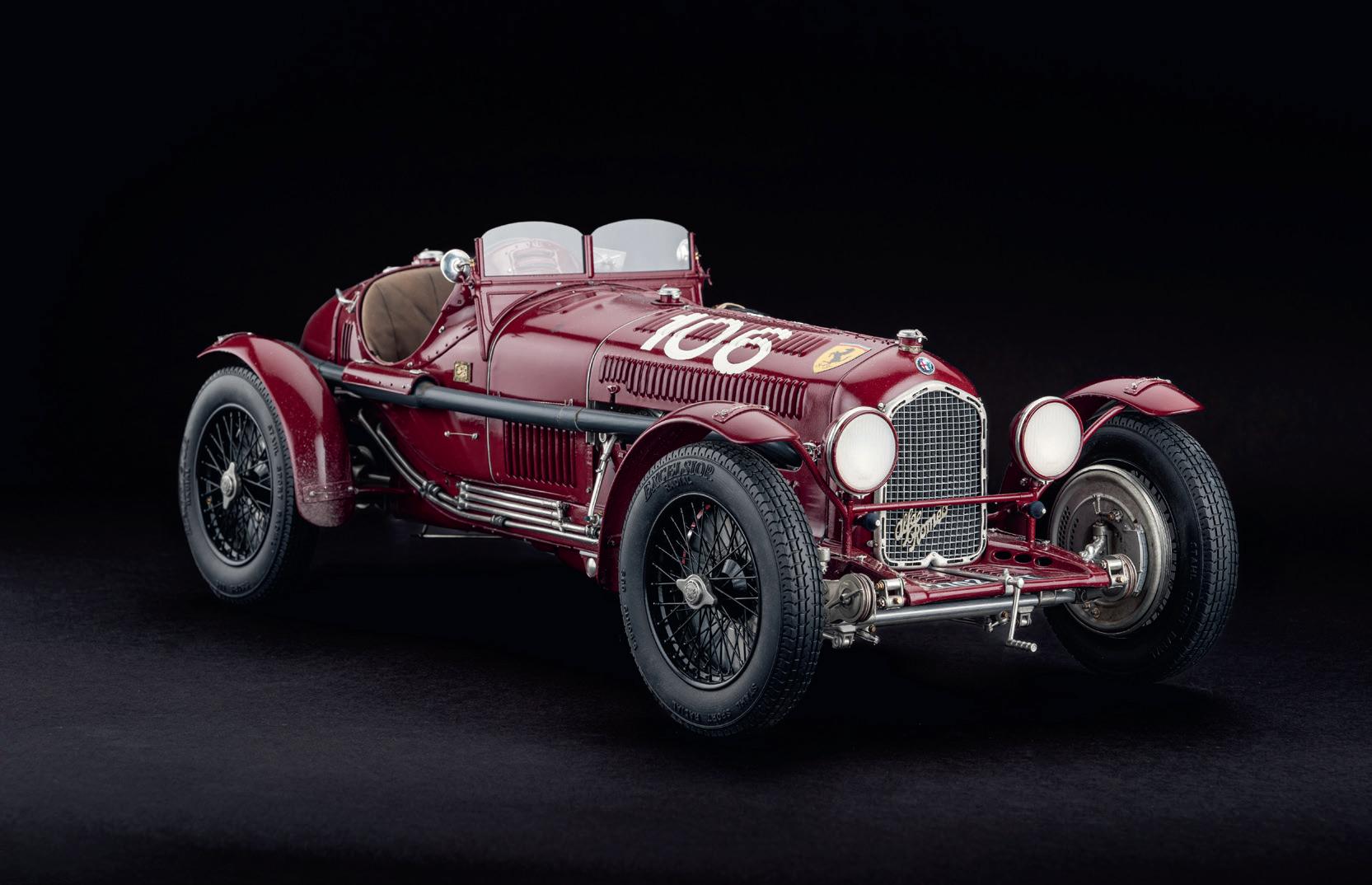
‘B5001 would have a string of podiums and class victories before it was retired from competition in 1936’
„B5001 errang weitere Podiumsplätze und Klassensiege, ehe er 1936 vom Rennsport zurückgezogen wurde“
wurde er 1961 bei einer Auktion von Ernesto Dillen und Jack Forest Green ersteigert Ein Jahr später dann verkauft an Alain de Cadenet und von Tony Merrick zurück auf eine „Biposto“Karosserie restauriert. Nachdem der P3 den Großteil der 1990er-Jahre bei Peter Groh verbracht hatte, ging er in den Besitz von Greg Whitten aus Seattle, der ihn bis 2017 behielt. Andreas Pohl aus Deutschland brachte ihn dann 2018 zurück nach Europa und seitdem ist er auch an wieder die Mille Miglia zurückgekehrt.
1980 Ferrari 312 T5
Sammlung MoCo
The ex-Villeneuve 312 T5 competed in the Monaco Historic Grand Prix in recent times.
Der Ex-Villeneuve 312 T5 nahm in jüngerer Zeit am Grand Prix de Monaco Historique teil.
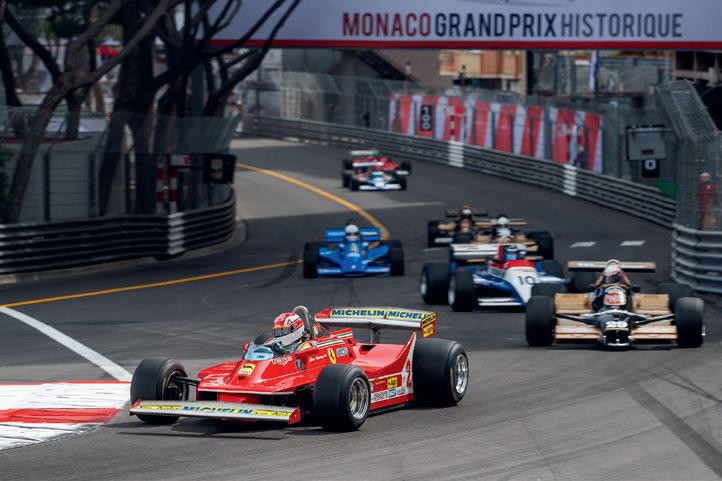
THE FERRARI 312T FAMILY OF FORMULA 1 CARS formed the basis of the Scuderia’s efforts for the second half of the 1970s, making its debut three races into the 1975 season. The use of a tubular spaceframe chassis with aluminium panels wasn’t novel for the time, but the car did push boundaries by featuring a transverse-mounted gearbox. This positioning allowed the transmission to sit ahead of the rear axle for better handling balance. The front suspension was also much narrower than standard.
Mauro Forghieri’s design was immediately on the pace, with Niki Lauda clinching five wins and the drivers’ title, as well as the Scuderia’s first Constructors’ Championship since 1964. The T2, which was introduced in 1976 and used through to early 1978, bagged Ferrari its second and third constructors’ titles. The adoption of ground-effect design principles for 1979’s T4 took Jody Scheckter to a drivers’ crown and another constructors’ win.
The T5 of 1980 was the least successful of the 312T variants. Ferrari’s rivals were moving the game on in terms of aerodynamics, and the engine simply wasn’t suited to the shape needed for success. Following a season with no wins and a tenth place in the Constructors’ Championship, an entirely new car was launched for 1981. This particular 312 T5 was driven by Gilles Villeneuve in several GPs in the 1980 season. More recently, the car competed in the Monaco Historic Grand Prix and has been driven by Gilles’ son and 1997 F1 World Champion Jacques at a Paul Ricard event.
MIT DEN FORMEL-1-MODELLEN DER 312T-SERIE BESTRITT die Scuderia die zweite Hälfte der 1970er-Jahre. Beginnend mit dem dritten Rennen der Saison 1975. Die Konstruktion aus einem Rohrrahmen-Chassis mit Aluminium-Beplankung war zwar nichts Neues für die Zeit, doch verschob das Modell mit einem quer installierten Getriebe technologische Grenzen. Durch die Einbaulage vor der Hinterachse verbesserte sich das Handling und dessen Balance. Zugleich war die vordere Spurweite weitaus schmaler als üblich.
Die Konstruktion von Mauro Forghieri erwies sich auf Anhieb als schnell und verhalf Niki Lauda nach fünf Siegen zum WM-Titel und der Scuderia zum ersten Triumph in der Konstrukteurs-Wertung seit 1964. Mit dem 1976 eingeführten und bis Anfang 1978 eingesetzten T2 holte Ferrari zwei weitere Konstrukteurs-Trophäen nach Maranello. Gekrönt wurde die Erfolgsserie mit dem auf die neuen Ground-EffektDesignprinzipen ausgerichteten T4, der Jody Scheckter
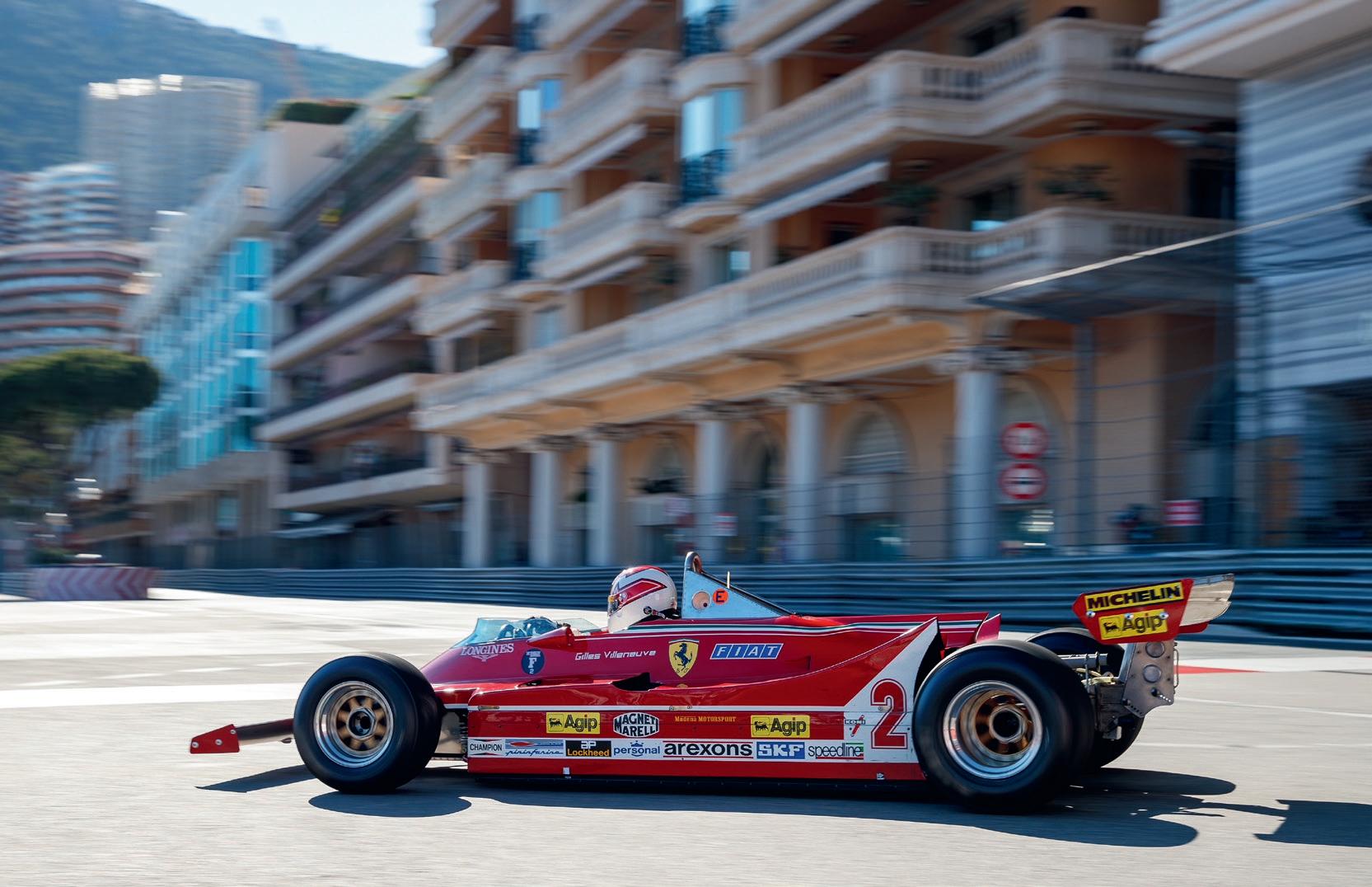
‘This particular 312 T5 was driven by Gilles Villeneuve in several GPs in the 1980 season’
„Dieser spezielle 312 T5 wurde von Gilles Villeneuve bei mehreren Grand Prix der Saison 1980 gefahren“
und der Scuderia 1979 je einen weiteren Titel bescherte. Der T5 von 1980 erwies sich dann als das erfolgloseste aller 312T-Modelle. Ferraris Konkurrenten machten in Sachen Aerodynamik Fortschritte, und auch der Motor war nicht mehr auf dem Höhepunkt seiner Leistung. Nach einer sieglosen Saison und Platz 10 in der Konstrukteurswertung stellte Ferrari für 1981 ein völlig neues Auto vor.
Dieser spezielle 312 T5 wurde in der Saison 1980 von Gilles Villeneuve bei mehreren GP gefahren. In jüngerer Zeit nahm das Auto am Historischen Grand Prix von Monaco teil und wurde von Jacques Villeneuve, Sohn von Gilles und F1-Weltmeister von 1997, bei einem Event für historische F-1-Wagen in Paul Ricard pilotiert.
1987 McLaren MP4/3
Sammlung MoCo
MP4/3 was reunited with Johansson and Prost at an event at Circuit Paul Ricard.
Der MP4/3 wurde bei einem Event auf dem Circuit Paul Ricard mit Johansson und Prost wiedervereint.
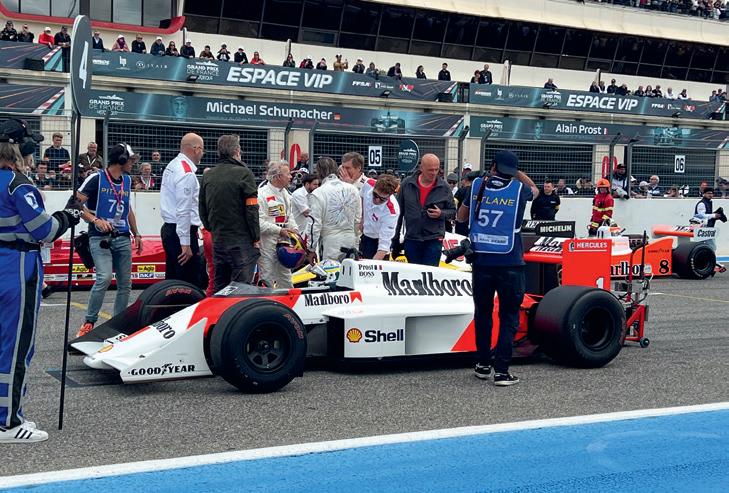
THE MCLAREN TAG TURBO MP4/3 WAS THE LAST McLaren to use a Porsche turbo engine; the Stuttgart manufacturer chose to withdraw after three consecutive Formula 1 World Championships (1984, 1985 and 1986) with Niki Lauda and Alain Prost in the MP4/2.
The MP4/3 was designed by Steve Nichols alongside Neil Oatley, Gordon Kimball, Tim Wright and Bob Bell, and it was a complete rethink over the MP4/2. With a reduction in fuel tank size from 220 to 195 litres, they had to move towards a sleeker, lower-slung design and side-ducted radiators. The engine was a development of the 1.5-litre twin-turbocharged Porsche V6, which was adapted to deal with the fuel changes, restrictions on turbo boost to 4.0 bar via an FIA-mandated pop-off valve, and alterations to compression and balancing. The motor produced 850bhp at 12,000rpm in qualifying trim, and 790bhp in the races, making it one of the most powerful F1 engines ever made. Over the 1987 season Prost took victories in Brazil, Belgium and Portugal, and helped McLaren bag second in the Constructors’ Championship.
This particular car was driven by Alain Prost and Stefan Johansson at the Austrian GP at the Zeltweg track. More recently it was reunited with both drivers at an Historic Formula 1 event at Circuit Paul Ricard.
DER MCLAREN TAG TURBO MP4/3 WAR DER LETZTE McLaren mit Porsche Turbo-Motor. Der Stuttgarter Motorenlieferant hatte sich nach drei WM-Titeln infolge (1984-1986) mit Niki Lauda und Alain Prost zum Rückzug entschlossen. Chefkonstrukteur des MP4/3 war Steve Nichols; er wurde unterstützt von Neil Oatley, Gordon Kimball, Tim Wright und Bob Bell. Aufgrund des für die Saison 1987 von 220 auf 195 Liter reduzierten Tankinhalts war im Vergleich zum Vorgänger MP4/2 ein schlankeres und flacheres Chassis sowie seitlich positionierte Kühler gefragt. Der Motor war eine Weiterentwicklung des 1,5-Liter-V6-Bi-Turbo von Porsche. Angepasst an den knapperen Benzinhaushalt, durch ein von der FIA vorgeschriebenes Pop-off-Ventil auf 4,0 bar Ladedruck limitiert und mit geänderter Kompression leistete er im Qualifying-Trim 850 PS bei 12.000 U/min; im Rennen immerhin noch 790 PS, was ihn zu einem der stärksten Triebwerke im Feld

‘This particular car was driven by Alain Prost and Stefan Johansson at the Austrian GP at the Zeltweg track in 1987’
„Dieses spezielle Modell wurde von Alain Prost und Stefan Johansson 1987 beim GP von Österreich in Zeltweg gefahren“
machte. In der Saison 1987 gewann Prost in Brasilien, Belgien und Portugal und trug damit zum Vize-Titel für McLaren in der Konstrukteurs-Wertung bei.
Dieses spezielle Modell wurde von Alain Prost und Stefan Johansson beim GP von Österreich in Zeltweg gefahren. In jüngerer Vergangenheit wurde es bei einem historischen Formel-1-Event in Paul Ricard mit beiden Fahrern wiedervereint.
1985 Porsche 959 S
Private Collection
This is one of 29 cars to boast larger turbos and various measures to save weight.
Dies ist einer von nur 29 Wagen mit größeren Turbos und gewichtsreduzierenden Maßnahmen.

PORSCHE’S FIRST TRUE SUPER SPORTS CAR WAS unveiled at the Frankfurt IAA in 1985. Each had a staggering price tag of 420,000 DM, despite costing 1.3 million DM per unit to build. Considering that 337 were produced, the project’s total cost would have amounted to some 368m DM, of which only about one-third could be recovered through sales.
The 959 began life in 1982 as a project to develop a longterm replacement for the 911 Turbo, which Porsche’s engineers believed had gone as far as it could in development. The idea was for a new ‘halo’ car with four-wheel drive, which would then filter down to a much more production-ready subbrand. In a bid to advance development, the engineering team proposed using Group B motor sport as a means to speed things along. It had an advanced torque-biasing 4WD system, mated to a 2.85-litre twin-turbocharged six-cylinder engine.
The 959 S here is one of 29 built with larger turbos, taking power to 508bhp. It is in this configuration that Auto,Motor undSport hit 339km/h at the Nardò Ring in 1988. To save weight, the air-conditioning, central locking, electric windows, rear seats and self-levelling suspension were removed.
PORSCHES ERSTER ECHTER SUPERSPORTWAGEN WURDE 1985 auf der Frankfurter IAA enthüllt. Zu einem Preis von 420.000 DM, denen Produktionskosten von 1,3 Millionen DM pro Auto gegenüberstanden. Angesichts von nur 337 gebauten Exemplaren hätten sich die Gesamtkosten des Projekts auf rund 368 Millionen DM belaufen, von denen nur etwa ein Drittel durch Verkäufe wieder eingespielt werden konnten.
Der 959 wurde 1982 als Projekt zur Entwicklung eines langfristigen Ersatzes für den 911 Turbo geboren, dessen Entwicklung nach Ansicht der Porsche-Ingenieure bereits ausgereizt war. Die Idee war ein neues „Halo“-Auto mit Allradantrieb, das dann in eine deutlich serienreifere Submarke integriert werden sollte. Um die Entwicklung des Technologeiträgers voranzutreiben, schlug das Ingenieurteam vor, über Einsätze in der von der FIA neu eingeführten Gruppe B die Entwicklung zu beschleunigen. Der 959 verfügte über ein elektronisch gesteuertes und dynamisch die Drehmomentverteilung zwischen Vorder- und Hinterachse regelndes Allradsystem; gekoppelt an einen von zwei
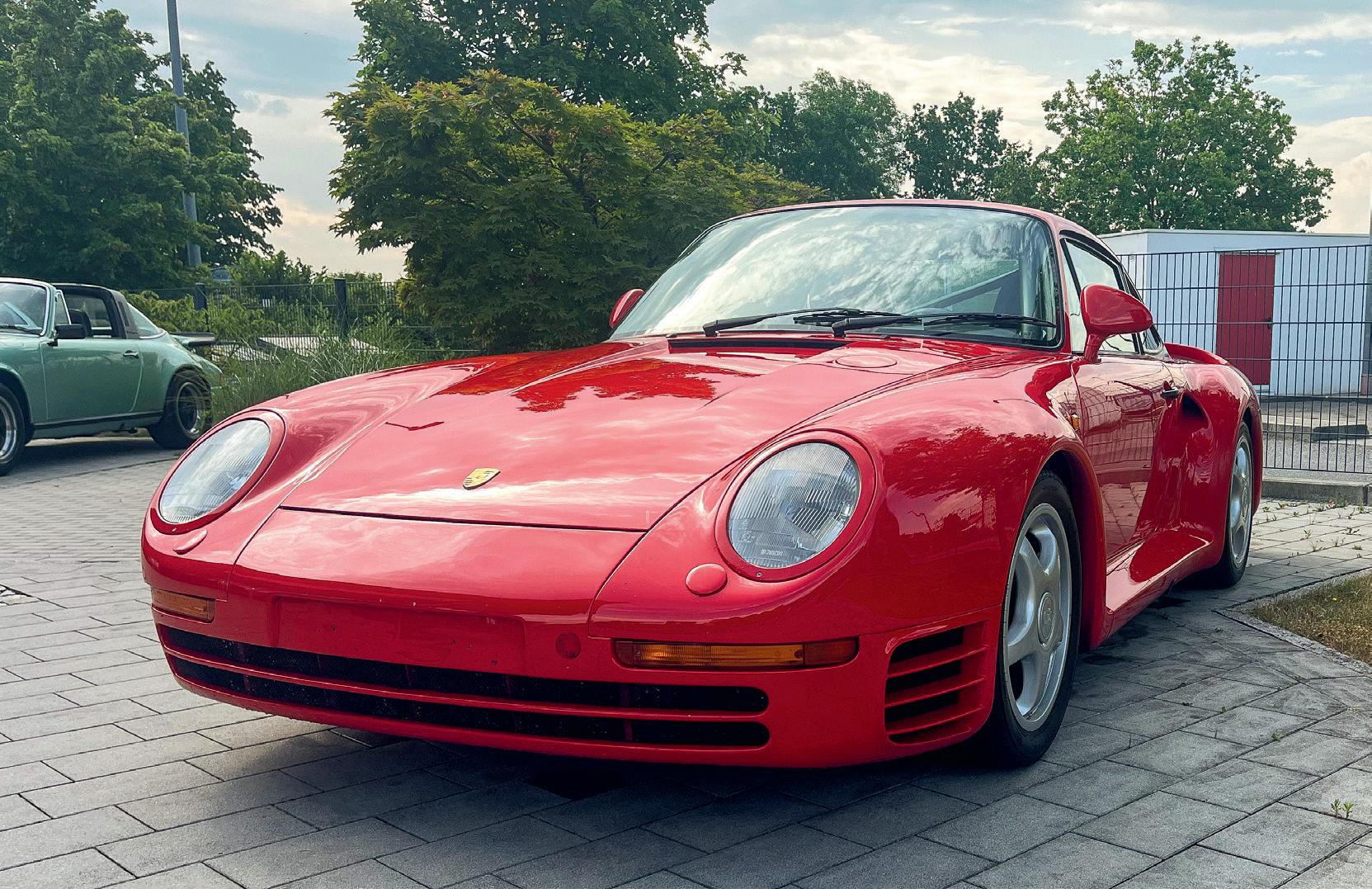
‘Advanced torquebiasing four-wheel drive was mated to a 2.85-litre twin-turbo
six-cylinder engine’
„Ein dynamisch das Drehmoment verteilende Allradsystem, gekoppelt an einen 2,65-LiterBi-turbo-Sechszylinder“
Turboladern aufgeladenen 2,85-Liter-Sechszylinder. Der hier gezeigte 959 S ist einer von nur 29 mit größeren Turbos, die die Leistung auf 515 PS steigerten. In dieser Konfiguration erreichte Auto, Motor und Sport 1988 auf dem Nardò-Oval in Apulien 339 km/h. Um Gewicht zu sparen, wurden Klimaanlage, Zentralverriegelung, elektrische Fensterheber, Rücksitze und die Niveauregulierung ausgebaut.
1985 BMW M635 CSi
Hans-Jürgen Heiland
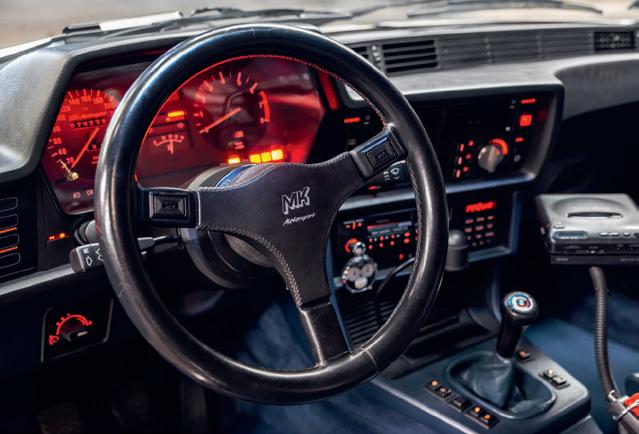
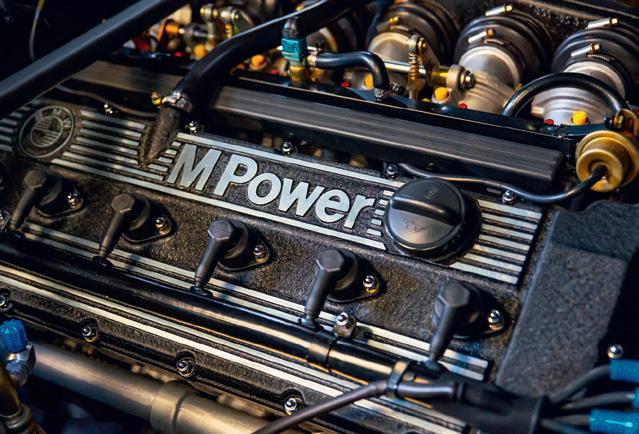
THE BMW M635 CSI BROUGHT THE M1’S INNOVATIVE straight-six engine to a regular production machine – but there was nothing ‘regular’ about this model. It was at least one-third more expensive than a normal 635 CSi, and as such it remains a rare sight on the roads.
This particular car was produced on November 21, 1985 and delivered to a German BMW dealer on March 25, 1986. It was used as a display and demonstration model until it was sold to its first owner on April 27, 1988. Shortly after, on June 9, 1988, the first owner had a Bilstein MK special sport suspension set-up installed by renowned BMW chassis specialist Michael Krankenberg (MK-Motorsport). The work also included side skirts, rear lower fender corners, 17-inch wheels, an MK steering wheel and an MK footrest.
On March 10, 2000 the M635 CSi was sold to its current and only second owner. The BMW has frequently won its class and earned multiple trophies at various international concours d’elegance events. It remains unrestored and it still has its original factory paintwork. All components, such as the engine, transmission and differential, are factory installed and have matching numbers.
MIT DEM BMW M635 CSI FAND DER INNOVATIVE Reihensechszylinder des M1 den Weg in ein reguläres Serienfahrzeug – doch war dann an diesem Modell nichts „regulär”. Es war mindestens ein Drittel teurer als ein serienmäßiger 635 CSi und blieb deshalb auch ein seltener Anblick auf den Straßen.
Dieses Exemplar lief am 21. November 1985 vom Band und wurde am 25. März 1986 an einen deutschen BMW-Händler geliefert. Der nutzte es als Ausstellungs- und Vorführwagen, ehe er es am 27. April 1988 an seinen ersten Besitzer verkaufte. Bald
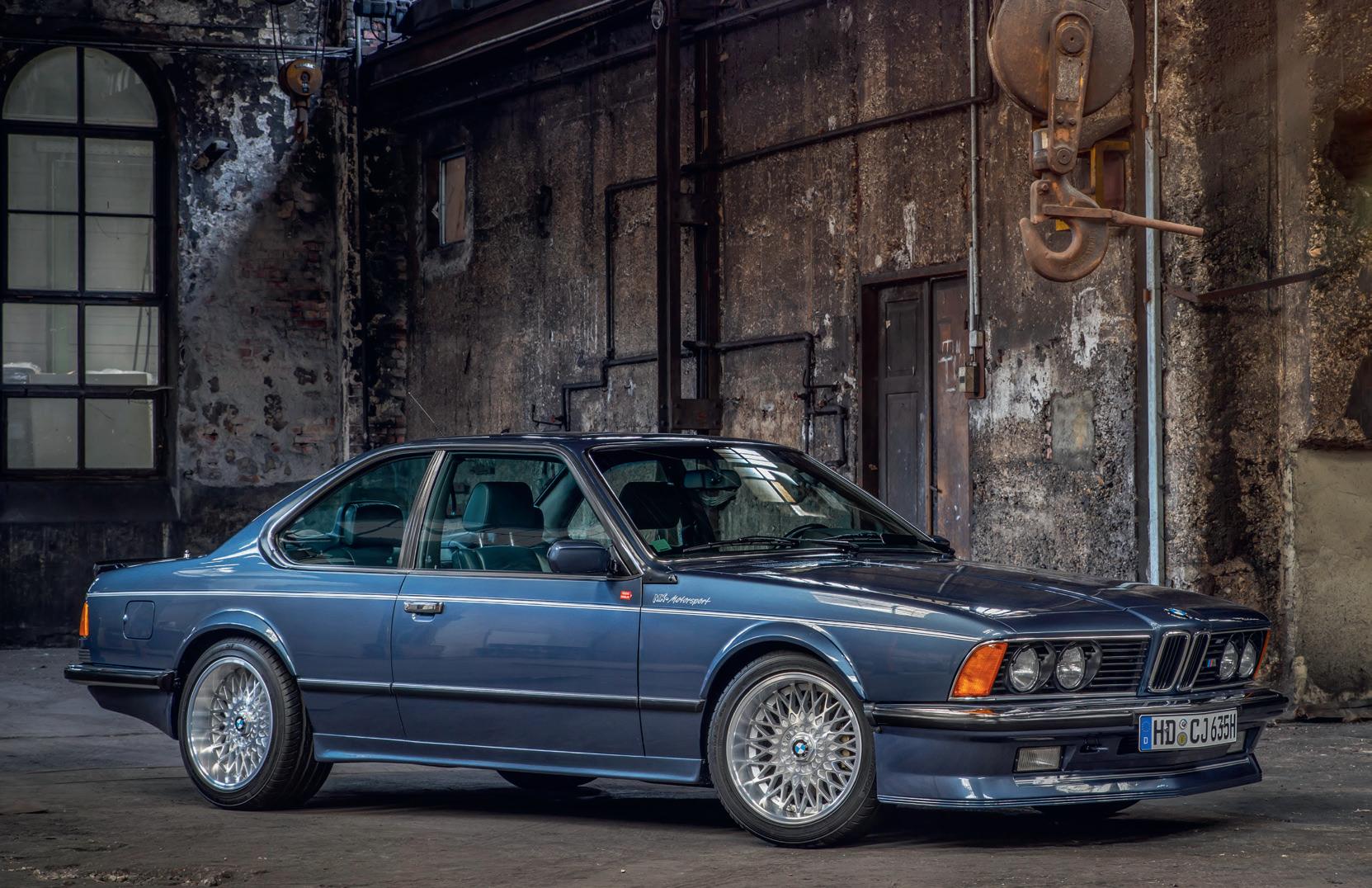
‘The BMW has frequently won its class and earned multiple trophies at various international concours d’elegance’
„Der BMW hat bei diversen internationalen Concours d‘Élégance regelmäßig seine Klasse und zahlreiche Trophäen gewonnen“
darauf, am 9. Juni 1988, ließ der Erstbesitzer beim bekannten BMW-Fahrwerksspezialisten Michael Krankenberg (MKMotorsport) ein spezielles Bilstein-MK-Sportfahrwerk installieren. Zusätzlich seitliche Schweller, tiefer heruntergezogene hintere Kotflügelecken, 17-Zoll-Felgen sowie ein MK-Lenkrad und eine MK-Kupplungsfußstütze.
Am 10. März 2000 wurde der M635 CSi an seinen jetzigen und bislang erst zweiten Besitzer verkauft. Das M Coupé hat bei diversen internationalen Concours d’Élégance regelmäßig seine Klasse und zahlreiche Trophäen gewonnen. Es bleibt bis heute absolut original und besitzt noch immer seine originale Werkslackierung. Alle Antriebskomponenten, wie Motor, Getriebe und Differential, wurden im Werk montiert und tragen „matching numbers.“
The M635 CSi remains unrestored with its factory paint and matching numbers.
Der M635 CSi bleibt unrestauriert, mit seiner Werkslackierung und „matching numbers.”
1986 Aston Martin V8 Vantage Zagato
Dr Alexander Lienau


THE V8 VANTAGE ZAGATO WAS THE RESULT OF circumstance. The Zagato stand just happened to be near that of Aston Martin at the 1984 Geneva Motor Show. Victor Gauntlett, Peter Livanos and the Zagato management were watching the rapturous response to the Porsche 959 and Ferrari 288 GTO, and together they subsequently conceived of a similar ultra-performance ‘halo’ model for Aston Martin.
The result would use a shortened V8 Vantage chassis with a 5.3-litre V8 tuned to 430bhp via four twin-choke Weber carburettors. The car was clad in a Giuseppe Mittino-penned aluminium body that dramatically cut weight, contributing to a top speed in advance of 300km/h. A mere 52 coupés and 37 convertibles were built between 1986 and 1990.
This particular example was the Geneva Motor Show car in 1986, as well as the first full production model. It was subsequently owned by comedian and actor Rowan Atkinson in 1998. He had the car tweaked by Aston Martin Works for the Aston Martin Owners Club’s C2 Class Mildly Modified category, with an engine tuned to 482bhp, Weber Alpha fuel injection, a roll bar and much more. The Vantage Zagato was retired from racing in 2007 and returned to road specification, retaining its extra performance modifications.
DER V8 VANTAGE ZAGATO WAR DAS ERGEBNIS SPEZIELLER Umstände. 1984 lag der Zagato-Stand für den Genfer Salon zufällig gleich neben dem von Aston Martin. Victor Gauntlett, Peter Livanos und das Zagato-Management beobachteten die begeisterten Reaktionen auf den Porsche 959 und den Ferrari 288 GTO. Und fassten unter diesem Eindruck den Entschluss für die gemeinsame Entwicklung eines ebenbürtigen UltraPerformance-„Halo”-Modells von Aston Martin.
Heraus kam ein Coupé auf Basis einer verkürzten V8Vantage-Bodengruppe, angetrieben von einem von vier Weber Doppelvergasern gespeisten 5,3-Liter-V8 mit 436 PS. Eingekleidet wurde es mit einer leichten Aluminium-Karosse aus der Feder von Zagato-Designer Giuseppe Mittino, welche mit zur Höchstgeschwindigkeit von 300 km/h beitrug. Zwischen 1986 und 1990 entstanden nur 52 Coupés und 37 Cabriolets.
Dieses besondere Exemplar war das Ausstellungsfahrzeug für den Genfer Salon von 1986 und gleichzeitig das erste komplette Serienmodell. 1988 kam es in den Besitz des Komikers und
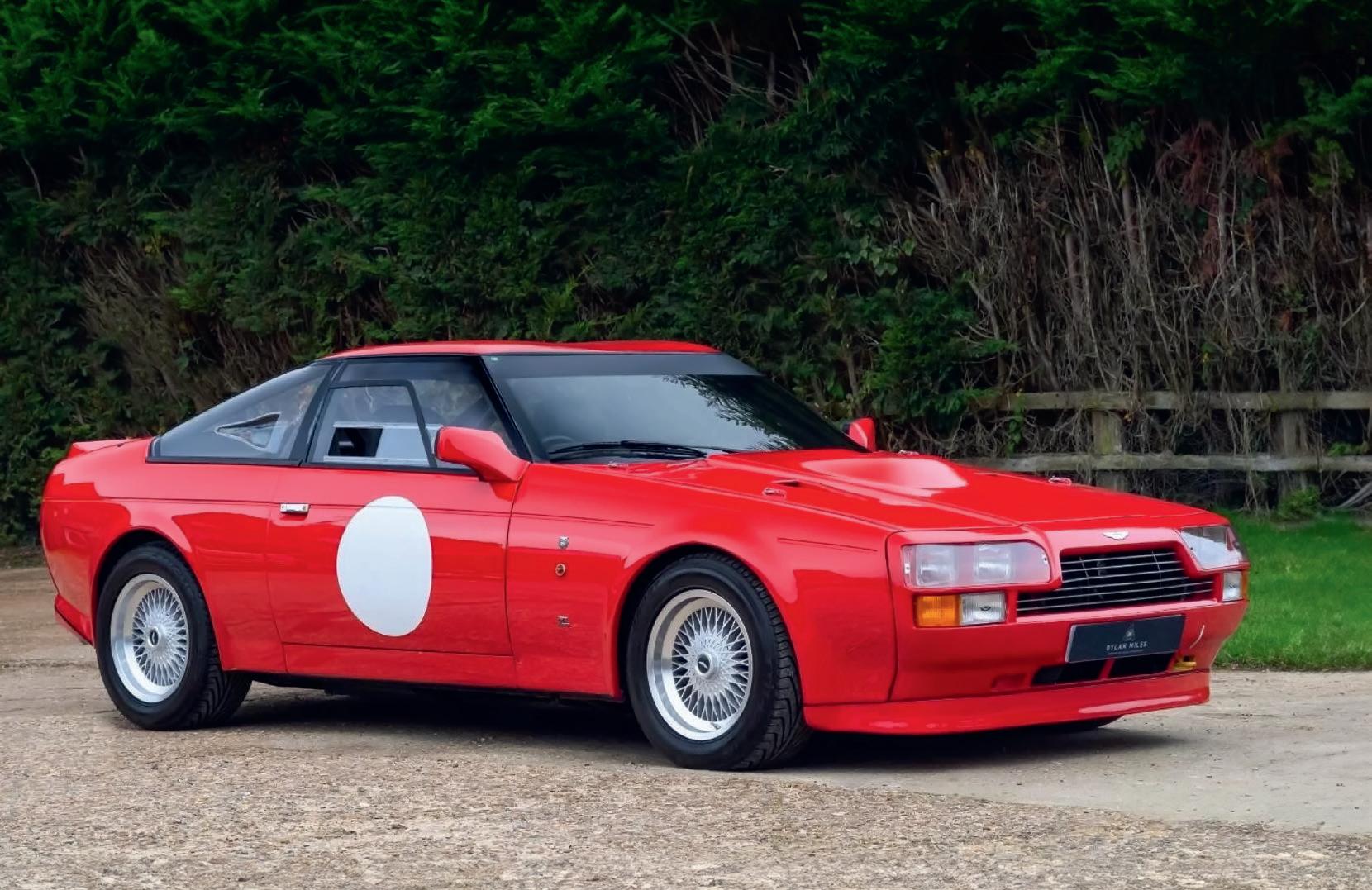
‘This particular example was the Geneva Motor Show car in 1986, as well as the first full production model’
„Dieses spezielle Exemplar war das Ausstellungsfahrzeug für den Genfer Salon von 1986 und zugleich das erste komplette Produktionsmodell“
Schauspielers Rowan Atkinson („Mr. Bean“). Er ließ den Wagen von Aston Martin Works für die Kategorie „C2 Class Mildly Modified“ des Aston Martin Owners Club überarbeiten, mit einem auf 489 PS getunten Motor, Weber-Alpha-Einspritzung, einem Überrollbügel und vielem mehr. Der Vantage Zagato wurde 2007 vom Rennsport zurückgezogen und in den 2010er-Jahren wieder für die Straße zugelassen, wobei die leistungssteigernden Modifikationen erhalten blieben.
Aston Martin Works tweaked the V8 Vantage Zagato for previous owner Rowan Atkinson.
Aston Martin Works schneiderte den V8 Vantage Zagato auf seinen Vorbesitzer Rowan Atkinson zu.
1992 Lamborghini LM002
Jos van Boom & Dagmar Heusch
ONE OF THE MOST EXUBERANT AND INDULGENT
road cars ever made has its roots in the rather more serious world of military vehicles. Lamborghini constructed a 1977 concept called the Cheetah, and then it produced the LM001 hoping to secure the US contract that would eventually go to Hummer. With all the investment made by the Italian manufacturer, Lamborghini removed the American V8s from the concepts, put the Countach V12 in the nose and created the world’s first super-SUV.
While the LM002 was limited to around 200km/h, the 450bhp 5.2-litre engine could still whisk well heeled owners to 100km/h in 7.7 seconds despite the ‘Rambo Lambo’ weighing 2700kg. The interior was far removed from that of the utilitarian military models, with leather, air-conditioning, wood trim and a plethora of other options available on special request. Famous owners included Sylvester Stallone, Tina Turner and Mike Tyson.
This particular car, number 281 out of 301 constructed, was delivered to Belgium back in 1992. It is one of around 60 examples equipped with Bosch K-Jetronic injection. The current owners acquired the LM002 from its one previous keeper in 2000. They regularly attend rallies – but this is the first time the Lamborghini had ever appeared in a concours.
EINES DER IN VIELERLEI HINSICHT MASSLOSESTEN
Serienautos aller Zeiten hat seine Wurzeln in der eher ernsten Welt der Militärfahrzeuge. Lamborghini hatte sich an einer Ausschreibung der US-Armee für einen Jeep-Nachfolger beteiligt und im Zuge dessen 1977 das Konzeptfahrzeug Cheetah präsentiert. Nachdem Hummer den Zuschlag erhalten hatte, wurde das Projekt zunächst begraben, um 1980 wieder neu gestartet zu werden. Diesmal statt eines im Heck installierten amerikanischen V8 mit einem im Bug sitzenden Countach-V12. Fertig war der LM002, als erster Super-SUV der Welt.
Zwar war die Höchstgeschwindigkeit auf 200 km/h limitiert, doch reichten die 450 PS des 5,2-Liters aus, um den „Rambo-Lambo“ trotz 2700 Kilo Gewicht in 7,7 Sekunden auf 100 km/h zu beschleunigen. Der Innenraum hob sich deutlich vom nüchternen Militärlook ab; mit Leder, Klimaanlage, Holzverkleidungen und einer Vielzahl von Optionen auf Sonderwunsch. Zu den prominenten LM-Besitzern zählten Sylvester Stallone, Tina Turner und Mike Tyson.
Dieses Exemplar, Nummer 281 von 301 gebauten, ging 1992 neu nach Belgien. Es gehört zu rund 60 Fahrzeugen mit Bosch-K-Jetronic-Einspritzung. Die aktuellen Besitzer erwarben den LM002 im Jahr 2000. Sie bestreiten mit ihm regelmäßig Rallyes – doch wird ihr Lamborghini jetzt erstmals auf einem Concours gezeigt.
‘While the LM002 was limited to 200km/h, the 450bhp 5.2 engine could still whisk owners to 100km/h in 7.7 seconds’
„Zwar war der LM002 auf 200 km/h limitiert, doch reichten die 450 PS des 5,2-Liters, um Besitzer in 7,7 Sekunden auf 100 km/h zu beschleunigen“

No. 281’s owners regularly attend rallies with their exuberant LM002.
Die Besitzer der Nummer 281 setzen ihren bulligen LM002 regelmäßig bei Rallyes ein.
1998 Dodge Viper GTS-R GT2
Roland Tubbesing
Number 66 of 100 Viper GTS-R cars built is believed to be one of just ten in Europe.
Die Nummer 66 von 100 gebauten Viper GTS-R ist vermutlich nur eine von zehn in Europa.
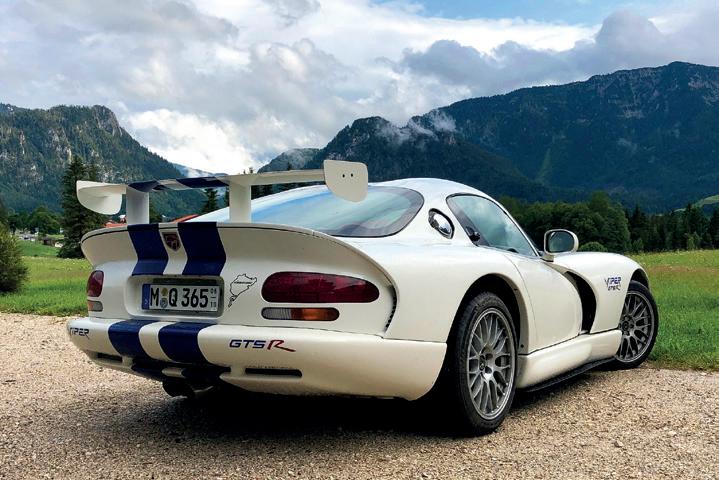
IN AN ATTEMPT TO WIN THE FIA GT2 CHAMPIONSHIP, Dodge teamed up with the French ORECA racing team in 1997 to create the Viper GTS-R. The partnership was highly successful in its quest for victory, capturing its class FIA World GT Championship in 1997, 1998 and 1999. The Viper also won the American Le Mans Series GTS class in 2000, and took three class victories at the Le Mans 24 Hours between 1998 and 2000 – the first American car to win there since the Ford GT40 in the 1960s.
To this end, Dodge needed to homologate the race car by offering a street version for public sale. The result was the venomous Viper GTS-R, built to commemorate the 1997 FIA GT2 Championship racing triumphs. Changes over standard Viper models include the white and blue racing livery, a racing car-aping rear wing, one-piece BBS wheels (which later became the standard wheel on the ACR models), blue interior door panels and centre console, and a racing harness. The GTS-R is also the only Viper to include the limitation number in the VIN.
This example is number 66 of the 100 built, and it was initially owned by the president of the Viper Club of America. The current owner found the car in Texas in 2012 and brought it to Germany; it’s believed to be one of just ten in Europe, and it has covered just 6500 miles from new.
MIT DEM ZIEL DES GEWINNS DER FIA GT-MEISTERSCHAFT tat sich Dodge zum Bau der Viper GTS-R mit dem französischen ORECA Rennteam zusammen. Die Partnerschaft erwies sich als äußerst erfolgreich und gipfelte in den Jahren 1997, 1998 und 1999 im Gewinn der GT2-Kategorie. 2000 gewann die Viper auch die GTS-Klasse der American Le Mans-Serie; ergänzt um drei Klassensiege bei den 24 Stunden von Le Mans zwischen 1998 und 2000 – als erstes amerikanisches Siegerauto seit den Erfolgen des Ford GT40 in den 60er-Jahren.
Ehe es dazu kam, musste Dodge den Rennwagen homologieren und dazu eine Straßenversion zum Verkauf anbieten. Das Ergebnis war die hochgiftige Viper GTS-R, die zum Andenken an die Triumphe in der FIA GT2-Klasse von 1997 entstand. Zu den Änderungen gegenüber den Serienmodellen gehörten die zwei blauen Streifen über der weißen Karosserie, ein Heckflügel


‘The Viper GTS-R was built to commemorate the 1997 FIA GT2 Championship racing triumphs’
„Die Viper GTS-R entstand zum Andenken an die Triumphe in der FIA GT2-Meisterschaft von 1997”
im Rennwagen-Stil, einteilige BBS-Felgen (später die Standardfelge der ACR-Modelle), Türinnenverkleidungen und Mittelkonsole in Blau sowie ein Renngurt. Die GTS-R ist außerdem die einzige Viper mit einer Limitierungsnummer in der Fahrzeug-Identifizierungsnummer (FIN).
Dieses Auto ist Nummer 66 von 100 Exemplaren und gehörte ursprünglich dem Präsidenten des Viper Club of America. Der aktuelle Besitzer fand das Auto 2012 in Texas und brachte es nach Deutschland. Es ist vermutlich eines von nur zehn Exemplaren in Europa und hat bis heute erst 10.460 Kilometer zurückgelegt.
2006 Ferrari 575M Superamerica
Horst Koester
THE 550 AND ITS LATER VARIANT, THE 575, HAD elevated Ferrari to the head of the two-seater GT class, but for those who wanted the ultimate in grand touring a drop-top version would be the perfect accompaniment for a trip to somewhere sunny. All the better to hear the naturally aspirated 5.7-litre V12 in full voice, delivering a mighty 540bhp in the 575M Superamerica.
Built in just 559 units, the Superamerica featured a bespoke retractable hard-top roof, which could be folded back and stored behind the seats at the touch of a button. The entire process took just 10.0 seconds – a lot less than the somewhat awkward procedure inflicted on owners of the 550 Barchetta. The use of lightweight materials such as aluminium helped to keep the impact on performance to a minimum – after all, the Superamerica could hit 199mph and cover the 0-60mph sprint in around 4.2 seconds, although additional structural reinforcements were engineered around the B-pillars, roof frame and rear section to maintain torsional rigidity. Famous owners are believed to have included Jamiroquai’s Jay Kay, Nicolas Cage and Juan Pablo Montoya.
This particular car was first delivered to its current owner on February 20, 2006 – February 20 being significant because it is Enzo Ferrari’s documented birthday. It’s also one of only 43 examples built with a six-speed manual gearbox.
DER 550 UND SEIN NACHFOLGER 575 HOBEN FERRARI AN die Spitze der zweisitzigen GT-Klasse. Doch für all jene mit dem Wunsch nach dem ultimativen Grand-Touring-Fahrerlebnis fehlte eigentlich noch eine Cabriolet-Version – als perfekte Begleitung für eine Ausfahrt ins Sonnige. Auch um dabei den vollen Klang das 5,7-Liter-V12 Saugmotors zu genießen, der im 575M Superamerica mächtige 540 PS leistet. Der in nur 559 Einheiten gebaute Superamerica verfügte über ein gläsernes Dach, das auf Knopfdruck nach hinten geklappt und auf dem Kofferraumdeckel abgelegt werden konnte. Der ganze Vorgang dauerte nur zehn Sekunden – weitaus schneller als beim umständlich zu bedienenden Notverdeck, mit dem sich Besitzer einer 550 Barchetta abmühen mussten. Der Einsatz von Leichtbaumaterialien wie Aluminium half, den Einfluss auf die Leistung gering zu halten. Denn trotz zusätzlicher Verstärkungen zur Beibehaltung der Torsionssteifigkeit in den B-Säulen, am Dachrahmen und im Heckbereich beschleunigte der Superamerica in 4,2 Sekunden von 0 auf 100 km/h und erreichte eine Höchstgeschwindigkeit von 320 km/h. Zu den prominenten Besitzern sollen Jay Kay von der Band Jamiroquai, Nicolas Cage und Juan Pablo Montoya gehört haben.
Dieses spezielle Modell wurde am 20. Februar 2006 an seinen aktuellen Besitzer geliefert – ein besonderes Datum, markiert der 20. Februar doch den amtlich eingetragenen Geburtstag von Enzo Ferrari. Es ist zugleich eines von nur 43 Exemplaren mit Sechsgang-Handschaltgetriebe.
‘This particular 575M Superamerica is one of only 43 examples built with a six-speed manual gearbox’
„Dieser spezielle 575 M Superamerica ist eines von nur 43 Exemplaren mit Sechsgang-Schaltgetriebe“
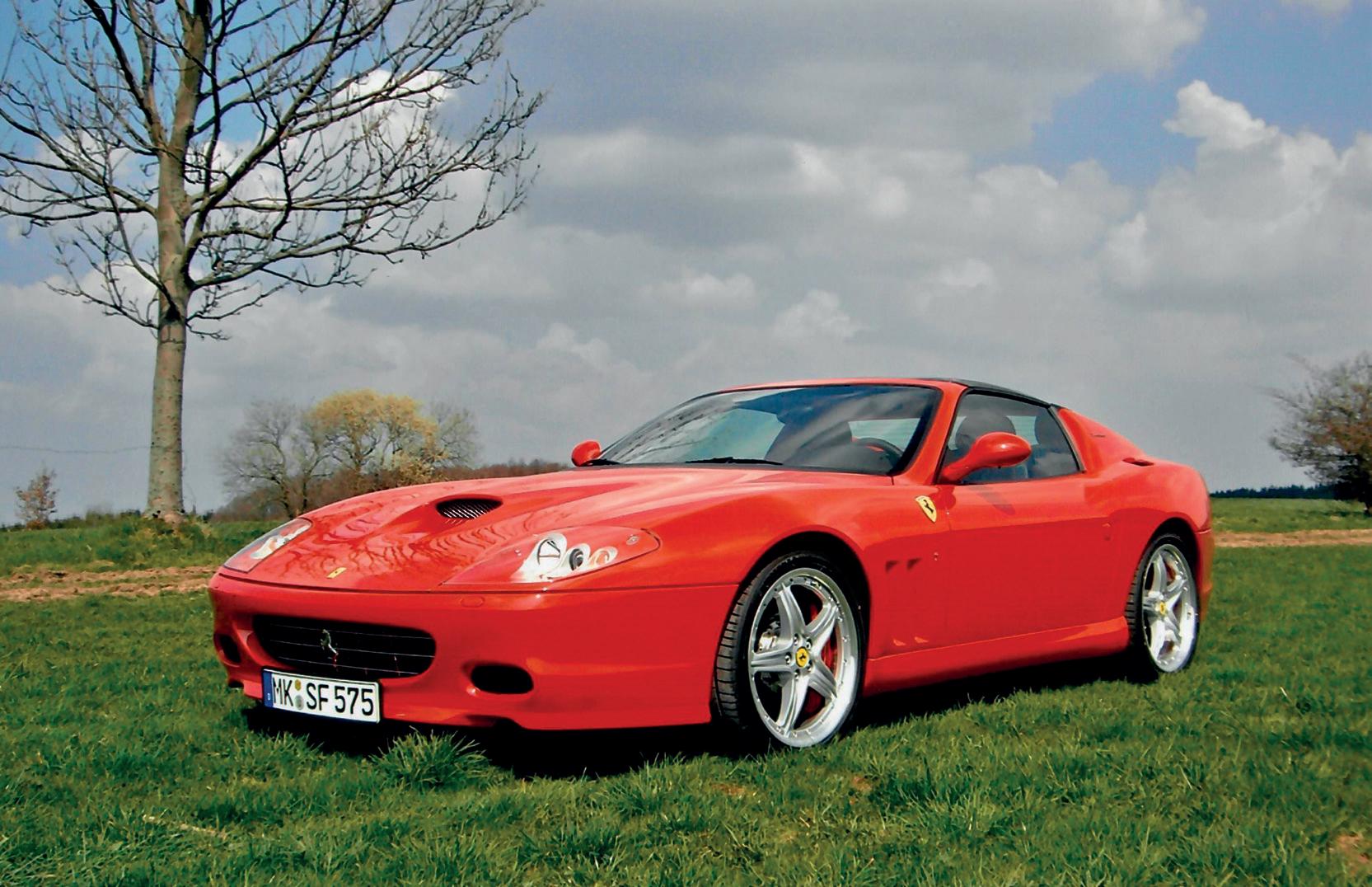
The Superamerica’s retractable hard-top could be folded at the touch of a button.
Das Hardtop des Superamerica ließ sich auf Knopfdruck auf dem Kofferraumdeckel ablegen.
1955 Autobleu 4CV Chapron
Christian Hartmann
AUTOBLEU STARTED OUT AS A PARISIAN MAKER OF car parts, particularly for the Renault 4CV. Its main business was in performance manifolds, but owners Maurice Mestivier and Roger Lepeytre had bigger ambitions; in 1953 they started offering complete customised cars, such as the 4CV Chapron. Inspired by a Ghia-bodied Lancia, the duo enlisted stylists Luigi Segre and Felice Mario Boano to create a luxurious twodoor body. Crafted out of aluminium, it was 90mm longer and had 25bhp (boosted by Autobleu’s inlet manifold and a Solex carburettor). Body construction was attempted by several carrosseries, of whom Henri Chapron had the most success. Around 80 cars are believed to have been built. This example, Autobleu no. 153, boasted several special features including elegant wire wheels and a semi-automatic Ferlec clutch. Movie stars such as Michèle Morgan and Luis Mariano drove Autobleu coupés. However, this car was first delivered to Mme Paulette Pasquier in 1955, and it passed to the Lohéac Museum in southern France in the late 1980s. In 1991, Pierre Spilmont traded his Peugeot 403 Cabriolet for the Autobleu. He kept it for two years before selling it to Mr Wiederman, who held onto it until 2009. It then passed to Jean-Claude Rehlinger of Fameck, France, who sold it to the current owner in 2016. The car is unrestored, in its original paint and without modifications. It has also appeared in various publications.
AUTOBLEU BEGANN ALS EIN PARISER PRODUZENT VON Autoteilen, speziell für den Renault 4 CV. Das Hauptgeschäft waren Hochleistungs-Ansaug- und Abgaskrümmer, aber die Eigentümer Maurice Mestivier und Roger Lepeytre hatten größere Ambitionen: 1953 begannen sie, komplett individualisierte Autos anzubieten, wie zum Beispiel den 4CV Chapron.
Inspiriert von einem Lancia mit Ghia-Karosserie, beauftragte das Duo die Ghia-Stylisten Luigi Segre und Felice Mario Boano mit der Gestaltung einer luxuriösen zweitürigen Coupé-Karosserie. Der aus Aluminium gefertigte Aufbau war 90 mm länger; die Motorleistung stieg dank des hauseigenen Ansaugkrümmers und eines Solex-Vergasers auf 25 PS. Um den Auftrag für den Bau und die Lieferung der Karosseie konkurrierten mehrere Karosseriebauer; am Ende erhielt Henri Chapron den Zuschlag. Es wird angenommen, dass etwa 80 Autobleu Renault 4CV gebaut wurden. Dieses Exemplar, Autobleu Nr. 153, wies mehrere Besonderheiten auf, darunter elegante Drahtspeichenräder und eine halbautomatische Ferlec-Kupplung. Filmstars wie Michèle Morgan und Luis Mariano fuhren Autobleu-Coupés. Dieses Exemplar wurde 1955 an Frau Paulette Pasquier geliefert und ging Ende der 1980er-Jahre an das Museum von Lohéac in Südfrankreich. 1991 tauschte Pierre Spilmont sein Peugeot 403 Cabriolet gegen den Autobleu ein. Er fuhr ihn zwei Jahre lang, bevor er ihn an Herrn Wiederman verkaufte, der ihn bis 2009 behielt. Danach ging das Auto an Jean-Claude Rehlinger aus Fameck (Frankreich), der es 2016 an den aktuellen Besitzer verkaufte. Der Wagen ist unrestauriert, ohne Veränderungen und trägt seine Originallackierung. Er ist auch in verschiedenen Publikationen erschienen.
‘Autobleu no. 153 boasted several special features including elegant wire wheels and a semiautomatic Ferlec clutch’
„Autobleu Nr. 153 wies mehrere Besonderheiten auf, darunter elegante Drahtspeichenräder und eine halbautomatische Ferlec-Kupplung“

Ghia’s Segre and Boano styled the coupé, which was built out of aluminium by Henri Chapron.
Segre und Boano von Ghia stylten das Coupé; der Auftrag für den Bau der AluminiumKarosserie ging an Henri Chapron.
1958 BMW 503 S
Wolfgang Reichert
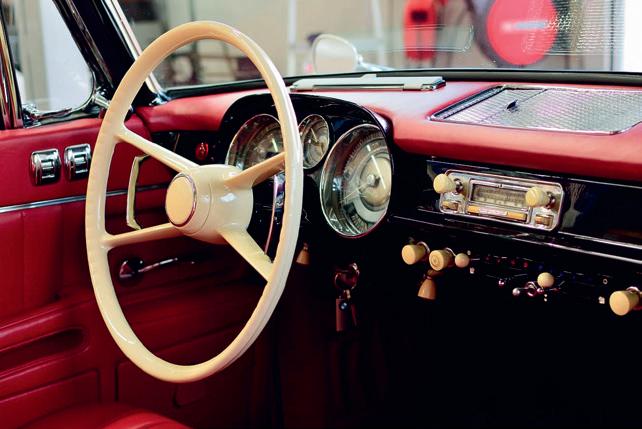

WITH ONE EYE ON THE SUCCESS OF MERCEDES-BENZ, BMW fancied a slice of the profitable American pie – and so it conceived of a range of luxury vehicles to take advantage. The 507 was intended to be a sporty roadster, whereas the 503 coupé and cabriolet were designed to be elegant grand tourers. However, by the time the car was ready its retail price was far larger than BMW’s US importer, Max Hoffman, had intended, and he pulled out of the contract. This left BMW without an infrastructure in this all-important market.
As a result, very few 503s and 507s were sold. Just 413 503s were built, including 139 cabriolets such as the one you see here. Although the model was bought by the likes of Sonja Ziemann, Prince Rainier of Monaco and the King of Belgium, BMW incurred heavy losses on each one it produced – a situation that put the brand’s future in peril.
This particular 503 was built for a BMW AG supplier, and as such it features customised features. The aluminium V8 engine has been enhanced to 180bhp (up from a standard 140bhp) and it boasts a dual-pipe exhaust. The car also has sports suspension from the 507.
MIT EINEM AUGE AUF DEN ERFOLG VON MERCEDESBenz schielend wollte sich auch BMW ein Stück vom lukrativen amerikanischen Kuchen abschneiden. Und entwickelte daher eine Palette von Luxusfahrzeugen. Der 507 war als sportlicher Roadster gedacht, während das 503 Coupé und Cabriolet als elegante Grand Tourer konzipiert waren. Als das Auto vertriebsfertig war, war sein Verkaufspreis jedoch weitaus höher als von BMWs US-Importeur Max Hoffman kalkuliert. Woraufhin er den Vertrag kündigte, was BMW auf diesem wichtigen Markt ohne Infrastruktur zurückließ.
Als Konsequenz fanden nur sehr wenige 503 und 507
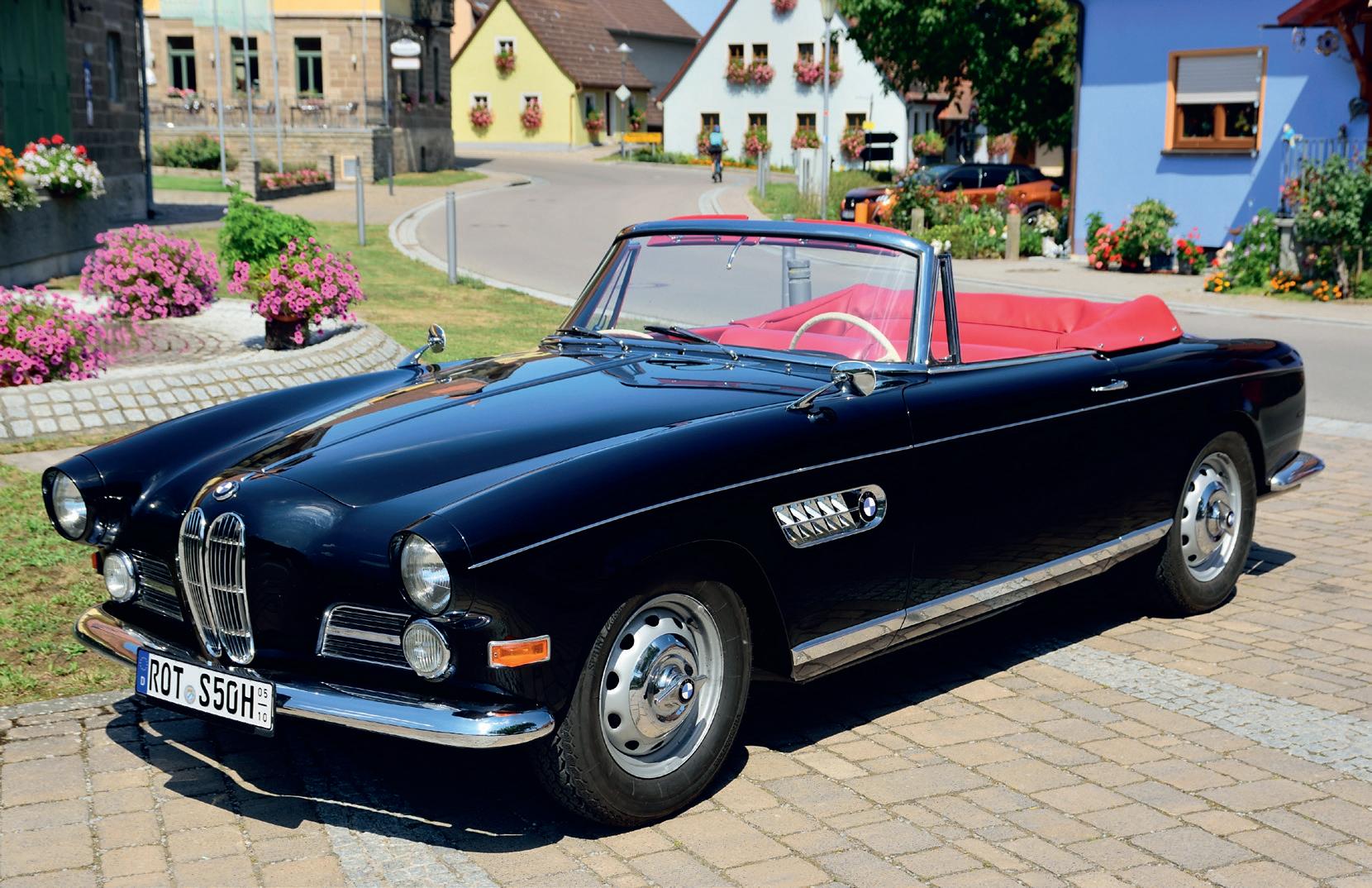
‘The V8 engine has been enhanced to 180bhp, and the 503 also boasts a dual-pipe exhaust along with sports suspension’
„Der V8 wurde auf 180 PS gesteigert; zugleich verfügt der 503 über einen Doppelrohr-Auspuff und ein Sportfahrwerk“
einen Kunden – genau 413 waren es für den 503, darunter 139 Cabriolets wie das hier abgebildete. Zwar entschieden sich Persönlichkeiten wie die Schauspielerin Sonja Ziemann, Fürst Rainier von Monaco und der König von Belgien zu einem Kauf, doch machte BMW mit jedem produzierten Exemplar hohe Verluste – eine Situation, die die Zukunft der Marke gefährdete.
Dieser spezielle 503 wurde für einen BMW-Zulieferer gebaut und ist daher mit einigen speziellen Features ausgestattet.
Darunter ein Auspuff mit doppelten Endrohren, ein von den serienmäßigen 140 auf 180 PS gesteigerter V8 mit Leichtmetallblock und ein Sportfahrwerk aus dem 507.
The upmarket 503 was originally conceived to appeal to the American market.
Der gehobene 503 wurde ursprünglich für den amerikanischen Markt konzipiert.
1956 AC Ace-Bristol
Wilhelm Schmid
CHASSIS BEX 148 WAS FIRST SUPPLIED TO Venezuela for Dr Oscar Lupi. It was one of five Ace-Bristols sent to the South American country. Arriving in Venezuela, BEX 148 was destined for competition and so was sent to the workshop of German garage owner Karl Pentz. Pentz made aerodynamic modifications to this car – along with two other Ace-Bristols – by way of adding a lower air intake and cowled lights, which increased straight-line speed. BEX 148 is the only modified example to survive.
Lupi competed in the car for four years, sporting race number 139. Local circuits including Circuito La Trinidad, La Montana, Valencia and Maracay became its second home. Following retirement, Lupi sold BEX 148 in the early 1960s, with two local owners using it as a road car before it was put into long-term storage. In the 1990s, the AC was purchased by another Venezuelan enthusiast with a view to restoring it. He started the project, but sold it before completion.
Once the car was back in the UK the new owner decided to retain its original period body modifications, as raced by Lupi in the 1950s. AC specialist Nigel Winchester of Winchester Motorsport oversaw the project, and today the Ace-Bristol retains its original body. It’s been repainted in its original shade of red, and retrimmed with beige leather.
CHASSIS BEX 148 GING ZUNÄCHST AN DR OSCAR LUPI aus Venezuela. Als einer von fünf in das südamerikanische Land gelieferten AC Ace Bristol war er für Motorsporteinsätze bestimmt. Nach Ankunft in Venezuela wurde er daher in die Werkstatt des deutschstämmigen Karl Pentz gebracht, wo das Auto – zusammen mit zwei weiteren Ace Bristol – aerodynamische Modifikationen erfuhr. Ein tiefer liegender Lufteinlass und verschalte Scheinwerfer verbesserten die Höchstgeschwindigkeit. BEX 148 ist der einzige Überlebende unter den drei modifizierten venezolanischen Ace-Bristol. Lupi setzte den Wagen vier Jahre lang ein, immer mit der Startnummer 139. Lokale Rennstrecken wie Circuito La Trinidad, La Montana, Valencia und Maracay wurden zu einem zweiten Zuhause. Nach Rücktritt vom Motorsport verkaufte Lupi BEX148 in den 1960er-Jahren. Zwei einheimische Besitzer nutzten ihn als Straßenauto, ehe er für längere Zeit eingelagert wurde. Erst in den 1990er-Jahren erwarb mit Blick auf eine Restaurierung ein anderer venezolanischer Enthusiast den Ace. Er begann zwar mit den Arbeiten, verkaufte den Wagen aber noch vor der Vollendung. Nachdem BEX 148 zurück im Vereinigten Königreich war, entschloss sich der neue Besitzer, das Fahrzeug so, wie es Lupi in den 1950er-Jahren fuhr, zu restaurieren. AC-Experte Nigel Winchester von Winchester Motorsport überwachte das Projekt; und heute erstrahlt der Ace-Bristol wieder in seiner originalen Optik – in der ursprünglichen roten Farbe neu lackiert und mit beigem Leder neu bezogenen Cockpit.
‘Pentz made aerodynamic modifications to this car by way of adding a lower air intake and cowled lights’
„Pentz nahm aerodynamische Modifikationen in Form eines tiefer liegenden Lufteinlasses und verschalter Scheinwerfer vor“

Retaining its original body, the car has been repainted in red and retrimmed in beige hide.
Ohne Änderungen an der Karosserie wurde der Wagen neu in Rot lackiert und mit beigem Leder neu bezogen.
1958 Mercedes-Benz 300 SL Roadster
Alex Niederkofler
ALTHOUGH THE 300 SL GULLWING HAD BEEN A global sensation, transforming the image of MercedesBenz around the world, by mid-1956 sales started to fall. This prompted executives to push through a drop-top version to capitalise on a buoyant Californian market. It took only a matter of months after the prototype’s debut at the 1957 Geneva Motor Show for the car to be production-ready. The 300 SL’s alloy-steel tubular frame was extensively re-engineered to make up for the lack of a roof, and the rear suspension was redesigned to provide better ride comfort and handling. Production ended in 1963, with 1,858 built.
This 300 SL was originally supplied new to the US. It was reimported to Europe in 2004, and was subsequently restored by Robert Eiker of Wuppertal. At this point it was painted silver-grey, at the request of the current owner’s grandfather – who then participated in many Mercedes-Benz 300 SL club excursions to Germany and Italy, with particular highlights including the Salzburgring in 2007 and the Raduno Monte Carlo in 2010. Upon his passing, stewardship of the 300 SL passed to the current owner. In 2019 the Mercedes-Benz was returned to its original colour of white (code DB 50 G); for many years HK-Engineering in Polling has tended to the car.
OBWOHL DER 300 SL FLÜGELTÜRER („GULLWING“) EINE weltweite Sensation war, welche das Image von Mercedes-Benz rund um die Welt veränderte, begannen die Verkäufe ab Mitte 1956 zu sinken. Was im Vorstand den Entschluss zum Bau einer Roadster-Version reifen ließ, um mit ihr vom boomenden kalifornischen Mark zu profitieren. Von der Weltpremiere eines Prototyps auf dem Genfer Salon von 1957 bis zum Produktionsstart vergingen nur wenige Monate. Um das fehlende Dach zu kompensieren, waren mit dem Ziel einer maximalen Steifigkeit umfangreiche Änderungen am Gitterrohrrahmen des 300 SL nötig; zugleich wurde die Hinterradaufhängung zugunsten eines besseren Komforts und Handlings modifiziert. Die Produktion endete 1963 nach 1.858 Einheiten.
Dieser 300 SL wurde neu in die USA geliefert. 2004 wurde er nach Europa reimportiert, wo er im Anschluss von Robert Eiker aus Wuppertal restauriert wurde. Zu diesem Zeitpunkt wurde der Wagen auf Wunsch des Großvaters des heutigen Besitzers silbergrau lackiert. Dieser nahm damals an zahlreichen Mercedes-Benz 300-SL-Clubausfahrten in Deutschland und Italien teil, zu deren Höhepunkten der Salzburgring (2007) und die Raduno Monte Carlo (2010) zählten. Nach seinem Tod ging der 300 SL an den heutigen Besitzer über. 2019 erhielt der Mercedes-Benz seine ursprüngliche Farbe Weiß (Code DB 50 G) zurück; seit vielen Jahren kümmert sich HK-Engineering in Polling um den Wagen.
‘The current car owner’s grandfather participated in many 300 SL club excursions to Germany and Italy’
„Der Großvater des aktuellen Besitzers nahm an vielen 300-SL-Clubexkursionen in Deutschland und Italien teil“

This 300 SL was supplied new to the US. It’s now been repainted in its original white.
Dieser 300 SL wurde neu in die USA geliefert. Mittlerweile erstrahlt er wieder in seiner Originalfarbe Weiß.
1959 BMW 507
Christoph Thurner


DESIGNED BY ALBRECHT VON GOERTZ, THE BMW 507 was introduced in 1956 as a luxury roadster intended to appeal to the North American market. Under the bonnet it housed a 3.2-litre V8 producing around 150bhp, paired with a four-speed manual transmission. This allowed the 507 to reach speeds of up to 122mph. The model was built on a shortened version of the 503’s platform, using a box-section frame with tubular crossmembers carried over from the 501/502 sedan. It boasted independent front suspension with double wishbones, torsion-bar springs and an anti-roll bar, which was an advanced set-up for the car’s time. The rear wasn’t quite as sophisticated, though – it featured a live axle with torsion bars and a panhard rod.
However, the 507 proved to be prohibitively expensive. It cost almost twice the price of a Chevrolet Corvette, which resulted in the US importer, Max Hoffman, drastically scaling back his business plans. This limited production to just 252 units between 1956 and 1959, and plunged BMW into a financial black hole from which it would take years to recover.
Nevertheless, the car did attract notable celebrity owners such as Elvis Presley and racing legend John Surtees. This particular second-series 507, chassis number 70210, was originally delivered to a client in New York. It was extensively restored in Germany between 2013 and 2015.
DER VON ALBRECHT GRAF VON GOERTZ DESIGNTE BMW 507 wurde 1956 als luxuriöser Roadster und mit Blick auf den nordamerikanischen Markt eingeführt. Unter der Haube saß ein 3,2-Liter-V8 mit rund 150 PS, gepaart mit einem Viergang-Handschaltgetriebe. Damit erreichte der 507 eine Höchstgeschwindigkeit von 200 km/h. Das Modell baute auf der verkürzten Bodengruppe des 503 und dem Kastenrahmen mit Rohrtraversen aus der Limousine 501/502 auf. Es verfügte über eine vordere Einzelradaufhängung mit Doppelquerlenkern, Drehstabfedern und Stabilisator – eine für die damalige Zeit fortschrittliche Konstruktion. Die Hinterachse hingegen war nicht ganz so ausgefeilt: eine Starrachse mit Drehstäben und Panhardstab.
Der 507 erwies sich jedoch als unerschwinglich teuer. Er kostete fast doppelt so viel wie eine Chevrolet Corvette, was

‘This second-series 507, number 70210, was originally delivered to a client in New York. It was restored in 2013-15’
„Dieser 507 der zweiten Serie mit Fahrgestellnummer 70210 wurde ursprünglich an einen Kunden in New York ausgeliefert und von 2013 bis 2015 restauriert“
dazu führte, dass der US-Importeur Max Hoffman seine Geschäftspläne drastisch zurückfahren musste. Als Folge blieb die Produktion zwischen 1956 und 1959 auf nur 252 Exemplare begrenzt und stürzte BMW in ein finanzielles Loch, von dem sich die Münchener erst nach Jahren wieder erholten. Dennoch fand das Auto namhafte Besitzer, wie Elvis Presley und Rennsportlegende John Surtees. Dieser 507 der zweiten Serie mit Fahrgestellnummer 70210 wurde ursprünglich an einen Kunden in New York ausgeliefert und von 2013 bis 2015 in Deutschland umfassend restauriert.
The 507 was produced in limited numbers of just 252 units between 1956 and 1959.
Der 507 wurde zwischen 1956 und 1959 in der limitierten Stückzahl von nur 252 Einheiten gebaut.
1959 Bentley S2 Continental by Mulliner
J & F Rassloff
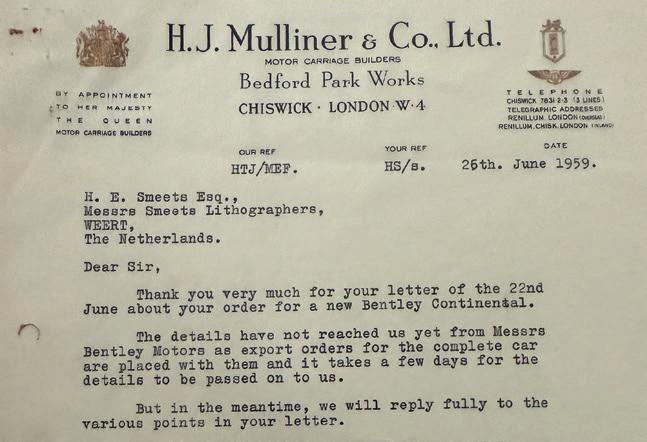
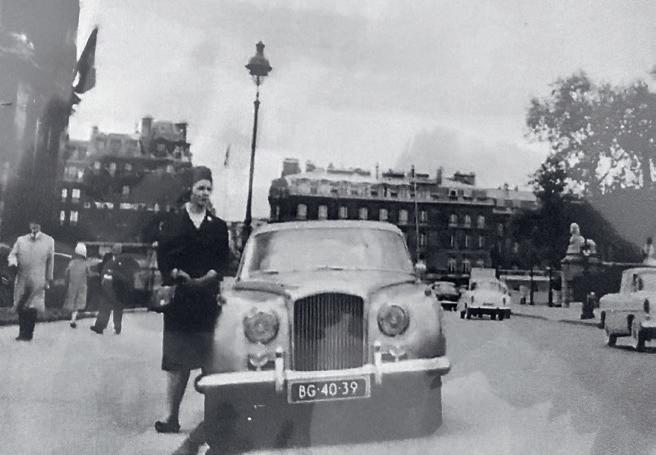
THIS BENTLEY S2 CONTINENTAL COUPÉ, CHASSIS BCA3LAR, is the very first of only 21 left-hand-drive twodoor examples produced. It played a central role in the official launch of the S2 Continental, presented alongside a Flying Spur and a right-hand-drive coupé at the London Motor Show. Printing firm boss Mr Smeets from Weert in the Netherlands commissioned the car in June 1959, before the model’s official release. It was ordered with bespoke features, from extraadjustable seating and reading lamps to curtains and a very rare sunroof. Later, the Bentley was imported to the US by a business friend of Mr Smeets, Hyman Safran, company exec of Safran Printing Co, who then passed the Continental on to James Raymond Coats, a renowned collector in Connecticut. He undertook a respectful restoration of it.
In the late ’80s the Bentley was acquired by Queen drummer Roger Taylor, who held onto it into the new millennium. Being a passionate driver he used the car extensively, and he added some personal touches – most notably a discreet sound system and a vinyl-record changer in the boot. It also has a Becker Telefunken RadioTelefon. Only 12 were ever built between 1970-71. Based on a Becker Mexico radio, it includes a full control unit for Germany’s first-generation A-Netz mobilephone system, and it is now restored and functions again.
The Continental was later returned to the Netherlands and repainted in its original colours. Today it’s a matching-numbers car that made its way to the Concours on its own wheels from northern Germany with its owners, who bought it two years ago.
DIESES BENTLEY S2 CONTINENTAL COUPÉ, CHASSIS
BCA3LAR, ist das erste von nur 21 zweitürigen Exemplaren mit Linkslenkung. Es spielte eine zentrale Rolle bei der offiziellen Vorstellung des S2 Continental und stand neben einem Flying Spur und einem rechtsgelenkten Coupé auf dem Bentley-Stand der London Motor Show.
Der Besitzer der Druckerei Smeets aus dem niederländischen Weert bestellte das Auto schon vor dessen offizieller Markteinführung im Juni 1959. Verbunden mit der Order für eine Reihe spezieller Extras, von zusätzlich verstellbaren Sitzen über Leselampen bis zu Fenster-Vorhängen und einem sehr seltenen Schiebedach. Später importierte ein Geschäftsfreund von Herrn Smeets, Hyman Safran, Präsident der Safran Printing Company. den Bentley in die USA. Von dort ging er weiter an James Raymond Coats, ein bekannter Sammler aus Connecticut, der dem Auto eine respektvolle Restaurierung spendierte.
In den späten 1980er-Jahren kaufte der Schlagzeuger der

‘In the late 1980s the Bentley was acquired by Queen drummer Roger Taylor, who held onto it into the new millennium’
„In den späten 80er-Jahren erwarb QueenSchlagzeuger Roger Taylor den Bentley und behielt ihn bis ins neue Jahrtausend“
Rockgruppe Queen, Roger Taylor, den S2 und behielt ihn bis ins neue Jahrtausend. Als begeisterter Fahrer nutzte er ihn ausgiebig und ergänzte ihn um einige persönliche Features. Darunter ein diskret verstecktes Soundsystem, ein im Kofferraum installierter Schallplatten-Wechsler und ein Becker Telefunken RadioTelefon. Zwischen 1970 und 1971 wurden auf Basis des Becker Mexiko Radios nur zwölf Anlagen gebaut. Es enthält eine vollständige Steuereinheit für die erste Generation des deutschen A-Mobilfunknetzes, ist nun wiederhergestellt und funktionsfähig. Der Continental gelangte später wieder zurück in die Niederlande, wo er in seiner originalen Farbe neu lackiert wurde. Jetzt fahren ihn seine aktuellen Besitzer, die den Matchingnumbers-S2 vor zwei Jahren erwarben, auf eigener Achse von Norddeutschland zum Concours am Tegernsee.
The first left-handdrive two-door S2 built, the car spent its early life in the Netherlands.
Der erste linksgelenkte zweitürige S2 verbrachte sein frühes Autoleben in den Niederlanden.
1960 Maserati 3500
GT Spyder by Vignale
Annekatrin Schmidt-Liedl & Björn Schmidt

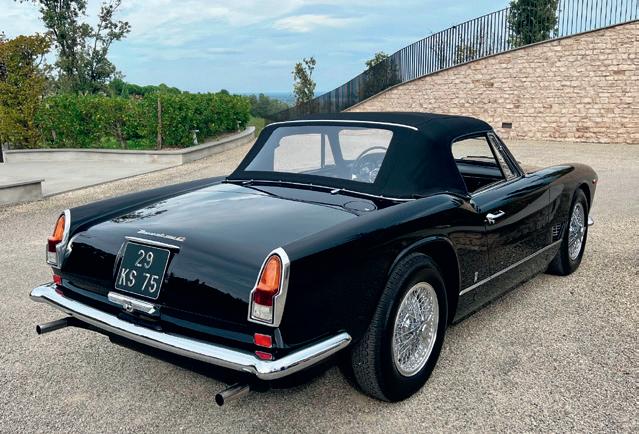
THIS 3500 GT SPYDER WAS ORIGINALLY ORDERED by famous Parisian architect Maitre Jacques Fildier. He would keep the car for less than a year, passing it on to Société de Gestion et d’Entreprise in November 1961. The Maserati would then go to Bernard Peyrot des Gachon, who would keep it for two years. As it passed through the hands of a further two owners, it left Paris for the first time.
Sold to Salvatore Starace of Nice in 1965, the Spyder would later join the collection of Jean Guikas in the 1970s, before passing through the hands of two owners through the 1980s. In 1989 it joined the collection of Bernard Comte, who had the car restored a year later by Sport-Auto Modena. It would return to Paris in the care of Dominique-Gilles Mars in 1991, and would remain in his stewardship until 1998, when it passed to Luc Laureys of Sint-Martens-Latem, Belgium.
The Spyder was sold to Bjoern Schmidt of Stuttgart in 2005; he modified the car with Borrani wire wheels and centre hubs. Four years later the engine and gearbox were reworked by ItalAuto GmbH, Köngen. Between 2022-24 the Maserati was comprehensively restored again, with Bacchelli & Villa of Bastiglia, Italy taking care of the bodywork and paint (back to its original colours), Tralli Franco and Officina Molinari refreshing the mechanicals, Tappezzeria Luppi fixing the trim and Elettrauto Gatti attending to the electrics.
DIESER 3500 GT SPYDER WURDE URSPRÜNGLICH VOM berühmten Pariser Architekten Maitre Jacques Fildier bestellt. Nach noch nicht einmal einem Jahr gab er ihn im November 1961 an die Société de Gestion et d’Entreprise weiter. Der Maserati ging von dort an Bernard Peyrot des Gachon, der ihn zwei Jahre fuhr. Nach zwei weiteren Besitzern verließ er dann Paris zum ersten Mal. 1965 wurde er an Salvatore Starce aus Nizza verkauft, und gelangte dann in den 70er-Jahren in die Sammlung von Jean Guikas. Es folgten während der 80er-Jahre zwei weitere neue Halter.
1989 nahm Bernard Conte den Maserati in seine Kollektion und ließ ihn im Jahr darauf bei Sport-Auto Modena restaurieren. 1991 dann Rückkehr nach Paris , wo ihn Dominique-Gilles Mars bis 1998 die Treue hielt. Über Luc Laureys aus Sint-Martens-

‘This Maserati 3500 GT Spyder was originally ordered by famous Parisian architect
Maitre Jacques Fildier’
„Dieser Maserati 3500 GT Spyder wurde ursprünglich vom berühmten Pariser Architekten Jacques Fildier bestellt“
Latem (Belgien) gelangte das Auto schließlich 2005 zu Björn Schmidt aus Stuttgart. Er spendierte dem 3500 GT BorraniDrahtspeichenfelgen mit Zentralverschluss. Vier Jahre später erhielten Motor und Getriebe eine Auffrischung bei ItalAuto GmbH aus Köngen. Zwischen 2022 und 2024 wurde der Maserati nochmals rundum restauriert. Bacchelli & Villa aus Bastiglia (Italien) kümmerte sich um die Karosserie und die Lackierung (zurück auf den originalen Farbton), Tralli Franco und Officina Molinari um die Mechanik, Tappezzeria Luppi um die Trimmmaterialien und Elettrauto Gatti um die Elektrik.
The Maserati has been comprehensively restored to its original colours in recent times.
Der Maserati wurde kürzlich umfassend und in seinen Originalfarben restauriert.
1960 Fiat-OSCA 1500S
Gabriele Jäger-Kozka
The 1500S features Fiat underpinnings, Pininfarina design and an OSCA engine.
Der 1500S basiert auf Fiat-Komponenten, mit einem Design von Pininfarina und einem Motor von OSCA.

ONCE THE MASERATI BROTHERS WERE UNLEASHED from their contract binds with the company bearing their name, they set up a new firm – OSCA, short for Officine Specializzate Costruzione Automobili – to compete in the popular under-1100cc class of motor sport. Success soon followed, victory at the 1954 Sebring 12 Hours being a particular highlight with Stirling Moss and Bill Lloyd on driving duties in an MT4.
The tie-up with Fiat came when the larger Italian manufacturer realised that its 1200 Cabriolet, although pretty courtesy of its Pininfarina-penned lines, was not powerful enough to be a ‘proper’ sports car. Fiat turned to OSCA and its innovative twin-cam 1500cc engine to give the model some verve, and the result was the Fiat-OSCA 1500 Spider. In July 1960 it was upgraded to the S version, which saw such improvements as disc brakes front and rear.
This particular example was originally delivered new to Switzerland, and it had only two previous owners before its current custodians. They had the OSCA restored over 2200 hours, and as a 60th birthday gift the freshly revamped Spider was handed to Gabi Kozka, who remains its proud co-pilot today. In 2023 the car passed its veteran classification again, and in December 2024 the Kozkas flew the 1500S to Dubai to take part in the 1000 Miglia Experience UAE.
KAUM
HATTEN SICH DIE MASERATI-BRÜDER AUS IHREN
Verträgen mit dem Unternehmen, das ihren Namen trug, befreit, gründeten sie eine neue Firma: OSCA, kurz für Officine Specializzate Costruzione Automobili, um bei Rennen in der populären Hubraumklasse unter 1100 cm³ anzutreten. Der Erfolg ließ nicht lange auf sich warten: Der Sieg beim 12-Stunden-Rennen von Sebring 1954 mit Stirling Moss und Bill Lloyd am Steuer eines MT4 war ein besonderer Höhepunkt.
Die Kooperation mit Fiat kam zustande, als der führende italienische Autobauer feststellte, dass sein 1200er-Cabriolet zwar dank der von Pininfarina entworfenen Linien schön, aber nicht stark genug war, um als „richtiger“ Sportwagen durchzugehen. Um dem Modell etwas mehr Schwung zu verleihen, wandte sich Fiat an OSCA und dessen innovativen 1500-ccmDoppelnockenmotor. Das Ergebnis war der Fiat-OSCA
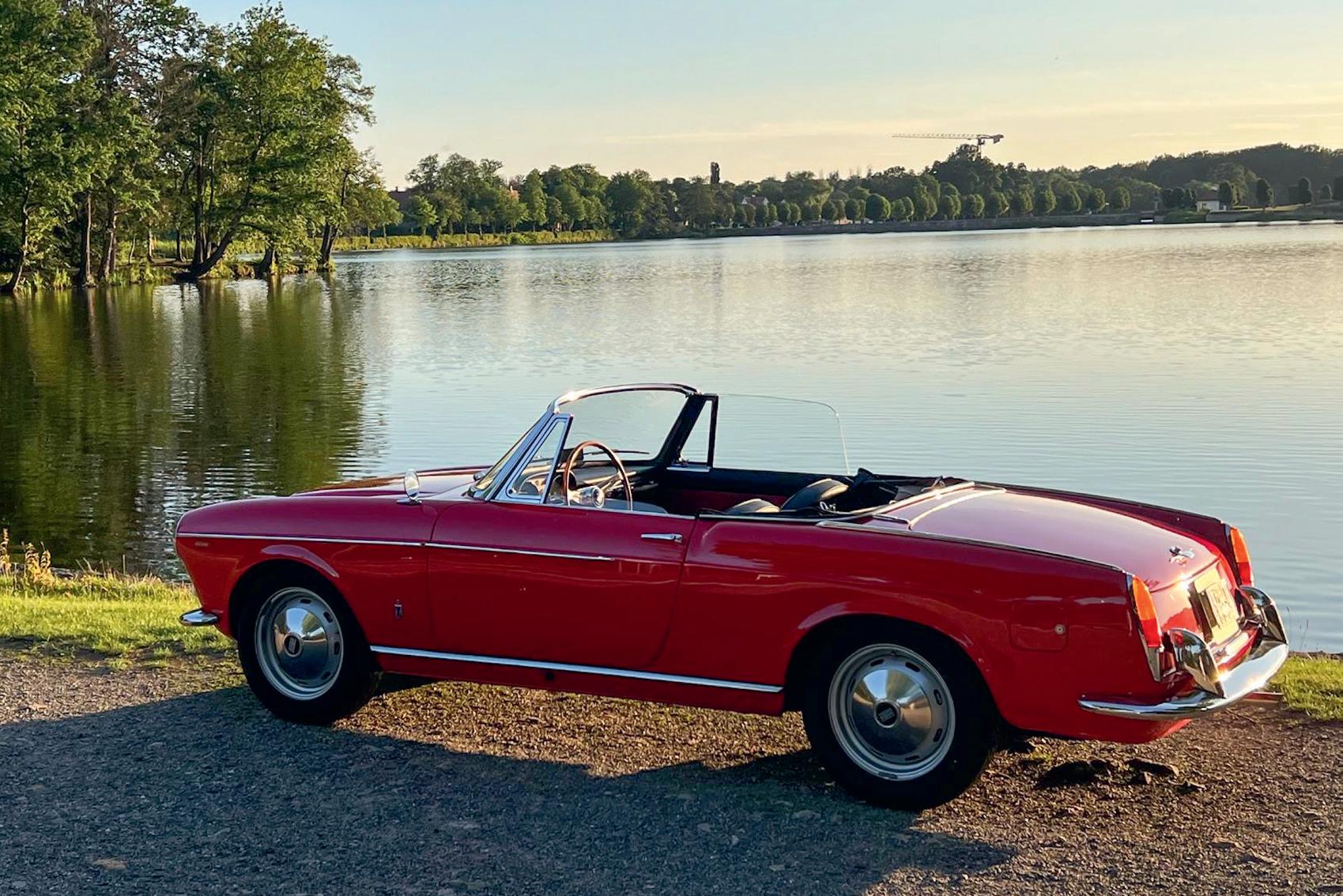
‘This OSCA was delivered new to Switzerland, and it had only two previous owners before its current custodians’
„Dieser Fiat OSCA wurde neu in die Schweiz geliefert und hatte vor seinen aktuellen Eignern nur zwei Vorbesitzer“
1500 Spider. Im Juli 1960 wurde er auf die S-Version aufgerüstet, die unter anderem Scheibenbremsen vorne und hinten erhielt. Dieses besondere Exemplar wurde ursprünglich neu in die Schweiz geliefert und hatte vor seinen aktuellen Eignern nur zwei Vorbesitzer. Sie ließen den OSCA in 2200 Stunden restaurieren, und als Geschenk zum 60. Geburtstag wurde der frisch überarbeitete Spider an Gabi Kozka übergeben, die bis heute seine stolze Co-Pilotin ist. 2023 bestand der Wagen erneut die Veteranenprüfung, und im Dezember 2024 flogen die Kozkas den 1500S nach Dubai, um an der 1000 Miglia Experience UAE teilzunehmen.
1965 Facel Vega Facel III
Peter Achenbach


THE FACEL III BRIDGED THE GAP BETWEEN THE Facellia and later Facel 6 in the Facel Vega line-up, blending French design with a reliable Volvo B18 four-cylinder engine. Although the Facel III helped to restore faith in the brand following the Facellia’s difficulties, the financial woes inflicted by that model meant production would last only a year, with around 620 built between 1964 and 1965. This particular car, FB C287, had a star-studded early life. It was one of four Facel IIIs that were displayed at the 1964 Geneva Motor Show. It was then sold to Margrit Dimmler-Ringier, whose family owned the Swiss publishing house behind the BlickZeitung newspaper.
The current owner’s grandfather ran a Lancia dealership in Zurich, and traded the Facel III against a Flavia in 1968, with the Facel Vega passing to his son as a gift. At the time the new owner was living in Como, Italy, but a year later the car followed his family to the US, and then to Brussels, Belgium in 1976. The Facel III eventually went into longterm storage, and in 1999 it moved to Germany. Originally delivered in dark blue paint, it has since been repainted in a period-correct metallic blue.
DER FACEL III FÜLLTE DIE LÜCKE ZWISCHEN
dem Facellia und dem späteren Facel 6 im Facel-VegaModellprogramm; in der Kombination aus französischem Design und einem zuverlässigen Vierzylinder-Motor von Volvo (B18). Obwohl der Facel III dabei half, nach den Problemen mit dem Facellia den Glauben an die Marke wiederherzustellen, führten die mit diesem neuen Modell verbundenen finanziellen Kraftanstrengungen zum Bau von nur 620 Einheiten in den Jahren 1964 und 1965. Dieses spezielle Modell, FB C287, erlebte glanzvolle frühe Jahre. Zunächst war es einer von vier auf dem

‘This particular example, FB C287, was one of four Facel IIIs that were displayed at the 1964 Geneva Motor Show’
„Dieses spezielle Exemplar, FB C287, war einer von vier Facel III, die 1964 auf dem Genfer Salon gezeigt wurden“
Genfer Salon von 1964 ausgestellten Facel III. Im Anschluss wurde es an Margrit Dimmler-Ringier verkauft, deren Familie das Verlagshaus der Schweizer Boulevard-Zeitung Blick gehörte. Der Großvater des aktuellen Besitzers betrieb einen LanciaHändlerbetrieb in Zürich und tauschte den Facel III 1968 gegen einen Flavia; zugleich gab er den Facel Vega seinem Sohn als Geschenk. Zu jener Zeit lebte der neue Besitzer in Como, doch folgte der Wagen ein Jahr später seiner Familie nach New York und 1976 nach Brüssel. Danach wurde der Facel III lange Zeit eingelagert, ehe er 1999 nach Deutschland gelangte. Ursprünglich in einer dunkelblauen Farbe ausgeliefert, wurde er inzwischen auf ein zeitgenössisch korrektes Metallicblau umlackiert.
The Facel III helped restore a reputation for reliability due to its use of a Volvo engine.
Der Facel III half dank des Einsatzes eines Volvo-Motors den Ruf der Zuverlässigkeit wiederherzustellen.
1965 Ogle Triplex GTS
Christian Hartmann


OGLE BUILT THIS MODEL AS A PROTOTYPE IN collaboration with the Triplex Safety Glass Company. It used laminated safety glass throughout the car, whereby a piece of plastic was sandwiched between two panes – in the roof, windows and in some parts of the doors. It featured an extended panoramic windscreen, and even parts of the pillars incorporated laminated safety glass. The idea was to prove that the material could be used structurally – and this would pave the way for the use of Triplex in glass roofs, sunroofs and bigger windscreens in mainstream vehicles.
Based on a Dart 250/Scimitar platform, the Ogle Triplex GTS (for Glazing Test Special) was exhibited at the 1965 London Motor Show. It was initially owned by Prince Philip until 1969, when it was handed over to Antony Cleminson, the CEO of Triplex. He kept it until 1973, when it was transferred to the National Motor Museum at Beaulieu for 15 years. It was then acquired by a Don Pither, who kept it until 2001. At this stage its original designer, Professor Carl Olson, acquired the car and took it to the US. The current owner bought the Ogle in 2018 and had it expertly restored over five years, bringing it back to its 1965 condition. This is the first time it has been presented at a concours.
OGLE BAUTE DIESES MODELL ALS PROTOTYP IN Zusammenarbeit mit dem Autoglashersteller Triplex. Im gesamten Fahrzeug kam Verbundsicherheitsglas zum Einsatz, bei dem ein Stück Kunststoff zwischen zwei Scheiben – im Dach, in den Fenstern und in einigen Teilen der Türen – eingelegt war. Das Modell bestach durch eine verbreiterte PanoramaWindschutzscheibe, sogar Teile der Dachsäulen enthielten laminiertes Sicherheitsglas. Ziel war es, die strukturelle Einsatzfähigkeit des Materials zu beweisen – und damit den

‘Built in collaboration with the Triplex Safety Glass Company, the Ogle used laminated safety glass throughout’
„In Zusammenarbeit mit der Triplex Safety Glass Company entwickelt. Nutzte der Ogle durchgängig laminiertes Sicherheitsglas“
Weg für den Einsatz von Triplex in Glasdächern, Schiebedächern und größeren Windschutzscheiben für die Großserie zu ebnen. Auf Basis einer Dart 250/Scimitar-Plattform wurde der Ogle Triplex GTS (für Glazing Test Special) auf der London Motor Show von 1965 vorgestellt. Erster Besitzer war Prinz Philip, der ihn bis 1969 nutzte und dann an Triplex-CEO Anthony Cleminson zurückgab. Der behielt ihn bis 1973, um ihn dann für 15 Jahre an das National Motor Museum in Beaulieu auszuleihen. Von dort erwarb Don Pither das Unikat, und erfreute sich bis 2001 an ihm. Bis der frühere Ogle-Chefdesigner, Professor Carl Olson, das Auto entdeckte und in die USA holte. Der aktuelle Besitzer kaufte den GTS 2018 und ließ ihn im Zuge einer fünfjährigen aufwendigen Restaurierung auf den Stand von 1965 zurückbringen. Er wird erstmals auf einem Concours gezeigt.
Prince Philip once owned this clever prototype, which has recently been restored.
Prinz Philip gehörte zu den Besitzern des cleveren Prototyps, der jüngst restauriert wurde.
1965 Lotus 30/L/5
Professor Wolfgang Henseler & Henning Soltau
IN THE EARLY 1960S, COLIN CHAPMAN CLOSELY observed the rise of powerful sports-racing machinery – particularly in the American market, where the so-called Can-Am cars were making headlines. For him, it was a logical step to prove his capabilities in this highly competitive field, and he set out to do so with the creation of the Lotus 30.
Largely designed by Chapman himself, the Lotus 30 featured an ultra-lightweight steel frame reinforced with thin steel plates. Colin drew inspiration from the Y-shaped chassis of the Lotus Elan, reversing and adapting it to mount the engine at the back. The rear suspension featured double wishbones and vertically mounted hydraulic dampers.
According to the magazine article Will 1965 be the Year?
The Development History of the Biggest Lotus (Motor, June 10, 1965), Lotus 30/L/5 was delivered to J Frank Harrison, son of the Coca-Cola founder, and later the CEO of Coca-Cola Bottling Company Consolidated. Harrison’s team manager was Indy legend Jerry Eisert, a renowned designer and mechanic of sports and Indy cars. This ex-Works car was delivered in September 1964 in white, equipped with a Lotus Ford V8 engine (serial number unspecified) and a ZF 5DS20 gearbox with serial number NBG. The car was primarily raced in The Bahamas’ prominent sports car events.
IN DEN FRÜHEN 1960ER-JAHREN STUDIERTE COLIN Chapman aufmerksam den Aufstieg leistungsstarker Sportwagen –speziell in den USA, wo sie ab 1966 in der CANAM-Serie zum Einsatz kommen sollten. Um die Fähigkeiten von Lotus neben der Formel 1 auch bei PS-starken Sportwagen unter Beweis zu stellen, machte sich „Mister Lotus“ an die Konstruktion des ab 1964 erstmals bei britischen Rennen eingesetzten Lotus 30. Der neue Spyder basierte auf einem ultraleichten Zentralrahmen aus Stahl mit aufgesetzter Karosserie aus glasfaserverstärktem Kunststoff (GFK). Chapman ließ sich vom Y-förmigen Rahmen des Lotus Elan inspirieren, rückte den Motor jedoch nun nach hinten und konstruierte eine Hinterradaufhängung an doppelten Dreieckslenkern und mit vertikal montierten Feder/Dämpfer-Paketen.
Laut einem Artikel in The Motor vom 10. Juni 1965 mit dem Titel „Will 1965 be the Year? The Development History of the Biggest Lotus“ wurde der Lotus 30/L/5 im September 1964 in der Farbe Weiß an J Frank Harrison, CEO der Coca-Cola Bottling Company, geliefert. Harrisons Crewchief war Jerry Eisert, legendärer Konstrukteur und Mechaniker, der zuvor schon sehr erfolgreich einen Lotus 19 für seinen Teamchef vorbereitet hatte. Ihr neuer Lotus 30, ein Ex-Werkswagen, war mit einem Ford-V8 (Seriennummer unspezifiziert) und ZF 5DS20-Getriebe mit Seriennummer NBG bestückt. Er kam bevorzugt bei den populären Rennen der Nassau Speed Week auf den Bahamas zum Einsatz.
‘This ex-Works car was delivered in September 1964 with a Lotus Ford V8 engine and a ZF 5DS20 gearbox’
„Dieser Ex-Werkswagen wurde im September 1964 mit einem Ford-V8 und einem ZF 5DS20-Getriebe ausgeliefert“
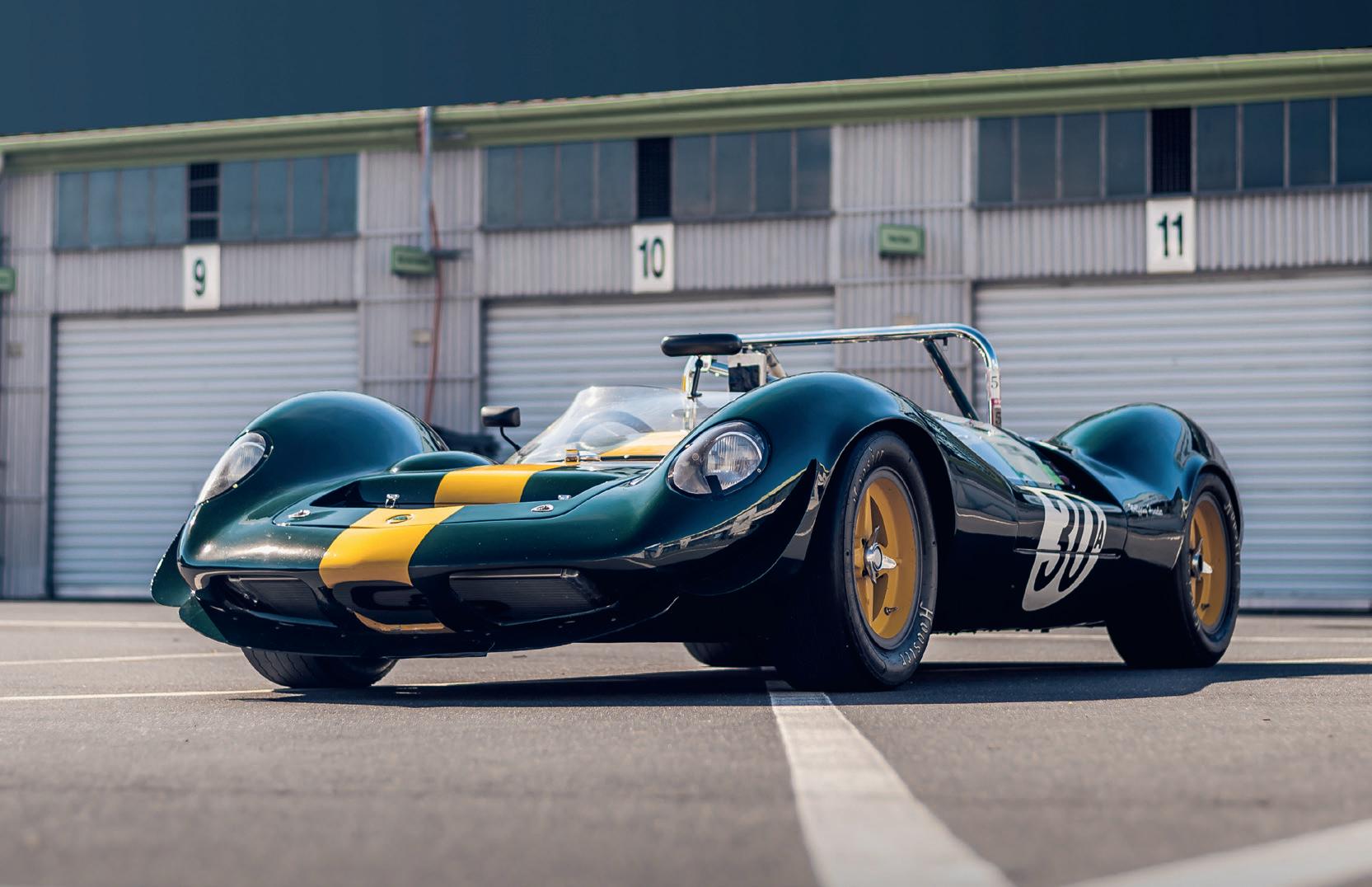
The Lotus 30’s chassis was inspired by that of the Elan, and adapted to run a rear engine.
Das vom Elan inspirierte Chassis des Lotus 30 wurde zur Montage des Motors im Heck entsprechend modifiziert.
1972 Citroën SM
Mylord by Chapron
Thierry Dehaeck
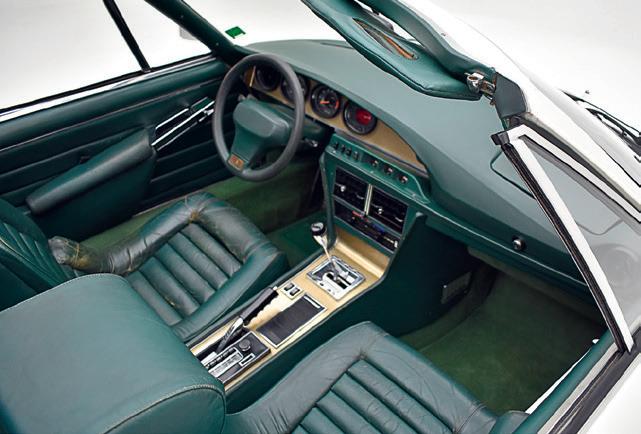
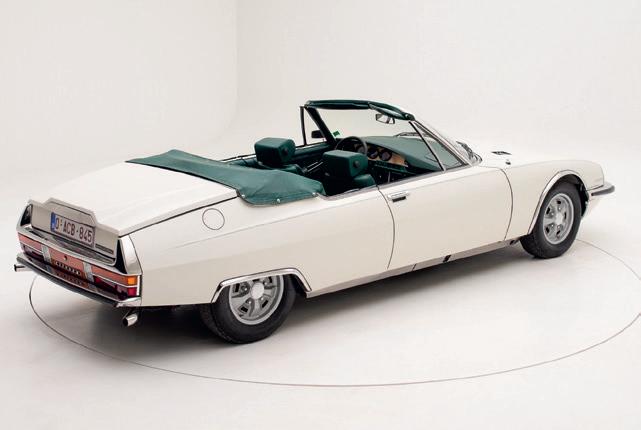
FRENCH COACHBUILDER HENRI CHAPRON HAD been collaborating with Citroën on the brand’s most special projects since the 1930s, and the SM Mylord duly received attention for the 1971 Paris Motor Show. The Mylord cabriolet is a four-seater built on a strengthened SM chassis. At more than twice the price of a normal SM – and not far off that of a Ferrari Daytona – very few were sold. This is the second of a mere five ever built, all of which still reside in Europe and remain in running condition.
Fitted with air-conditioning, trim-matched leather steering wheel and dashboard, chrome wheelarches and a Continental Edison radio, this particular car took a leading role on Chapron’s 1972 Paris Motor Show stand. After wowing the show crowds, it was sold to Mr Develay, a butcher from Évreux. Denys Joannon, an official Citroën dealer living in Saint-Étienne-sous-Bailleul, then owned the car from 1975 to 2007; it stayed in the city in the hands of François Phelouzat from then until 2016, when its current owner took stewardship. This Mylord has never been restored, and the paint finish is 65 percent original, while the interior is 100 percent as it was when it was rolled onto the Paris Motor Show stand back in 1972.
DER FRANZÖSISCHE KARROSSERIEBAUER HENRI
Chapron arbeitete schon seit den 1930er-Jahren mit Citroën an den ausgefallensten Spezialprojekten – eine Tradition, die nach Cabrio-Umbauten der DS „Mylord“ mit einer auf dem Pariser Salon von 1971 gezeigten Offen-Version des SM fortgesetzt wurde. Der Mylord war ein viersitziges Cabrio auf verstärkter SM-Bodengruppe. Zu einem Preis, der mehr als das Doppelte eines normalen SM betrug – und fast das Niveau eines Ferrari Daytona erreichte – wurde nur eine Handvoll gebaut. Dies ist das zweite Exemplar von nur fünf jemals gebauten, die alle in Europa und in noch fahrbereitem Zustand geblieben sind.
Ausgestattet mit Klimaanlage, grünfarbigen Lederbezügen für Sitze, Lenkrad und Armaturenbrett, Chromzierleisten an den Radläufen und einem Continental Edison Radio, nahm dieses Modell auch auf dem Chapron-Stand des Salons von 1972 eine prominente Rolle ein. Nachdem er das Messepublikum begeistert hatte, wurde der Mylord an Monsieur Develay, einen Metzger aus

‘This is the second of a mere five ever built, all of which still reside in Europe and remain in running condition’
„Dies ist das zweite Exemplar von nur fünf jemals gebauten, die alle in Europa und in noch fahrbereitem Zustand geblieben sind“
Évreux, verkauft. Denys Joannon, offizieller Citroën-Händler aus Saint-Étienne-sous-Bailleul, besaß den Wagen von 1975 bis 2007. Danach blieb er in dieser normannischen Gemeinde, nun jedoch im Besitz von François Phelouzat, bis er 2016 von seinem jetzigen Eigner übernommen wurde. Dieser Mylord wurde nie restauriert, der Lack ist zu 65 Prozent original, während sich der Innenraum zu 100 Prozent noch so präsentiert wie 1972 auf dem Pariser Salons.
This particular SM Mylord has never been restored, and the trim is 100 percent original.
Dieser spezielle SM Mylord wurde nie restauriert und besitzt noch einen zu 100 Prozent originalen Innenraum-Trimm.
1970 Citroën DS21 IE Injection Cabriolet by Chapron
Dieter Rickert
EVER SINCE THE DS MADE ITS DEBUT IN 1955, there had been calls for a drop-top version. Citroën finally acquiesced in 1960 and offered a Cabriolet – the Décapotable – as a factory option, designed in-house by Flaminio Bertoni the creator of the original DS. However, the assembly wouldn’t easily fit onto the regular production lines due to the need for a reinforced chassis and extended doors. The model was therefore built by Henri Chapron at his workshop in the Levallois-Perret suburb of Paris.
This particular car, chassis FA5391, is not only part of the very rare late series with Bosch fuel injection, it is even more special – it boasts all the possible special options that could be ordered at the time. It features the Grand Chauffage front and rear heating system, a fully poweroperated hood that’s double-lined with an interior headliner, electrically operated windows, a mobile front centre armrest, comfort headrests and a seatbelt system.
Until 2011 the DS21 IE Injection Cabriolet resided in France and Monaco, and in the hands of its new custodian it was treated to a restoration intended to make it the world’s best example of the breed. It was entrusted to the foremost authority on the DS, Vincent Crescia, to carry out the work. This took three years, and was completed in 2016.
SEIT SEINEM DEBÜT IM JAHRE 1955 ERTÖNTEN RUFE nach einer Cabrio-Version der DS. 1960 kam Citroën endlich den Kundenwünschen nach: Mit dem Décapotable, als Werkscabriolet in-house entworfen von Flaminio Bertoni, dem Designer der originalen DS. Da sich jedoch die Montage aufgrund von Karosserieverstärkungen und längerer Türen nicht leicht in die Großserienfertigung integrieren ließ, übertrug Citroën den Bau an Henri Chapron und dessen Werk in der Pariser Vorstadt Levallois-Perret.
Dieses Exemplar, Chassis FA 5391, gehört nicht nur zu der sehr seltenen Serie mit Bosch-Benzineinspritzung, sondern ist – da mit zahlreichen damals bestellbaren Extras ausgestattet – sogar noch spezieller. Es verfügt über eine Sitzheizung für die vorderen und hinteren Sitze (Grand Chauffage), ein elektrohydraulisch versenkbares Verdeck – doppelt gefüttert und mit einem Dachhimmel – elektrische Fensterheber, eine hochklappbare vordere Mittelarmlehne, Komfort-Kopfstützen und Sicherheitsgurte.
Bis 2011 befand sich das DS21 IE Injection Cabriolet in Frankreich und Monaco; dann ließ ihn sein neuer Besitzer mit dem Ziel, zum weltweit besten Exemplar der Baureihe zu werden, aufwändig restaurieren. Dazu gab er das Auto in die Hände der obersten Autorität in Sachen DS, Vincent Crescia. Die ausgeführten Arbeiten gingen über drei Jahre und waren 2016 abgeschlossen.
‘In the hands of its new custodian it was treated to a restoration intended to make it the world’s best example of the breed’
„Sein neuer Besitzer ließ ihn mit dem Ziel, zum weltweit besten Exemplar der Baureihe zu werden, aufwendig restaurieren“

The car’s restoration was carried out by leading DS authority Vincent Crescia.
Die Restaurierung des Autos wurde von der führenden DS-Autorität, Vincent Crescia, durchgeführt.
1970 Mercedes-Benz
ALTHOUGH THE 600 GROSSER WAS THE PREFERRED conveyance of despots, plutocrats and celebrities alike, the shiniest aspect of the Three-Pointed Star’s regular production line-up was the W111 series. The V8-powered 280 SE Coupé represented the very top of that range in the years it was produced – 1970 and 1971 only. Under the bonnet lay the M116 3.5-litre V8, making the model the first post-war Mercedes-Benz with a displacement of more than 3.0 litres. It produced 200bhp, enough to whisk passengers to 60mph in less than ten seconds and on to an autobahn-pleasing 125mph.
While based on the W110/W111 platform, the 280 SE’s larger engine necessitated several design tweaks, such as the fitment of a wider and lower front grille. This led to these cars being known as the ‘flachkühler’, meaning ‘flat radiator’. As such, these models are among the last truly hand-built Mercedes-Benzes. The W111 also introduced new safety innovations, pioneering the use of crumple zones, a padded dashboard and a collapsible steering column.
A mere 3270 examples of the 280 SE Coupé were built in total. This particular machine was first delivered to the Netherlands. It’s one of 72 cars finished in dual-tone white-grey and dark-grey. Restored in Germany to Condition 1 quality in 2021-22, it recently won an award in the 1950/60/70s Coupé class at the 2025 Lugano Elegance.
OBWOHL DER GROSSE 600 DAS BEVORZUGTE
Beförderungsmittel von Despoten, Plutokraten, Aristokraten, und Promis war, strahlte die W-111-Serie innerhalb des GroßserienProgramms des dreizackigen Sterns am hellsten. Das nur in den Jahren 1970 und 1971 produzierte 280 SE 3.5 Coupé markierte die absolute Spitze der Baureihe. Der unter der Haube installierte 3,5-Liter-V8 (M116) machte das Auto zum ersten NachkriegsMercedes-Benz mit einem Hubraum von über drei Litern. Er leistete 200 PS und beschleunigte die Passagiere in unter 10 Sekunden von 0 auf 100 km/h, während sie auf der Autobahn mit 210 km/h dahingleiten konnten. Obwohl der 280 SE auf der W110/W111-Plattform basierte, erforderte sein größerer Motor einige Designänderungen, wie den Einbau eines breiteren und niedrigeren Kühlergrills. Dies führte zur Bezeichnung dieser Modelle als „Flachkühler“, zugleich gehörten sie zu den letzten wirklich handgefertigten Mercedes-Benz. Der W111 führte auch neue Sicherheitsinnovationen ein und war Vorreiter bei der Verwendung von Knautschzonen, einem gepolsterten Armaturenbrett und einer Teleskoplenksäule mit Pralltopf im Lenkrad, wodurch sich die Lenksäule bei einem Frontalunfall nicht direkt in Richtung Fahrer bewegte. Insgesamt wurden nur 3270 Exemplare des 280 SE 3.5 Coupé gebaut. Dieses Fahrzeug ging als eines von 72 Exemplaren in der ZweifarbLackierung Weißgrau/Dunkelgrau neu in die Niederlande. 2021/22 wurde es in Deutschland in den Zustand 1 restauriert und gewann kürzlich bei der Lugano Elegance 2025 eine Auszeichnung in der Coupé-Klasse 1950er/60er/70er Jahre.
‘First delivered to the Netherlands, this car is one of 72 finished in dual-tone white-grey and dark-grey’
„Dieser neu in die Niederlande ausgelieferte Wagen ist einer von 72 in der Zweifarb-Lackierung Weißgrau/Dunkelgrau“

The 200bhp 3.5-litre V8-powered 280 SE Coupé was produced in 1970 and 1971 only.
Das 280 SE Coupé mit 200 PS starkem 3,5Liter-V8 wurde nur 1970 und 1971 produziert.
1972 Ferrari 365 GTC/4
Private Collection
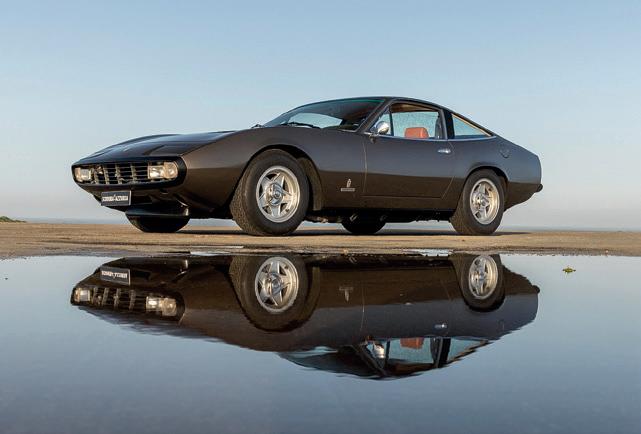
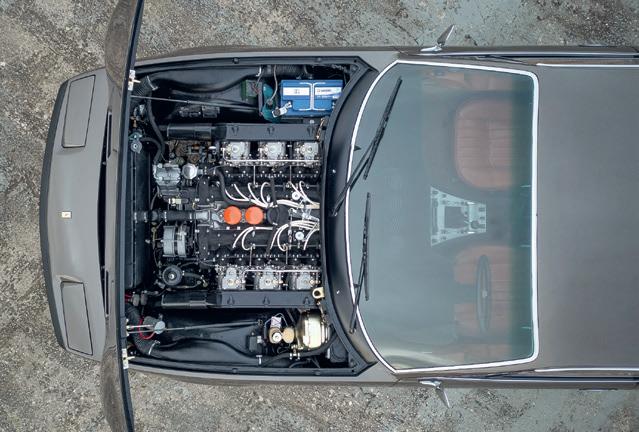
DESIGNED BY PININFARINA’S FILIPPO SAPINO, THE Ferrari 365 GTC/4’s flowing wedge shape was a departure from the more traditional profile of its predecessors. Sporting the proportions of a traditional two-seater but with folddown rear seats, it made its debut at the 1971 Geneva Motor Show as a replacement for the 365 GTC and 365 GT 2+2.
The 365 GTC/4 was designed to be more subdued and focused on luxury than the 365 GTB/4 built on the same chassis. As such, it was much easier to use in day-to-day traffic, thanks to the fitment of power steering, softer spring rates, electric windows and air-conditioning. It also had self-levelling rear suspension courtesy of Koni.
Nevertheless, the Ferrari was still potent in the finest Maranello tradition: its 4.4-litre Colombo V12 produced between 320bhp (US) and 340bhp (Europe) courtesy of six twin-choke Weber carburettors. This meant a 162mph top speed and a 0-60mph time of just 6.5 seconds. Only 505 examples were ever built, with much of the production run ending up in the US. The current owner acquired this particular car in 2023 and restored it to concours condition in 2024.
VON PININFARINAS DESIGNER FILIPPO SAPINO gezeichnet, war die fließend-geschwungene Keilform des Ferrari 365 GTC/4 eine Abkehr vom traditionellen Profil seiner Vorgänger. Mit den Proportionen eines zweisitzigen Coupés (und umklappbaren Notsitzen im Fond) feierte er als Nachfolger des 365 GTC und 365 GT 2+2 auf dem Genfer Salon von 1971 Premiere. Das Design sollte zurückhaltender und stärker auf Luxus fokussiert sein als beim 365 GTB/4, mit dem sich das Modell die Bodengruppe und das Fahrwerk teilte. Dank Servolenkung, weicherer Federraten, elektrischer Fensterheber und einer Klimaanlage ließ sich der 365 GTC/4 im täglichen Verkehr leichter bewegen. Zugleich besaß er eine der Hinterachse eine hydraulische Niveauregulierung von Koni.
Nichtsdestotrotz mangelte es auch diesem Ferrari nicht an Leistung in bester Maranello-Tradition: der 4,4-Liter-V12 von Colombo leistete, von sechs Weber-Doppelvergasern gespeist, zwischen 320 PS (USA) und 340 PS (Europa). Was eine Höchstgeschwindigkeit von 260 km/h und eine 0-100-km/hSprintzeit in unter sieben Sekunden ermöglichte. Nur 505 Exemplare wurden jemals gebaut, wovon die große Mehrzahl in die USA ging. Der aktuelle Besitzer erwarb dieses spezielle Auto im Jahr 2023 und ließ es 2024 auf Concours-Standards restaurieren.
RICARDO BRAVO

‘The model was designed to be more subdued and focused on luxury than the 365 GTB/4 built on the same chassis’
„Das Modell sollte zurückhaltender und luxusorientierter sein als der auf der derselben Plattform basierende 365 GTB/4“
Only 505 examples of the wedge-shaped 155mph Ferrari 365 GTC/4 were ever built.
Nur 505 Exemplare des keilförmigen und 260 km/h schnellen Ferrari 365 GTC/4 wurden jemals gebaut.
1976 Lamborghini Countach LP400
Private
Collection
Countach was built for the Paris Motor Show and was pictured on the brochure cover.
Der Countach wurde für den Pariser Salon gebaut und zierte auch das Cover der Verkaufsbroschüre.

EVERY LAMBORGHINI COUNTACH IS SPECIAL, BUT this LP400 is particularly so: it was built for the Paris Motor Show as a display car, and featured on the cover of the promotional brochure for the show.
Its first registered owner was also special – it was bought by John Corigliano, an American composer who would later win an Academy Award for writing the score for the 1998 film The Red Violin. Corigliano imported the Countach to the US, where it was registered in New Jersey on August 12, 1977 with the license plate ‘SPEEDY’. He kept the car for 20 years, selling it to Dr John L Casti, an American mathematician and professor at the University of Arizona and the University of Vienna. Two years later Casti had the Countach fully restored by Classic Coach Repair in Elizabeth, New Jersey. This process took two years, and in 2012 he sold it to the third and current owner, who is based in Munich.
In 2024 the Countach was treated to an overhaul of the engine, transmission and suspension by specialist SH Renntechnik, run by Stephan Hüttl. The odometer stands at approximately 40,000km, and the car retains matching-numbers parts and its original colour combination.
JEDER LAMBORGHINI COUNTACH IST SPEZIELL, aber dieser LP400 ganz besonders: Denn er wurde als Ausstellungsfahrzeug für den Pariser Salon gebaut und zierte auch die Vorderseite der für die Messe produzierten PromotionBroschüre. Auch sein erster Besitzer war speziell, nämlich John Corigliano, ein amerikanischer Komponist, der später einen Oscar für die von ihm komponierte Musik des Films „Die rote Violine“ (1998) gewann.
Corigliano importierte denn Countach in die USA, wo er ihn mit dem Kennzeichen „SPEEDY“ am 12. August 1977 in New Jersey zuließ. Er behielt ihn 20 Jahre, eh er ihn an Dr. John L. Casti, ein amerikanischer Mathematiker und Professor an der University of Arizona und der Technischen Universität Wien verkaufte. Zwei Jahre später ließ Casti den Lamborghini bei Classic Coach Repair in Elizabeth, New Jersey, komplett restaurieren. Die Arbeiten liefen über zwei Jahren
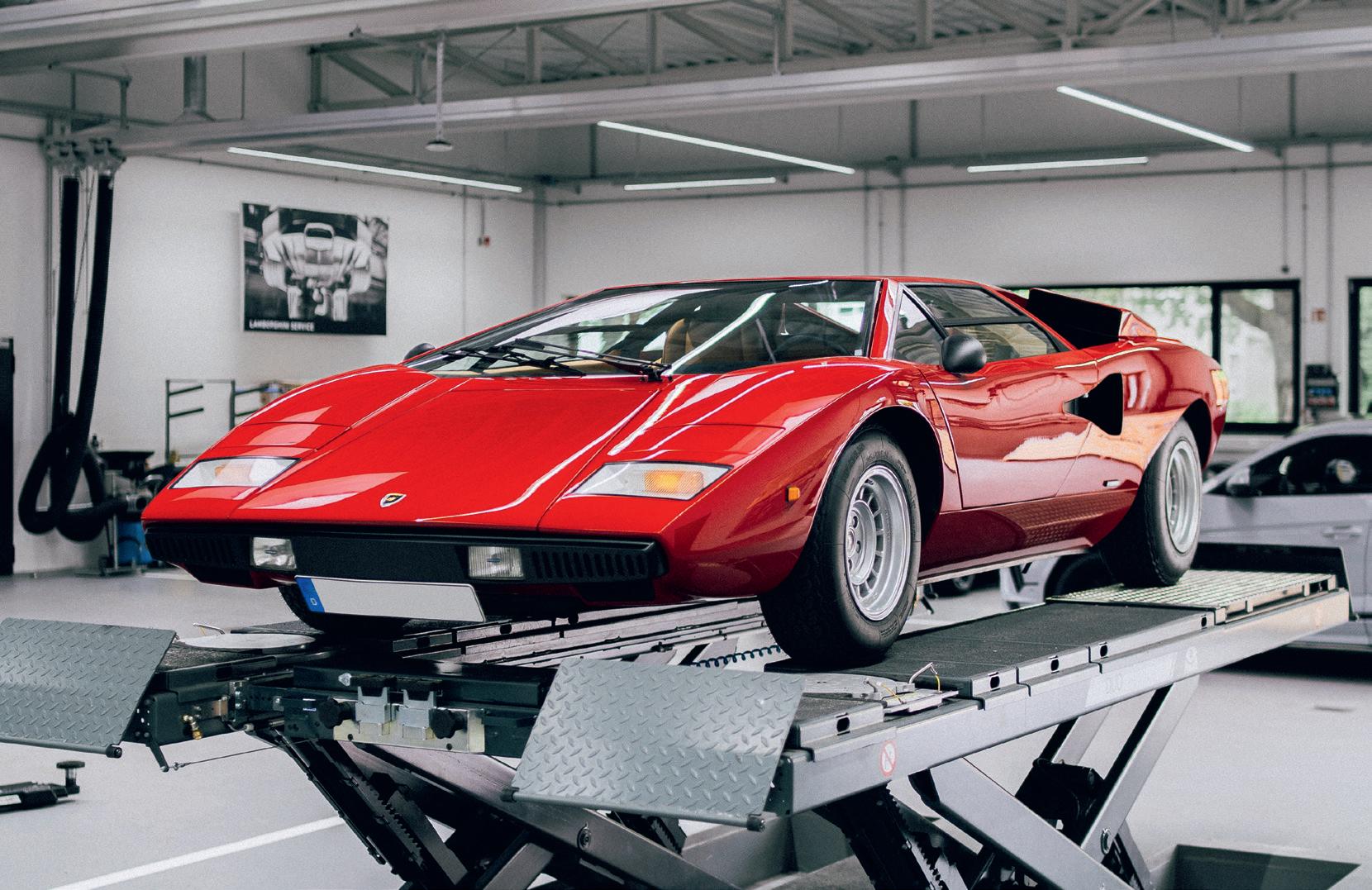
‘Its first owner was John Corigliano, a who would later win an Academy Award for writing the score for The Red Violin’
„Sein erster Besitzer war John Corigliano, der später einen Oscar für die von ihm komponierte Musik für ‚Die rote Violine‘ gewann“
und endeten 2012 mit dem Verkauf an den dritten und aktuellen, in München wohnenden Besitzer. 2024 erfuhr der Countach beim von Stephan Hüttl geleiteten Spezialbetrieb SH Renntechnik eine Überholung von Motor, Kraftübertragung und Fahrwerk. Der LP 400 hat bis jetzt rund 40.000 Kilometer auf der Uhr und behielt seine matchingnumbers-Teile ebenso wie die originale Farbkombination.
1965 Ferrari 275 GTS
Private
Collection
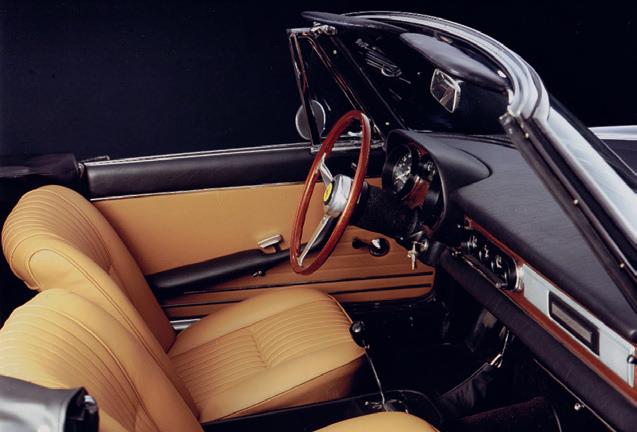

THE 275 GTS IS ONE OF THE RAREST PRODUCTION models to hail from Ferrari, with a mere 200 built between 1964 and 1966. This particular example, chassis no. 07383, was first delivered to a Milanese client via Crepaldi Auto in June 1965. Despite various endeavours, not least by Marcel Massini, its life up until 1986 is fairly unknown, apart from the presence of a few sales advertisements from the US. A broker acquired the Ferrari in California in 1986 and shipped it back to Europe, whereupon the current owner bought it.
At the time, the car’s original white paintwork had been replaced with a non-factory red. The owner used the 275 GTS regularly until 1997, when mechanical and electrical problems arose bit by bit. In 2000 it was entrusted to Edi Wyss Engineering for a full nut-and-bolt restoration, which would take more than two years to complete.
The process would involve Egidio and Roberto Brandoli, Montale (bodywork); Piero Cremonini, Lesignana (paintwork); Adolfo Bertacchi (electrical equipment); Francesco Zoelly, Regensdorf (engine refit); and the Luppis of Modena (dashboard) – along with various other experts and helpers. Areas of attention included rectifying crash damage, repairing the cylinder heads, remounting the original front screen, installing an authentic wooden dashboard, and much more besides. The 275 GTS’s current colour combination is period correct – Grigio Ferro Metallizzato with camel Connolly hide trim. It achieved Classiche certification in 2016.
DER 275 GTS ZÄHLT ZU DEN SELTENSTEN SERI-ENMODELLEN von Ferrari; zwischen 1964 und 1966 wurde er nur 200-mal gebaut. Dieses spezi-elle Modell, Chassisnummer 07383, ging im Juni 1965 über Crepaldi Auto an einen Mailänder Kun-den. Trotz diverser Recherchen, nicht zuletzt von Marcel Massini, bleibt seine Historie – abgesehen von ein paar Verkaufsanzeigen aus den USA – bis 1986 weitgehend im Dunkeln. In jenem Jahr er-warb dann ein Broker den Ferrari in Kalifornien, verschiffte ihn zurück nach Europa, wo ihn dann sein aktueller Besitzer erwarb. Zu diesem Zeit-punkt war die originale weiße Farbe einem nicht werkskonformen Rot gewichen. Der Besitzer fuhr den 275 GTS regelmäßig bis 1997, ehe nach und nach mechanische und elektrische Probleme auftraten. Im Jahr 2000 wurde das Fahrzeug für eine komplette „nut-and-bolt”Restaurierung Edi Wyss Engineering anvertraut, die sich bis zur Fina-lisierung über zwei Jahre erstreckte.
An dem Prozess beteiligt waren Egidio und Roberto Brandoli, Montale (Karosserie); Piero Cremonini, Lesignana (Lackierung);
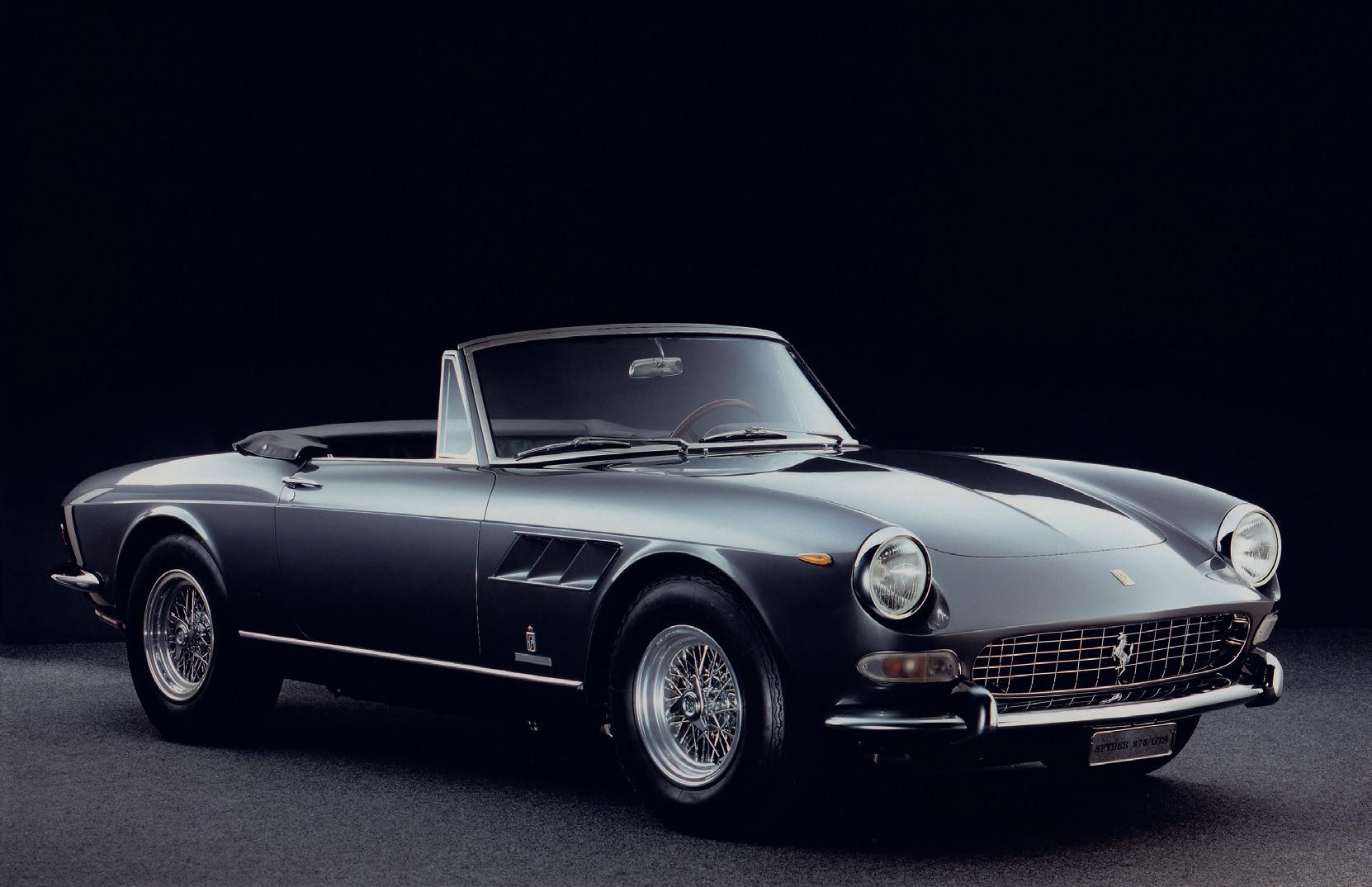
‘The 275 GTS’s current colour combination is period correct. The car achieved Classiche certification in 2016’
„Die aktuelle Farbkombination des 275 GTS ist historisch korrekt. 2016 erhielt der Wagen das Classiche Zertifikat“
Adolfo Bertacchi (Elektrik); Francesco Zoelly, Regensdorf (Motorüberholung) und Luppis of Modena (Armaturenbrett) – zu-sammen mit diversen weiteren Experten und Hel-fern. Zu den wichtigsten Aufgaben gehörten die Beseitigung von Unfallschäden, die Reparatur der Zylinderköpfe, das Wiedereinsetzen der originalen Windschutzscheibe, der Einbau eines authenti-schen Holzarmaturenbretts und vieles mehr. Die aktuelle Farbkombination des 275 GTS ist nun his-torisch korrekt – Grigio Ferro Metallizzato mit ei-nem Interieur in Connolly Kamelleder. Der Ferrari erhielt 2016 das Classiche Zertifikat.
In 2000 the Ferrari underwent a full nutand-bolt restoration taking over two years.
Im Jahr 2000 erfuhr der Ferrari eine über zwei Jahre dauernde „Nut-and-bolt”Restaurierung.
1960 Aston Martin DB4
Maud Beetz


THE ASTON MARTIN DB4 WAS A MAJOR STEP forward for its manufacturer – it was the marque’s first model to use the patented Superleggera construction method of Carrozzeria Touring, and it also elevated the brand to Ferrari-rivalling glamour. The DB4 astounded the crowds upon its 1958 London Motor Show debut, and it set the styling tone for Aston Martin for the next decade.
The car was potent, too, thanks to its new Tadek Marekdesigned 3.7-litre straight-six engine. It’s also notable for being the first model built in the then-new Newport Pagnell factory. Its 240bhp was enough for the DB4 to crack 60mph in less than 10.0 seconds, and top out at just shy of 140mph.
This particular DB4 is the 87th to roll off the line. It was originally delivered in left-hand drive, and its first owner was a Charles E Fredericks from Los Angeles; it is reasonable to assume that this was the Hollywood actor. He put the car to good use, clocking up 27,330 miles up to 1961. Two further American owners followed Fredericks, with the car deemed ‘lost’ after 1971. In 2009 it was discovered in a garage, however, having been stymied by a transmission problem for 38 years. Fortunately it had been well protected from the elements, and it was free of rust with only minor damage. The DB4 moved from Hollywood to Berlin, and was treated to a six-year restoration that was finished in spring 2025.
DER DB4 WAR EIN GROSSER SCHRITT VORWÄRTS FÜR
Aston Martin. Er war das erste Modell der Marke mit einem patentierten Superleggera-Aufbau der Carrozzeria Touring und hob die Briten auf das Glamour-Image des Konkurrenten Ferrari. Der DB4 begeisterte bei seinem Debüt auf der London Motor Show von 1958 die Besucher und definierte für die nächste Dekade die Design-Ausrichtung von Aston Martin. Er war auch das erste im damals neu errichteten Werk Newport Pagnell gefertigte Auto. Dank des von Tadek Marek entwickelten 3,7-Liter-Reihensechszylinders mangelte es dem DB4 auch nicht an Power. Mit 240 PS beschleunigte er in unter zehn Sekunden von 0 auf 100 km/h und erreichte eine Höchstgeschwindigkeit von 225 km/h.
Dieser spezielle DB4 war das 87. vom Band gerollte Exemplar. Er wurde als Linkslenker an Charles E Fredericks

‘Deemed ‘lost’ after 1971, in 2009 it was discovered in a garage having been stymied by a transmission problem’
„Nach 1971 als ‚lost‘ geltend, wurde er 2009 in einer Garage wiederentdeckt, wo er wegen eines Getriebeproblems abgestellt worden war“
aus Los Angeles, vermutlich ein Hollywood-Schauspieler, geliefert. Dieser nutzte den Wagen ausführlich und spulte mit ihm bis 1961 knapp 44.000 Kilometer ab. Auf Fredericks folgten zwei weitere amerikanische Besitzer; nach 1971 galt der DB4 dann als „lost“. 2009 wurde er schließlich in einer Garage wiederentdeckt, wo er mit einem Getriebeproblem 38 Jahren lang abgestellt worden war. Zum Glück war er gut vor den Elementen geschützt worden; so fanden sich kein Rost und nur geringe Gebrauchsspuren. Der DB4 zog später von Hollywood nach Berlin und erhielt dort eine sechsjährige Restaurierung, die im Frühjahr 2025 abgeschlossen wurde.
The left-hand-drive DB4 has recently emerged after a six-year restoration.
Der linksgelenkte DB4 erstrahlt nach einer sechsjährigen Restaurierung wieder in neuem Glanz.
1967 Serenissima Agena
Alexander Wiesner
The V8-powered Agena prototype was designed to be a high-end grand tourer.
Der von einem V8 angetriebene Agena
Prototyp war als Highend GT konzipiert.
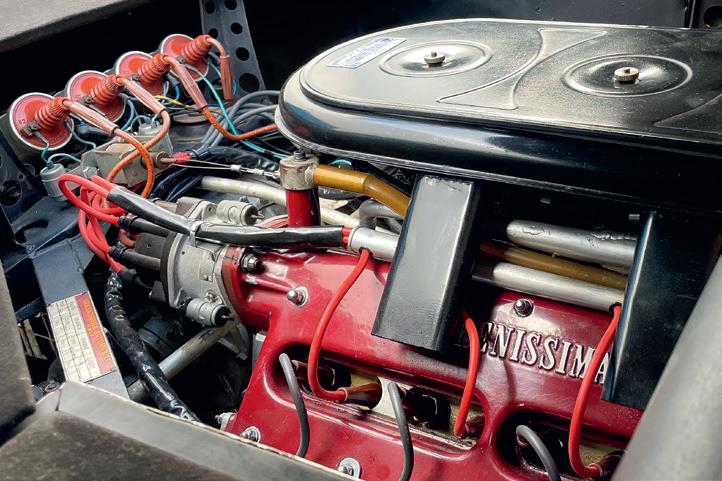
COUNT VOLPI HAD A HAND IN MANY OF THE MOST revered projects of the early 1960s, particularly with regards to his financial involvement in the Ferrari 250 GTO. After the infamous Palace Revolt, or Great Ferrari Walkout, of key Maranello staff following a dispute with the wife of Enzo il Commendatore Ferrari, Volpi was responsible for the 250 ‘Breadvan’, and he also had a short-lived stint with ATS. Out of the ashes of that came Serenissima, a brand that was launched in 1963 with the intention of competing for racing and road honours. This particular car is a unique prototype, designed as high-end grand tourer. At its heart is an Alberto Massimino-designed 3.5-litre twin-overheadcam V8 engine with twin-spark ignition, similar to the Le Mans Spyder’s, which is located in a box structure with tubular front and rear subframes. It was built by Società Autostar, a company owned by Volpi.
With financial pressures eventually leading to Serenissima’s closure, series production never happened, and after road testing came to an end in 1969 the Agena was mothballed at Count Volpi’s Venetian estate. It remained there until 2020, when he sold the car to the current owner. The Agena remains in original, unrestored condition, and although it has been mechanically overhauled to bring it back to life, it retains all of its authentic parts.
GRAF GIOVANNI VOLPI HATTE IN VIELEN
Prestigeträchtigen Projekten der frühen 1960er-Jahre seine Aktien im Spiel; ganz besonders mit Blick auf seine finanzielle Beteiligung am Ferrari 250 GTO. Nach der berühmten „Palastrevolte“, bei der mehrere der besten Köpfe aus Maranellos Führungsteam infolge eines Disputs mit der Frau von Il Commendatore Enzo Ferrari kündigten, war Volpi verantwortlich für den 250 „Breadvan“ und engagierte sich, wenn auch nur kurz, bei der von den Abtrünnigen neu gegründeten Marke ATS.
1963 gründete Volpi selbst Automobili Serenisssima, mit dem Ziel der Teilnahme an Rennen und dem Bau von Straßensportwagen. Dieser spezielle Wagen ist ein nur einmal gebauter Prototyp, konzipiert als High-end-GT auf Basis eines Kastenrahmens mit vorderen und hinteren Hilfsrahmen. Gefertigt
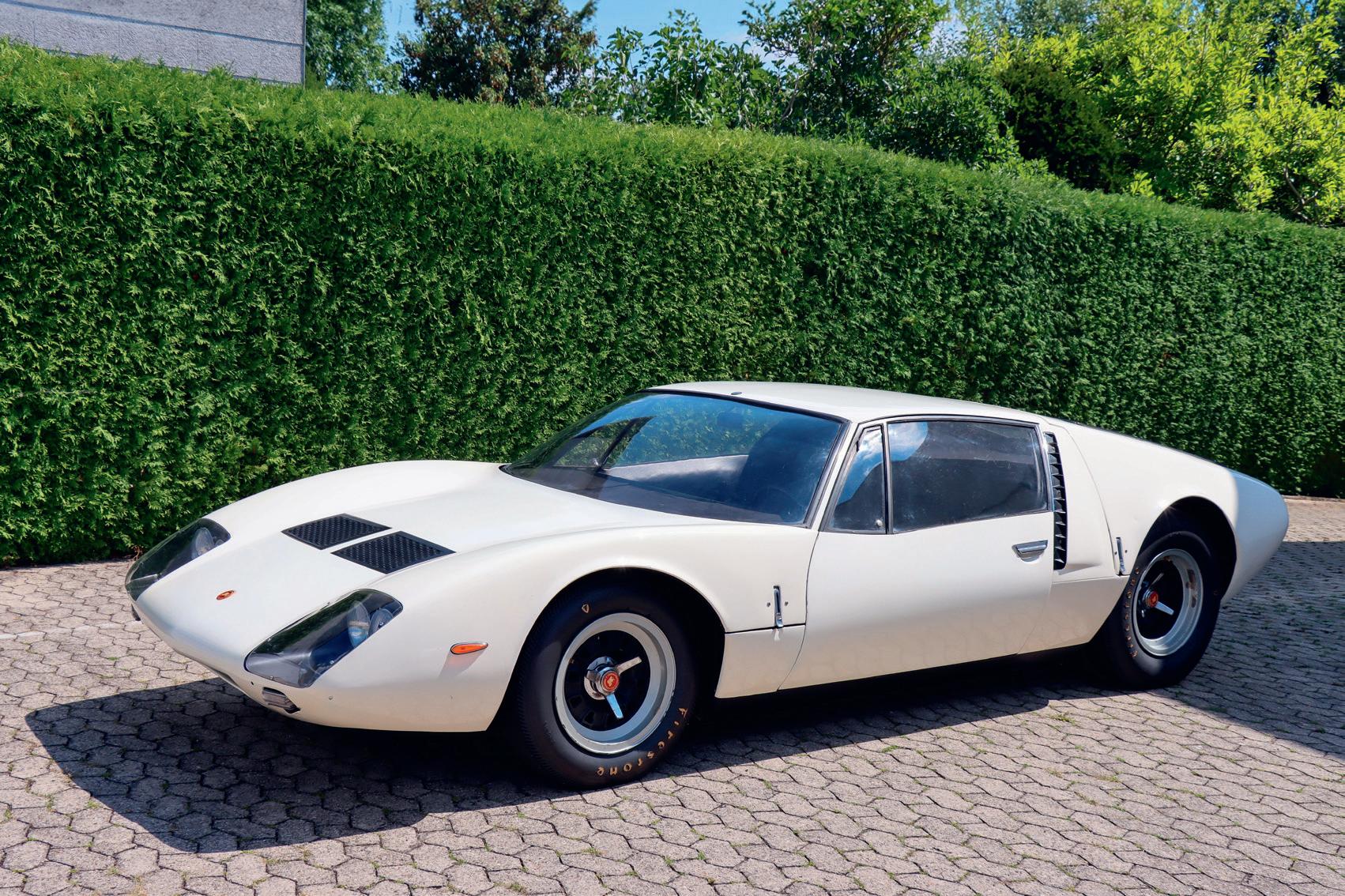
‘The Serenissima Agena remains in original, unrestored condition, and retains all of its authentic parts’
„Der Serenissima befindet sich in einem originalen, urestaurierten Zustand, und behielt alle Original-Teile”
bei der Società Autostar, einer Firma, die ebenfalls Volpi gehörte. Herzstück des Mittelmotor-Coupés ist ein von Alberto Massimino entwickelter 3,5-Liter-DOHC-V8 mit Doppelzündung, nahezu baugleich mit dem V8 für einen Le Mans-Spyder von Serenissima. Aufgrund des finanziellen Drucks, der schließlich zur Schließung der Marke führte, wurde der Agena auf dem venezianischen Landgut des Grafen Volpi eingemottet. Dort blieb er bis 2020, ehe er den Wagen an den heutigen Besitzer verkaufte. Der Agena befindet sich in einem unrestaurierten Originalzustand, und obwohl er mechanisch überholt wurde, um ihn wieder ans Laufen zu bringen, sind alle Original-Teile erhalten geblieben.
Thorough Events would like to thank the following for their invaluable help and support
PRESENTING PARTNER
A. Lange & Söhne
OFFICIAL AUCTION PARTNER
RM Sotheby’s
OFFICIAL CONCOURS VENUE
Gut Kaltenbrunn
OFFICIAL HOSPITALITY PARTNER
Käfer
OFFICIAL HOTEL PARTNER
Althoff Seehotel Überfahrt
OFFICIAL CAR PARTNERS
Brabus
PAL-V
Rimac Automobili
Koenigsegg
SEMCO Cars
Lamborghini Munich
Schaltkulisse
Emil Frey Sportivo GmbH | Official Ferrari Dealer Munich
Porsche Zentrum Inntal
RUF Automobile
ABT Sportsline
Polestar
Dörr Group
DEALER PATRON
Schaltkulisse
OFFICIAL LUXURY PARTNERS
OCC Meissen
Sotheby’s International Realty | Tegernsee AirX
Sportalm The Modelinstitute
Sportalm Lengling
Steinway & Sons
Amalgam Collection
OFFICIAL CHAMPAGNE PARTNER
Laurent-Perrier
MEDIA PARTNERS
Classic Driver
OctaneGermany Magneto BUNTE
OFFICIAL TRANSPORT PARTNER
EM Rogers
OFFICIAL TOUR ENGINEERING PARTNER
Schaltkulisse
BEST OF SHOW AWARD
Sponsored by A. Lange & Söhne
EMERGING COLLECTORS CONCOURS
Sponsored by A. Lange & Söhne
LADIES’ CONCOURS
Presented by The Modelinstitute and Sportalm
JUNIOR CONCOURS
Sponsored by Sotheby’s International Realty | Tegernsee
Organisers
TOUR DIRECTOR
Christian Geistdörfer
HONORARY CONCOURS DIRECTOR
JP Rathgen
ROYAL AMBASSADOR
Leopold Prinz von Bayern
STEERING COMMITTEE
Richard Charlesworth, Chairman of the Steering Committee, Christian Geistdörfer, Jens Rasloff, JP Rathgen, Marcus Görig, Jürgen Ernst, Kevin Braun, Tanja Benedic, Moritz Hardieck, Martin Button, Sandra Button
CONCOURS CURATORS
Vanessa Marçais, Flavien Marçais
THOROUGH EVENTS
James Brooks-Ward, CEO
Sascha Aberle, Project Manager
Bianca Lienau, Client and Marketing Manager
Sonja Hornig, Operations Manager
Gilli Cuthbert, Hospitality Manager
Andrew Evans, Managing Director
Iain Campbell, Director
Alice Young, Account Manager
Rebecca Achenbach, Marketing Co-ordinator
STEWARDS
Bertie Gilbart-Smith, Dan Cogger,
Henry Cundey, Jamie Cundey
Timetable – Concours of Elegance
FRIDAY, JULY 25
CONCOURS PARADE – BEST OF SHOW DAY
10:00 Concours opens to public
10:30 Panel Talk I: The World of Luxury with Sotheby’s Intl. Realty | Tegernsee, RM Sotheby’s & Sotheby’s
10:50 Panel Talk II: Pal-V – Presentation of the Liberty
11:20 Panel Talk III: Allianz Capital & Pension Solutions (Concours Stage)
11:40 Panel Talk IV: OCC & Prof Dr Jochen Buck
12:00 Welcome Speech: Richard Charlesworth & JP Rathgen
12:30-14:30 Lunch in Club Concours & Concours Courtyard Entertainment Programme
13:00 Panel Talk V: The Future of Concours & Classic Car Collecting
14:30-16:30 Best of Show Parade
17:00 Best Car Sound of the Future
17:15 Best Dressed Friday
18:00 Close of event for Friday
SATURDAY, JULY 26
SPECIALIST CONCOURS & DECADE AWARDS DAY
10:00 Concours opens to public
11:00 Emerging Collectors Concours presented by A. Lange & Söhne
11:30 Ladies’ Concours presented with a fashion show by The Modelinstitute & Sportalm
12:00 Junior Concours & Award presented by Sotheby’s International Realty | Tegernsee
12:30-14:30 Lunch in Club Concours & Concours Courtyard Entertainment Programme
13:00 Audience Award Presentation
14:30-15:30 Decades Award Parade
15:45 Best of Show Award presented by A. Lange & Söhne
16:00 Emerging Collectors Award presented by A. Lange & Söhne
16:15 Ladies’ Concours Award
16:30 Best Dressed Saturday
17:00 Concours closes for 2025



























Porsche












